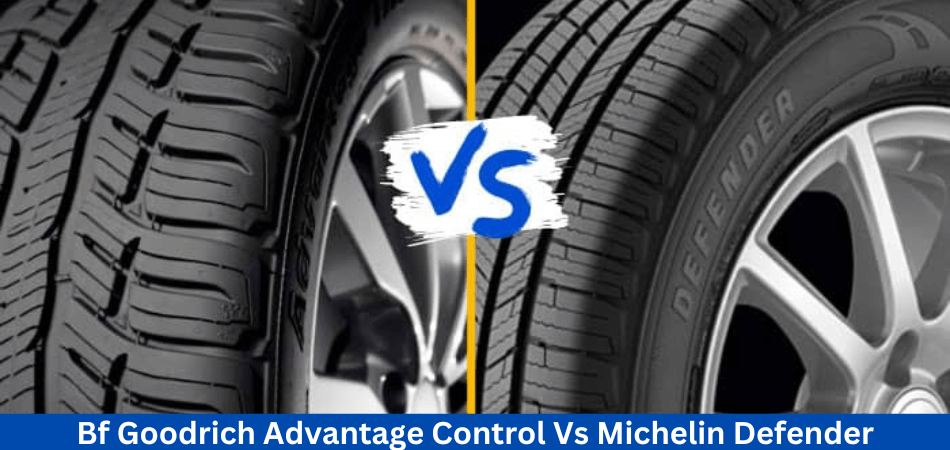
Choosing the right tires for your car is imperative. When it comes to life and death situations, tires can make all the difference. A tire’s traction and grip on various surfaces /must be considered. Additionally, you should consider how durable they are. It can be tricky to choose all-season tires, but your best bet is to choose between Bf Goodrich Advantage Control Vs Michelin Defender.
BF Goodrich Advantage T/A is a grand touring tire that can handle all types of weather, even light snow. Despite having excellent traction in all seasons, this tire offers sporty looks and is suitable for everyday use. A sedan or sporty coupe can use it.
Michelin Defender, its competitor, is also an excellent all-weather tire. The tire is suitable for small crossover vehicles, minivans, and family cars. With this tire, you can ride in comfort even at lower speeds.
There is no question that both tires perform well on most cars, but which is the best? So let’s have a look at the comparison between Bf Goodrich Advantage Control Vs Michelin Defender.
BF Goodrich Advantage Control Overview
All-season tires like these are affordable, durable, and multipurpose. These tires usually have hard compounds that affect performance, ride comfort, and noise reduction. Due to the brand’s research and development, BF Goodrich Advantage Control tires are surprisingly good compared with other tires in this price range.
BF Goodrich claimed these tires would provide “dependable all-season traction”. In addition, these tires promised short braking distances, comfort, quietness, and low noise without compromising the long tread life of the tires.
To accomplish all this, BG Goodrich added silica to the compound used to make the tread. A winter tire with this material provides excellent traction on wet and slick surfaces. As a result, the tread designed to retain its flexibility at both hot and cold temperatures, ensuring excellent traction every time.
These tires have symmetric tread patterns that provide a quiet and comfortable ride, according to the manufacturer. As a result of BFGoodrich’s computer-optimized tread design, BFGoodrich claims a longer tire life with even tread wear.
A high-quality tire with Aqua Flume Technology and G-Wedge stabilizers, able to keep the vehicle steady even when driving fast or braking hard, as well as performing well in wet conditions due to its water displacement design.
BF Goodrich tires reinforced with nylon reinforcements, two-ply polyester casings, and solid steel belts. Learn more at here.
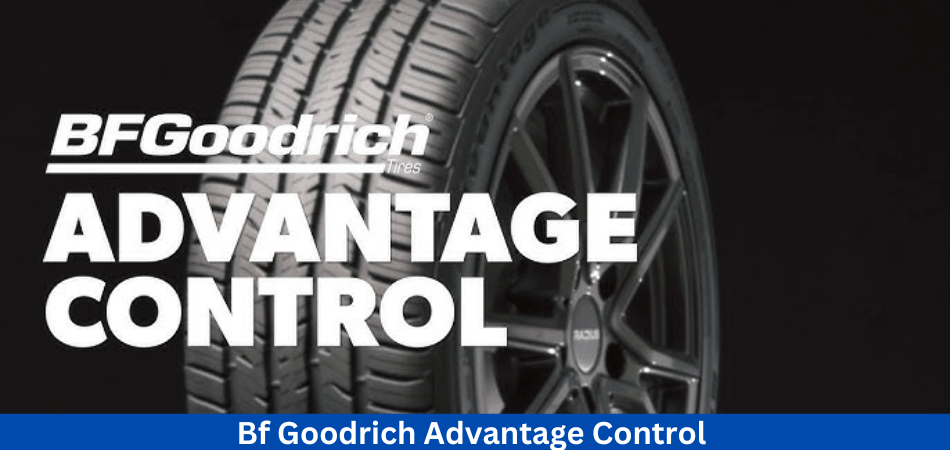
BFGoodrich’s Tire Families
Tire families grouped based on their use cases by BFGoodrich.
1. Advantage
Touring tires are a common sight in the tire industry, and BFGoodrich’s answer is the Advantage family of tires. Providing excellent comfort levels and longer-lasting performance, these tires cover all the bases for what a driver needs all year long.
The options limited, but BFGoodrich designed them to fit a variety of vehicles. You can choose from models like the Control, T/A, and T/A Sport, which offer various features. Some are more refined, while others are a bit more agile. As an all-weather SUV, light truck, and CUV, the T/A Sport comes in an LT variant.
2. g-Force
If G-Force tires offer performance you can count on. With these tires, you will lose out on refinement, but you will get tires that will perform more sportily.
In These tires can only fitted to passenger cars, so CUVs and SUVs are out of luck. There is a summer and an all-season version of the COMP-2. The second one is suitable for use in snow as well as in dry conditions. In dry conditions, the Rival S tire offers even better performance, designed primarily for the track. A Winter model, as you might have guessed, is a winter tire with some performance features.
3. Radial
On On the slightly more affordable end of the performance segment, BFGoodrich has another family of tires you might consider. For those seeking sportier tires, the Radial models are a good choice. This is essentially a middle ground between the g-Force tire and the Advantage tire.
It is also an all-season tire that can only fitted to passenger cars. As for models, there aren’t a lot to choose from. T/A and T/A Spec are two tires, with minor improvements on the second.
4. All-Terrain
After moving away from passenger cars, we come to off-road tires. As you can probably guess from the name, BFGoodrich’s All-Terrain models intended to provide decent performance both on and off the road.
T/A KO2 is the only model in the All-Terrain family, so fitment shouldn’t be an issue. Trail-Terrain T/A also belongs to this family, but doesn’t carry the All-Terrain name. In this tire, you can expect a toned-down performance from the T/A KO2, and the tire is more road-ready.
5. Mud-Terrain
Another tire family that needs no explanation. In terms of off-road performance, BFGoodrich Mud-Terrain tires are the best option. There aren’t a lot of models in this family, but they come in a variety of sizes.
Mud-Terrain is available in two flavors, KM2 and KM3, with KM3 replacing KM2. Despite this, your tires deliver outstanding performance under harsh conditions. In addition, the T/A KM3 is available in a UTV variant.
6. Winter
BFGoodrich also offers dedicated winter tires in addition to the other families on this list. These studless tires offer superior winter performance over all-season or all-weather tires.
The T/A KSI is the only model available. The tire is available in a wide range of options, and it is suitable for all passenger cars. Some CUVs or SUVs may even be able to fit it, considering the options.
7. Commercial
Beware of the name that fools you. A highway tire is for SUVs and light trucks in the Commercial group, as they cover the touring segment of the larger vehicles. The same applies to commercial vehicles if the size is correct.
The T/A All-Season 2 is the only model currently available. With a well-refined and long-lasting all-season tire, you can use it in snowy conditions.
Michelin Defender Overview
There was an asymmetric tread pattern on the previous version of Defender2 tires (T+H). Michelin returned to the classic symmetrical design used on most all-season, multipurpose tires. This model features deeper grooves on the tread surface to improve grip on a variety of surfaces. Moreover, the new tread design eliminates water more efficiently, providing better traction in wet weather.
Additionally, the compound has updated with a good amount of silica to provide great traction in all conditions.
With this model, Michelin improved the performance and comfort without sacrificing strength. There are more biting edges on the tire’s sipe blocks, increasing traction and stability. Michelin’s SipeLock technology has used to design the sipe blocks. Thus, they linked, creating a network that reduces noise and vibration caused by tire friction with the road. Using Michelin’s patented PIANO technology (Pressure Influence on Acoustic Noise Optimization), this model designed to reduce noise from pressure changes.
The Michelin tire familyreinforced double steel belt as their BF Goodrich counterparts, covered by polyamide, making them safe and durable even when driving at high speed.
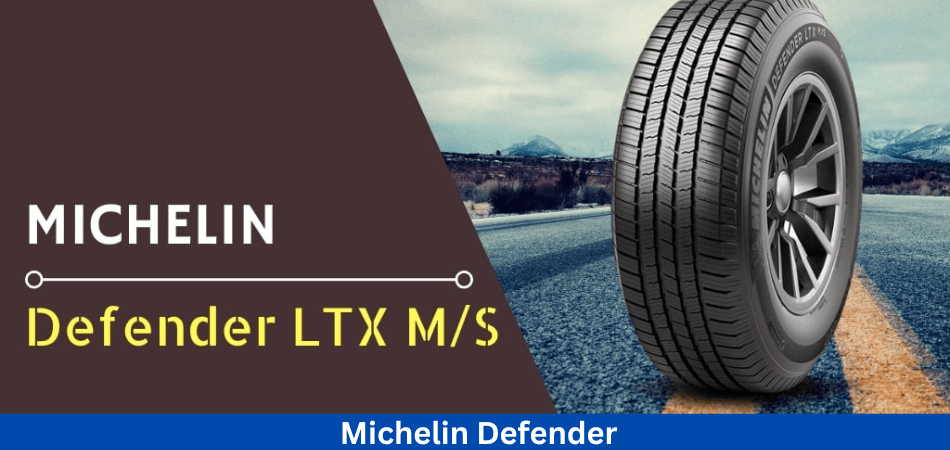
Michelin’s Tire Families
On the grouping side of things, Michelin has a pretty standard set of features for each tire family.
1. Pilot
These are the tires you’d buy if you’re willing to sacrifice a little refinement for the best possible performance. There are some decently comfortable options among these models, so not every one is harsh.
Sport All-Season 4, Sport 4s, and Alpin 5 are Michelin passenger car tires that cover all three weather conditions. SUV badges can also found on the same models, covering that market segment as well. There is also the Diamaris model in this group of cars. Michelin offers the Pilot MXM4, which provides excellent grip and traction without being harsh.
2. Primacy
Our next offering is Michelin’s best touring family of tires – Primacy. A well-refined tire with the latest and best technologies, these tires can offer decent performance.
This family of tires includes models like the Tour A/S, LTX, and XS, which designed to fit everything from small economy cars to larger SUVs. In addition to these models, there are others that are summer models, such as the MXM4 and MXV4. HP and Primacy 3 are the only two sizes available for passenger cars under those conditions.
3. Premier
In many ways, the Premier family of tires is similar to the Primacy family. You should be able to find a tire that fits your vehicle thanks to the wide range of sizes available.
Both the A/S and LTX are all-season models. One is for passenger cars, and the other is for CUVs and SUVs. These tour tires aim to offer a well-refined feel and a relatively long lifespan.
4. Latitude
One of Michelin’s families, the Latitude, designed specifically for specific vehicles. Its best feature is that it covers multiple weather conditions, each with its own features and driving characteristics.
Michelin offered three major Latitude models: Tour, Alpin, and Sport, designed as all-seasons, winter tires, and summer tires, respectively. For people with SUVs and CUVs, the Latitude offers several additional models.
5. X-Ice
It’s not impossible to drive in the winter, but you need proper tires to do so. In addition to the winter options within the other Michelin families, there is one specifically designed for these conditions. In addition to passenger cars, the X-Ice family also offers SUVs.
There are non-studdable models in the X-Ice lineup, including the Snow, Xi2, and Xi3. Snow SUV is also available for SUV owners, covering that segment as well. The North can provide extra performance on ice in some cases. In addition to passenger cars, Michelin also offers studdable tires for CUVs and SUVs.
6. Defender
In terms of its family of cars, Michelin known for making some overlaps, and the Defender is a good example of this. The manufacturer of these tires aims for longevity and refinement. This isn’t too different from some of the others on this list, but the technologies and some features aren’t the same.
Defender’s lineup consists of only two models: T+H and LTX M/S. First, you can choose from passenger cars to SUVs, while second, you can choose bigger vehicles, including light trucks. Within these two models, there are some overlaps, especially in terms of sizes for CUVs.
7. Energy
Several premium brands offer some models at a slightly more affordable price, and Michelin is no exception. Despite not being able to compete with the big players, these touring tires designed to compete with other midrange brands.
Energy tires come in two variants, the LX4 and Saver. The LX4 is available both as a summer tire and an all-season tire. Michelin aimed to offer a wide range of applications, including smaller models for older cars.
8. CrossClimate
The CrossClimate is one of Michelin’s many new models or improvements. In the all-season grand touring segment, Michelin’s latest addition has proven very strong so far.
It’s hard to find the original CrossClimate model nowadays, which isn’t surprising. You’re looking at some of the best grand touring tires with the CrossClimate+ and CrossClimate 2. A wide range of applications is also possible with these models due to their wide range of sizes.
9. LTX
Last but not least is the LTX family. The previous families of Michelin have some LTX models. However, the manufacturer went with entirely new models. Depending on your needs, there are two models to choose from, ranging from CUVs to light trucks.
In both on- and off-road conditions, Michelin offers the A/T2, an all-terrain tire capable of decent off-road performance without a lot of drawbacks. M/S2 tires are essentially touring tires if you don’t take your SUV or light truck off-road. Regardless of the model you choose, the tires you’ll get will be all-season.
Bf Goodrich Advantage Control Vs Michelin Defender: Tire Line
1. BF Goodrich Advantage Control Tire Line
The BFGoodrich Advantage Control Tire provides a quiet ride for drivers. BF This model introduced by Goodrich in 2021 to offer consumers better materials and technology than its competitors.
To improve tire grip on wet paved roads and other difficult driving conditions, silica and other compounds added. These tires also feature BF Goodrich’s patented Aqua-Flume Technology, which enhances wet performance even further.
On the thread pattern, this technology consists of contoured grooves. By evacuating water from the tire’s contact patch, these grooves help reduce hydroplaning and improve traction and stability in wet weather.
Additionally, the tires have sidewall stabilizers to improve ride quality and control. Moreover, the American tire manufacturer, now part of Michelin’s conglomerate, developed these tires to be silent and long-lasting.
2. Michelin Defender Tire Line
There is a new version of the Michelin Defender which replaces the Michelin Defender T+H that is being discontinued. It isn’t common for Michelin to discontinue tires overnight; they keep making old models for a while to allow users to get replacements without hassle.
Therefore, the old Defender T+H will take a while to disappear from the market. As long-lasting tires with Michelin’s quality seal, the T+H, Defender designed to provide efficient traction in all weather conditions, including some snow. In addition to their circumferential grooves, they have great wet handling, similar to their BF Goodrich counterparts.
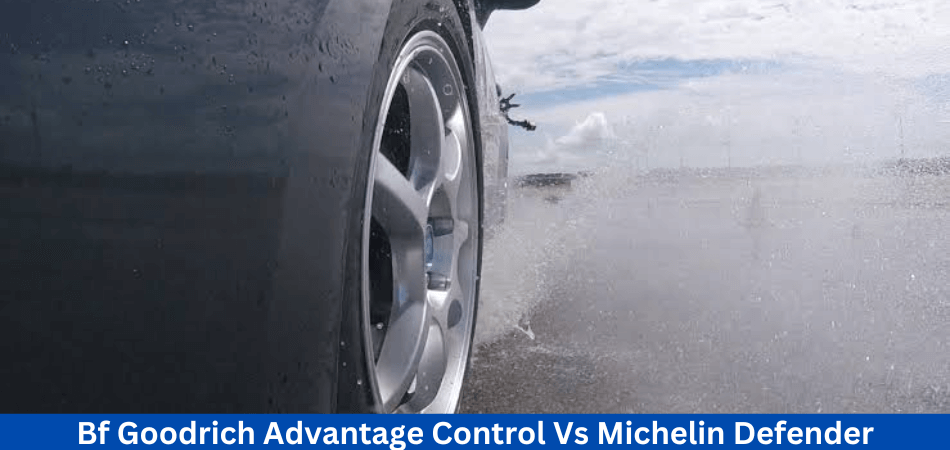
Bf Goodrich Advantage Control Vs Michelin Defender: Performance Comparison
BF Goodrich Advantage Control Performance
1. Dry Performance
The hardness of all-season tires makes them lose grip compared with summer or high-performance tires. Due to its tread design and numerous notches, the BF Goodrich Advantage Control provides excellent traction.
With their stiff sidewalls fitted with g-wedge stabilizers and good braking performance on hot, dry pavement, these tires provide good performance on dry roads. Their tread design makes them safe to drive at high speeds, keeping the vehicle in contact with the road at all times.
2. Wet Performance
With their silica-rich compound and Aqua-Flume Technology, these tires perform well on wet surfaces. Compared to tires of the same and higher tiers, these tires have one of the shortest wet braking distances and no aquaplaning issues. Water evacuated very efficiently, ensuring that the tread is in constant contact with the road. As long as you drive safely and don’t drive too fast, these tires have an excellent performance under heavy rain.
3. Snow Performance
In light snow, these tires offer decent traction, like most models in their category. Almost as well as these tires perform on wet roads, mild snowy roads have similar friction coefficients.
If you have to drive on frozen roads or in areas with deep snow and extreme temperatures, you should use snow chains or winter tires. The tires on this model weren’t created for use in such conditions, and riding your vehicle with them is dangerous.
4. Comfort and Noise
They provide good ride quality considering they are all-season tires. These tires absorb most road imperfections and slight bumps, even when they don’t have the outstanding ride quality of grand touring tires. Also, these tires scored a 10/10 on NVH (Noise Vibration Hardness) tests, meaning they are extremely quiet, which makes riding even more pleasant. They provide a comfortable and pleasant ride without breaking the bank.
Pros And Cons of BF Goodrich Advantage Control
Pros
- Wet traction, handling, and braking are outstanding.
- Performance on dry surfaces is good.
- A tough and durable material.
- An affordable price.
- The ride is smooth and quiet.
Cons
- Ice and heavy snow are not suitable for this product.
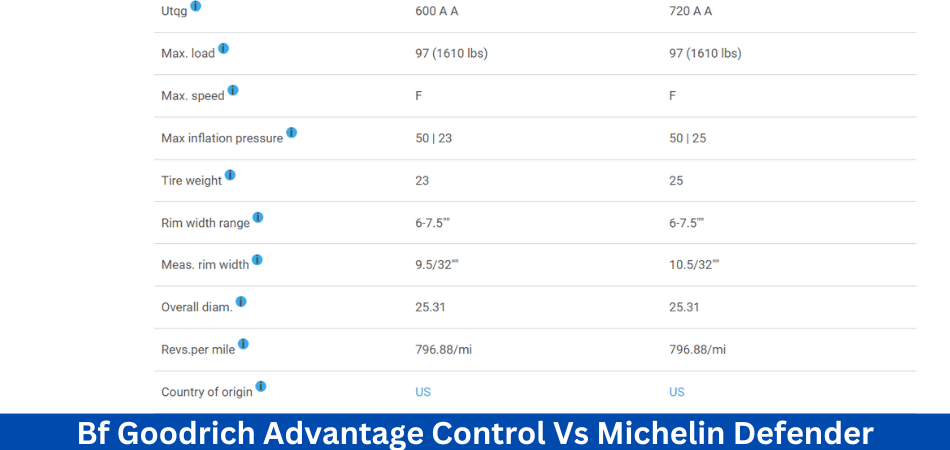
Michelin Defender Performance
1. Dry Performance
Tires of this type perform well in dry conditions. At low and medium speeds, they behave like tires of superior quality. For example, when the vehicle is traveling at high speeds on the highway, it behaves superbly when cornering. All-season tires have surprisingly short dry braking distances.
Generally, these tires perform better on dry surfaces than BF Goodrich Advantage Controls.
2. Wet Performance
Michelin Defender offers excellent wet performance and excellent aquaplaning resistance. When cornering at reasonable speeds, they provide excellent grip because of their short braking distances. Despite flooded surfaces or heavy rain, they provide excellent handling.
3. Snow Performance
The performance of these tires is not as good as those of BF Goodrich. For mildly snow-covered roads, they are fine, but not for extremely frozen or thickly snowed surfaces.
4. Comfort and Noise
It is no secret that Michelin products are well-known for their riding comfort and quietness, and the Defender is no exception. Whether on smooth paved highways or gravel secondary roads, the ride quality and road noise are superb.
Pros and Cons of Michelin Defender
Pros
- In wet conditions, the vehicle offers exceptional handling, traction, and braking.
- Exceptional performance on dry surfaces.
- A smooth and quiet ride.
- A tough and durable material.
- This warranty applies.
Cons
- It is not suitable for heavy snow or ice.
- It’s expensive.
Bf Goodrich Advantage Control Vs Michelin Defender: Available Options
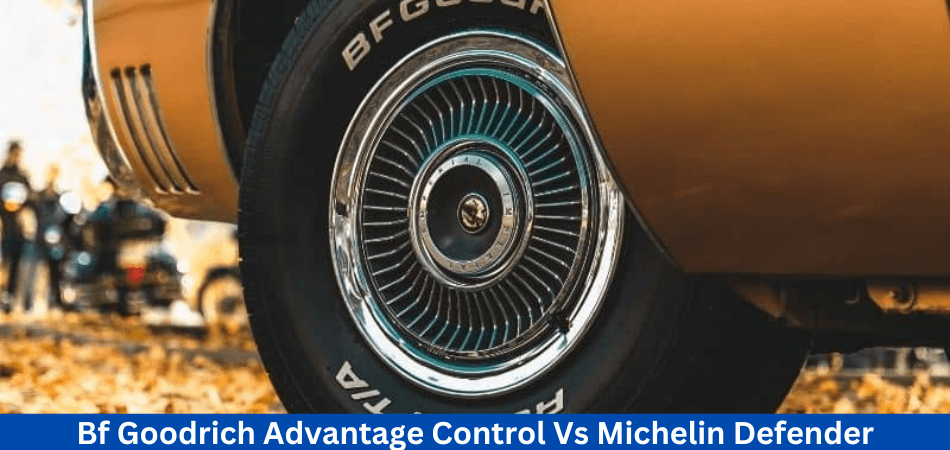
You’ll be able to tell which brand offers more options just by looking at the number of families. There is no doubt that Michelin is the more flexible option when comparing tire families with similar categories.
In both the touring and performance segments, BFGoodrich lacks options. Despite covering a wide range of applications, Michelin has multiple models, so there are more options available. It is even possible to choose between different tire models with similar features from different families.
In the same way, there are different types of vehicles. Michelin, for example, has more touring options than BFGoodrich does for CUVs and SUVs. The same is true for track-oriented or performance tires, where you have a lot more flexibility.
Michelin only has one model in this category, so things favor BFGoodrich in all-terrain. However, BFGoodrich is a much better choice in mud-terrain tires because Michelin does not have tires designed for the most extreme off-road conditions.
Bf Goodrich Advantage Control Vs Michelin Defender: Available Sizes
BF As for Goodrich’s Advantage Control tires, they come in sizes ranging from 185/65 R14 to 245/50 R20, while Michelin’s Defender tires come in sizes ranging from 2-5/55 R16 to 245/50 R20. In comparison to Michelin, BF Goodrich offers a greater variety of sizes and styles.
Bf Goodrich Advantage Control Vs Michelin Defender: Price
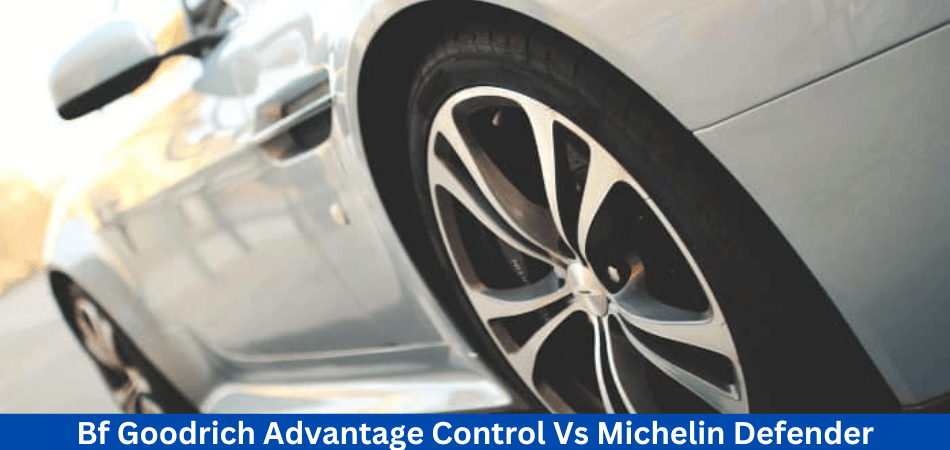
Despite the relatively small performance differences, there may be some price differences that are noticeable. For example, the g-Force COMP-2 A/S Plus and the Pilot Sport All-Season 4. There is a difference of around $30 between BFGoodrich’s 17-inch model and a 17-inch model of similar size. Michelin’s model has a lower speed rating, which is very important to note.
In the grand touring all-season segment, the CrossClimate 2 and Advantage Control have similar differences. As the Michelin has a higher speed rating, they are technically more comparable. For a 16-inch tire, the BFGoodrich option is around $40 cheaper for the CrossClimate SUV than the Advantage T/A Sport LT.
A/T 2 comes in around $30 more expensive than All-Terrain T/A KO2 in the all-terrain segment. 16-inch models have the same load ratings, but Michelins have a lower maximum speed rating.
Bf Goodrich Advantage Control Vs Michelin Defender: Warranty
The Michelin tire warranty isn’t the longest, but in this comparison, it does seem to be better in some cases. Consider the all-terrain options I mentioned earlier. Michelin’s treadwear warranty is 60,000 miles, while BFGoodrich’s is 50,000.
Some mixed results reported for grand touring all-season models. As with most of their rivals, the CrossClimate 2, Advantage T/A, and T/A Sport all come with a 60,000-mile treadwear warranty. However, the Advantage Control offers a 5,000-mile warranty extension.
When it comes to grand touring SUVs, BFGoodrich is the better choice. As compared to the Advantage T/A Sport LT, the CrossClimate SUV has a treadwear warranty of 50,000 miles.
Which brand to choose: Bf Goodrich Advantage Control Vs Michelin Defender
Choosing a better brand isn’t as easy as it sounds. Numerous models exist, and not all have the same performance difference to make one better than the other.
If you look at the available options and the performance that Michelin tires can offer, it is generally a better brand. In spite of their higher price, these tires will perform better than BFGoodrich’s, especially at the limit. In some conditions, the US manufacturer’s models can perform better, but overall, it’s the French model that wins.
However, this doesn’t make BFGoodrich a bad option by any means. While its models aren’t as extensive as Michelin’s, it can still compete in the premium segment with the rest of them. Best of all, you can sometimes pay less for a tire that offers a bit more in some areas, like warranty. In terms of performance, it’s either on par with Michelin or a bit behind.
Off-road tires are one area where BFGoodrich excels. First of all, Michelin doesn’t have a lot of these, and the ones it has aren’t as good as those from BFGoodrich, especially when it comes to off-roading.
Ultimately, Michelin tires are a great option if you’re looking for excellent road-going tires and price isn’t an issue. Considering that most people won’t drive their cars to their absolute limit, these are the things they might miss.
People who need tires with good performance but aren’t looking to overspend can opt for BFGoodrich, which is the more budget-friendly option. As a result, you will save some money and get a good set of tires.
Conclusion
There’s no doubt that both Goodrich and Michelin models designed using cutting-edge technologies. Taking a look at the performance chart, they are neck and neck in every category.
According to their performance chart, similar behavior, and treadwear warranties, there is no clear winner. Ultimately, it comes down to personal preference. In addition, there is no significant price difference; however, if you are able to pay an additional 14%, you could get a product made by one of the world’s top tire manufacturers with some of their top-notch and more expensive features.
Read more of our articles here.
FAQs
Do the Michelin Defender or the BF Goodrich Advantage Control perform better in wet weather?
Due to its silica-based rubber compound and unique tread pattern, the Michelin Defender provides exceptional wet weather traction and hydroplaning resistance.
Do either of these tires perform well in winter conditions?
Its better snow and ice performance makes the Michelin Defender a better winter tire than the BF Goodrich Advantage Control. Winter tires, however, should used in severe weather conditions.
What is the tread life warranty on these tires?
Both the BF Goodrich Advantage Control and Michelin Defender have treadwear warranties. Depending on the model and tire size, the warranty length may vary, so it is important to check with the manufacturer or retailer.
What tire offers the best ride comfort and quietness?
Michelin Defender tires boast superior noise-reduction technology, which makes them slightly quieter and smoother than the Michelin Defender tires.
Are these tires designed for passenger cars or SUVs and trucks?
Both BF Goodrich Advantage Control and Michelin Defender offer options for SUVs, trucks, and passenger cars. A wide range of vehicle sizes are available.
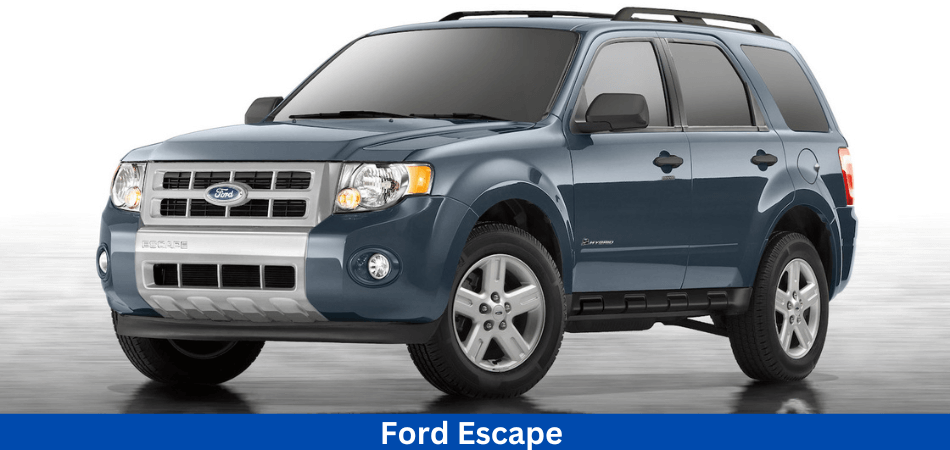
The Ford Escape has gone through four generations over the past year. Founded in 2001, they manufacture Escape SUVs to this day. 2001 marked the launch of the first-generation Escape. After that, they launched their second, third, and fourth generations of Escape SUVs in 2008, 2013, and 2020, respectively. But how is the Ford Escape hybrid battery replacement cost?
Ford Escapes use different types of hybrid batteries. Depending on the model and quality of your vehicle, the price will vary. In general, the Ford Escape hybrid battery replacement costs you between 2500$ and 5000$ and labor will cost you between 300$ and 400$. So, to replace your Ford Escape hybrid battery, you will have to pay between 3000 and 5500 dollars.
As you all know, batteries do not last for eternity and they did not use the same type for these vehicles. Your battery can fail for a variety of reasons. Therefore, you might need to replace your battery. For the hybrid Escape, buyers often have difficulty choosing the perfect battery. So in this article, we will cover everything about the Ford Escape hybrid battery replacement cost. Let’s get started.
What is the Difference Between Hybrid and Normal Car Batteries?
The engine and electronics of all vehicles are powered by batteries.
A hybrid car battery is larger, more powerful, and more expensive than a lead-acid battery. Hybrid cars use them to power electric motors.
Most people are familiar with lead-acid batteries, the types used to jump-start cars and which can cost between $120 and $200 to replace. It is usually necessary to replace these batteries every three to five years. Learn more about hybrid car battery here.
How to Tell if Your Hybrid Battery Needs to be Replaced?
There are a number of signs that your hybrid battery is failing, including:
- There is a reduction in fuel economy. In the event that the battery is not providing enough power to the electric motors, you will need more fuel.
- Increasing the use of internal combustion engines. Whenever your engine starts up more frequently than usual, it might be compensating for a dying battery that’s not delivering enough power.
- Battery life is shorter. If your battery drains rapidly, you might need to replace it.
- Performance decreased. When the battery is dying, some drivers notice that their car is not running as well.
- Problems with electrical power. Your battery isn’t functioning properly if you have electrical problems, especially with the electric motors.
- The car will not start. A dead battery will prevent your hybrid from starting or driving.
What are the Common Reasons Behind Escape Hybrid Battery Failure?
For your hybrid battery to last longer, you need to take good care of it. There are a few major issues you need to know about. Hybrid battery failure is mainly caused by:
- Batteries that are old
- An issue with the battery’s voltage
- Battery acid problem
- Maintaining low battery charge continuously
- Long-term inactivity of the battery
- Excessive use of vehicle electrical features
- In the absence of proper cleaning, debris can damage the battery
- An overuse of the battery
- Battery not connected properly to vehicle
These are the main reasons why your battery may not last as long as it should. To easily avoid this mess, you should follow the instructions carefully for the battery. To solve the problem easily, you should also buy high-quality batteries.
What are the Factors Influencing the Ford Escape Hybrid Battery Replacement Cost?
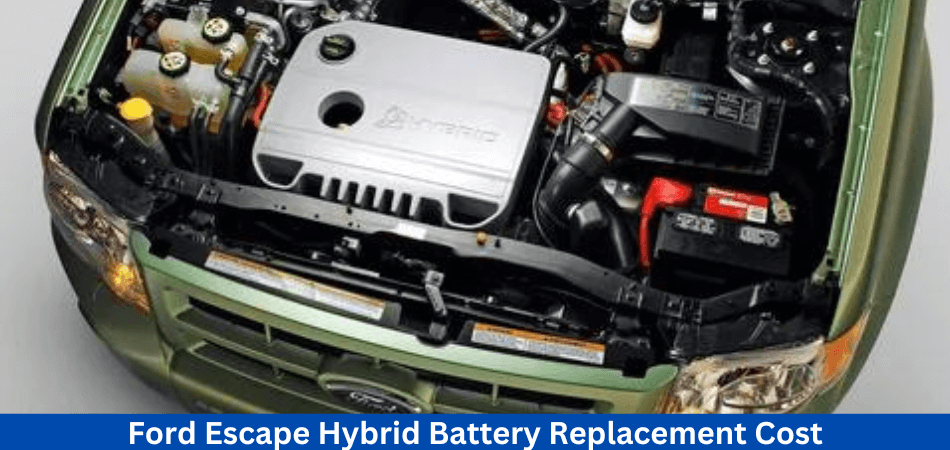
1. Making and Model Impact on Hybrid Battery Replacement
The cost of replacing a hybrid battery varies significantly depending on the car’s make and model. Hybrid batteries for Toyota Prius cars can cost around $3,800, while Ford Escape batteries can cost up to $8,500. A popular model like the Prius is often available at a lower cost due to its widespread availability. It may cost more to repair less common models, though, since they require specialized parts or labour.
2. Hybrid Battery Costs Between New and Used
Hybrid batteries typically come with a manufacturer’s warranty, which can provide peace of mind but can also add to the cost. The cost of a new hybrid battery can range from $1,000 to $8,000. If this price seems steep, consider purchasing a used or refurbished hybrid battery. Typically, these have a short lifespan, but if you’re planning to sell the car soon or if it’s an older model, you might consider them.
3. Additional Costs Involved in Hybrid Battery Replacement
A battery replacement typically costs between $500 and $2,000, depending on the mechanic or dealership. The availability of parts may make older hybrid cars require more expensive batteries. Besides hybrid battery replacements, other components may also need to be replaced if they fail.
What are the Prices Of Different Types Of Escape Hybrid Batteries?
Ford has experienced some battery problems with its Escape models over the years. Due to this, they continued to upgrade the quality of their hybrid batteries. As a result, Escape hybrid batteries are not priced the same. The following are the prices and lists of Escape hybrid batteries:
Ford received complaints regarding the batteries of the first Escape vehicles because of these problems. In order to improve the battery’s outer structure, they made improvements to the jacket’s body. Consequently, their batteries have become more efficient in the latest edition.
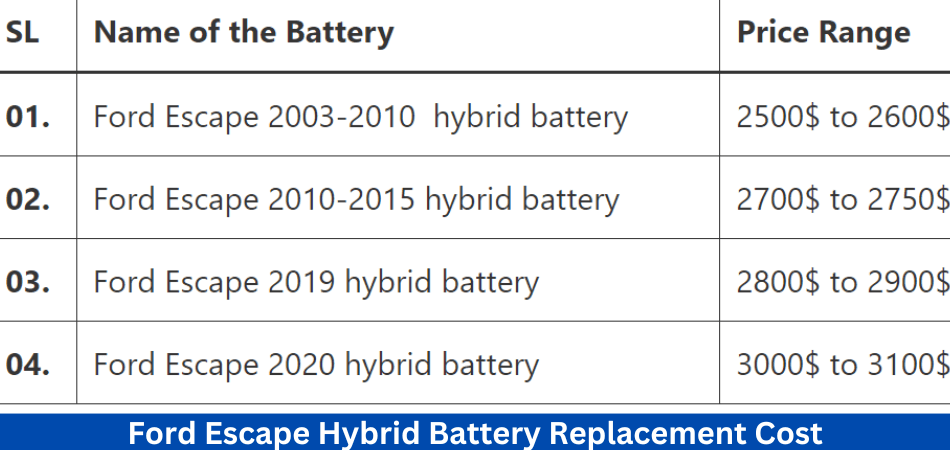
What is the Cost of a Used Hybrid Battery?
Battery replacement in an Escape Hybrid is quite expensive. According to the report, it costs $6,900, which seems high compared to the price of a replacement hybrid battery for a Prius. However, that quote was being used to bash hybrids. In some cases, the Ford Escape hybrid battery replacement cost can be less expensive.
Model year and region affect the price of Ford Escape Hybrid battery replacement. As a result, it is a good investment because the battery has a lifespan of up to ten years. If you want to save money, consider purchasing a used Escape Hybrid. It is possible to buy a used car for as little as $12,000, which makes the battery replacement even more affordable. You should consider replacing your Ford Escape Hybrid battery with a used one to extend the life of your hybrid car.
The cost of a new battery, including installation, can reach $2,500. Nevertheless, refurbished batteries cost between $1,000 and $1,400 plus installation. Be aware that you’ll have to pay a core fee if you purchase a new battery.
There is a difference in price between different types of hybrid batteries. Hybrid batteries can last as long as 150,000 miles with proper maintenance. The majority of drivers sell their vehicles before they need to replace their batteries. Batteries also have a shorter lifespan in extreme cold and heat. It is possible for the hybrid system itself to fail in rare cases. On your vehicle, you’ll notice a warning system if that happens.
The Ford Motor Company is not the only automaker to issue recalls. It is common for their competitors to wait until the problem becomes problematic before issuing a recall.
What is the Ford Escape Hybrid Battery Replacement Cost?
Ford Escape Hybrid batteries designed to last 100,000 miles. A regenerative braking system recharges the battery. A battery replacement may be necessary, however, if a battery fails. Slow starts, dim lights, or a low charge are symptoms of a failing hybrid battery.
A hybrid vehicle’s battery is one of its most important parts, so replacing it is imperative. It depends on the model year and region of your car how much the replacement will cost. The cost of replacing the battery on a Ford Escape Hybrid generally ranges from $2000 to $3000. In any case, if it extends the life of your vehicle, the battery replacement will be well worth it.
Ford Escape hybrid battery replacement cost vary depending on your vehicle’s make and model. Used or refurbished hybrid batteries are cheap replacement options. There are many ways to save money by using these. Battery prices can range from $500 to $3500, and used batteries are better than new ones.
While the Ford Escape Hybrid has reported a few problems, you should avoid aggressive driving, which can wear out parts more quickly. Compared to a model that’s less than ten years old, a Ford Escape Hybrid with more than 100,000 miles is more likely to have unexpected maintenance issues.
A new battery can cost up to $2,500 if it’s not refurbished. Depending on the model, you may have to pay installation as well. If you compare insurance rates with a service like Jerry, you can also save money.
The Ford Escape Hybrid powered by a 2.5-liter hybrid engine. A sudden death of the battery can result in a crash. The sooner you find a qualified technician, the better. Changing the battery on a Ford Escape Hybrid may require you to visit a Ford dealer.
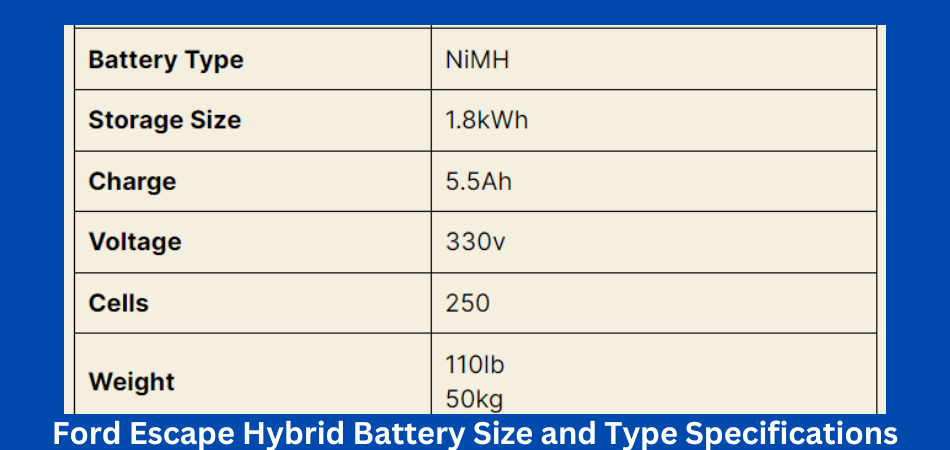
How to Save Money When Replacing Ford Escape Hybrid Battery?
You will have to spend a lot of money to replace your hybrid battery. However, there are some ways you might be able to save, including:
Make sure you know what your warranty covers. Batteries covered by the manufacturer’s warranty on most hybrids. Even if you buy a used car, these warranties may cover the battery replacement.
You can shop aftermarket. Batteries purchased aftermarket are often less expensive than those purchased directly from the manufacturer.
You might want to consider a refurbished or used battery. In comparison with buying a new battery, you can save thousands of dollars by using these batteries. Aside from being environmentally friendly, they often come with a warranty as well.
You can choose to replace part of it. In some cases you can replace one of the smaller batteries (known as a cell) rather than replacing the entire battery pack since large batteries made from smaller batteries connected together.
Find a good laborer by shopping around. As hybrid batteries have a high voltage, they should always replaced by a professional. Getting quotes from three or more installers can still save you money on installation.
Installation Procedure Of A Ford Escape Hybrid Battery
Your hybrid engine can be easily installed on the vehicle by yourself. The matter should handled by an expert if you do not have experience in it. There are some local workshops that offer free installation if you purchase a battery from them. Let’s examine how a Ford Escape hybrid battery installed-
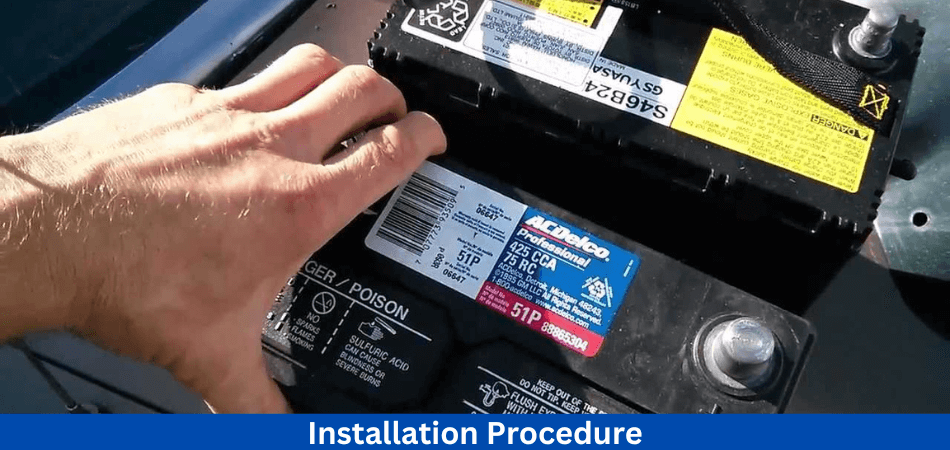
- The first step is to turn off the electrical switch and carefully remove the battery from the compartment.
- After removing the bolts and the contactor, you can open the compartment. Since the contactor is very fragile, you must be very careful.
- You will then need to locate the contactor assembly and carefully remove it from the socket.
- To connect your contactor assembly, you need to know the color codes.
- Put the new battery in the compartment and reconnect the wires to the contactor.
- Finally, you can turn on the battery and charge it.
Health Test Process Of A Ford Escape Hybrid Battery
Despite hybrid batteries being powerful and efficient, you should test their health periodically to avoid any unexpected problems. To do that, follow these steps:
- The first step is to turn on the power button and click on the battery check option.
- You’ll see the voltage counter on the screen after pressing the brake and hitting the power button.
- As long as the voltage is around 14, the battery is in good health, and if it is around 13, it needs to charge.
- In some cases, the voltage can drop a little bit while driving, which is not a problem.
- You should not drive your vehicle if the voltage is less than 13.
What is the Lifespan of a Ford Escape Hybrid Battery?
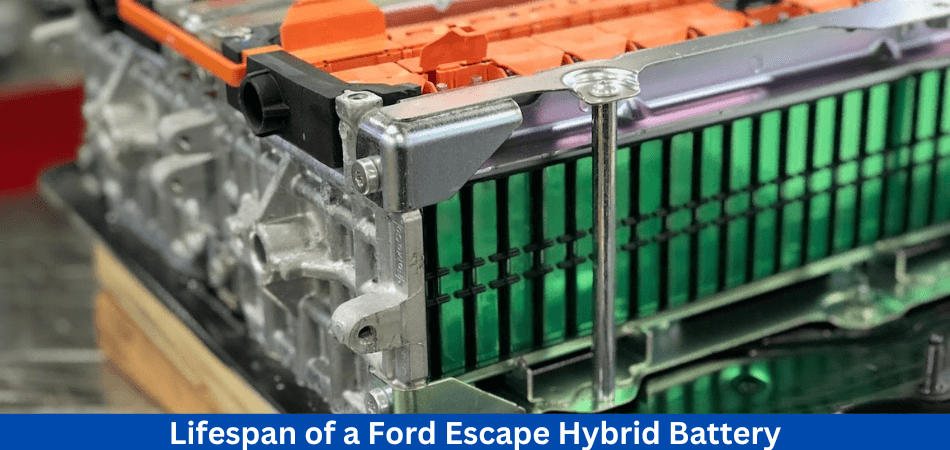
Depending on the model and year of the Ford Escape hybrid, the battery can last for ten years. Battery failure can occur even in these vehicles. When your hybrid vehicle experiences problems such as slow starts or dim lighting, it may need a replacement. Changing your hybrid’s battery can extend its life significantly.
The cost of replacing a hybrid battery is high, however. There are often used batteries found in crashed cars that may be of interest to you. In spite of their lower cost, these batteries do not have the same lifespan as newer ones. In addition, extreme temperatures can shorten the life of a hybrid battery.
If you maintain your Ford Escape hybrid properly, it can last for up to 10 years or 200,000 miles. Changing your battery pack every three years recommend, as is checking your brake pads frequently. If you live in an area where rust is common, you may have to replace your brake rotors more often.
Reliability is an excellent attribute of the Ford Escape hybrid. There have been three generations of hybrids since 2005, when the first generation introduced. Older models have accumulated enough miles to show their weaknesses, but the new generation has relatively few issues. Because of this, Ford recommends that hybrids maintained on a regular basis.
A There should be a range of 30,000 to 60,000 miles between the Ford Escape hybrid battery and the car. The exact mileage and riding habits of each individual should considered, however. It recommended that a hybrid vehicle inspected every fifteen to twenty thousand miles, while the battery pack should last up to 60,000 miles.
How Do I Know My Ford Escape’s Battery is Dying?
Several signs will indicate that your battery needs replacing before it dies completely, such as:
- Fuel economy is getting worse for you.
- The battery in your vehicle is not holding a charge or is charging erratically.
- There is something wrong with your engine if it starts when it shouldn’t or runs too long.
- There is a strange noise coming from the engine.
Come to Fairfield Ford to have your Escape Hybrid’s battery tested if any of these signs occur.
Is it Possible to Replace a Ford Escape Hybrid battery on Your Own?
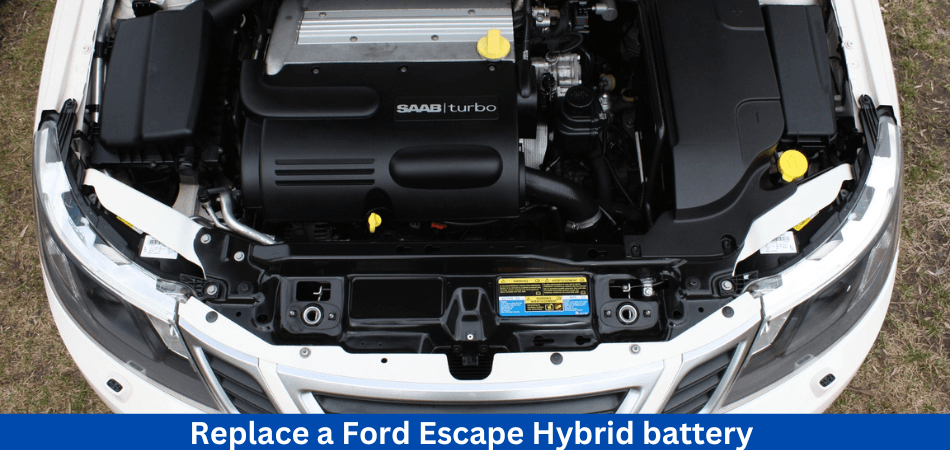
If you don’t have the right training and expertise, changing your Escape’s hybrid battery yourself can be extremely dangerous. You would be putting yourself at risk if anything went wrong with the battery, which is a high-voltage component.
It is also possible that you could cause major damage to your Escape, which could lead to much more expensive repairs than if you had a dealership replace the battery for you. A Ford service center such as Fairfield Ford should replace the battery because their technicians are highly trained and experienced. Using state-of-the-art diagnostic equipment, our technicians can perform the work safely and efficiently.
How Far Can a Ford Escape Hybrid Drive on Battery Power?
A Ford Escape PHEV can travel 37 miles in all-electric mode before switching to gasoline. Regenerative braking and the engine will provide some charge back to the battery, but the battery will need to be fully recharged at the next opportunity.
It takes about 10 to 12 hours for a Level 1 charger to fully recharge a battery. With a 240-volt Level 2 charger, the charging time reduced to 3.5 to 4.5 hours. Unlike other hybrid vehicles, the Escape Hybrid combines the power of the engine and electric motor.
What can You do to Extend the Life of Your Ford Escape Hybrid Battery?
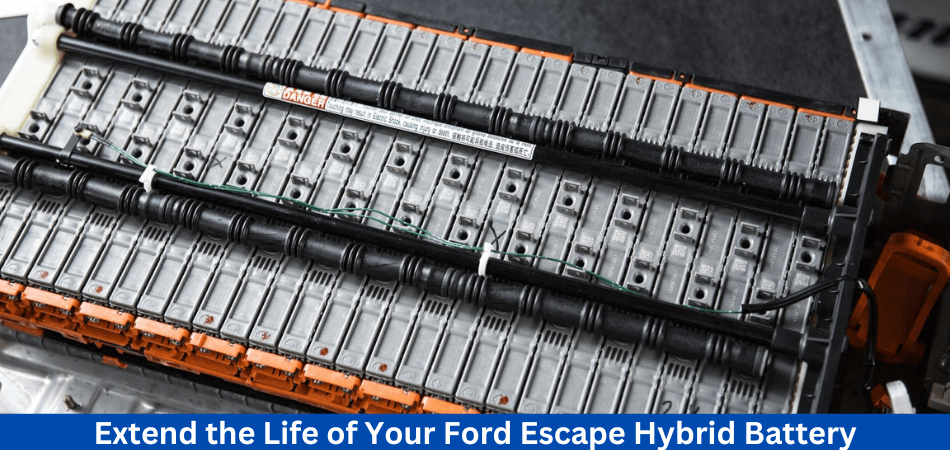
If you want to extend the life of the hybrid battery in your new Ford, there are two simple things you can do:
Slow Down- This involves coasting to a stop instead of coming to a hard halt. What are the benefits of this for your hybrid battery? The kinetic energy generated by coasting actually charges your battery, extending its lifespan.
Slow Up – Similarly, avoid accelerating quickly to prevent your battery from degrading. As you’ve probably noticed, hybrid vehicles shut off their gas engines when they reach a complete stop. When the stoplight turns green and you’re ready to go, accelerating gently will keep your vehicle in all-electric mode, which helps cycle the battery and increase fuel economy.
Take it slow now that you know!
Final Thought: Ford Escape hybrid battery replacement cost
Based on various factors, such as the model year, warranty coverage, and whether you choose a brand-new battery or a refurbished one, you can expect the Ford Escape hybrid battery replacement cost to vary significantly. Buying a new battery can cost anywhere from $2,000 to $5,000 or more, but refurbished batteries may be more affordable.
To make an informed decision that fits their budget and vehicle’s longevity, Ford Escape Hybrid owners should carefully consider their options, explore warranties, and seek out reputable service providers. In addition, regular maintenance and proper care can extend the battery’s lifespan, reducing the need for costly replacements. In the end, you should view battery replacement as an investment in the efficiency and eco-friendliness of your hybrid car.
Read more of our articles here.
FAQs
Does the Ford Escape Hybrid battery come with a warranty?
Battery warranties for Ford Escape Hybrids vary depending on the model year, so it’s important to check the warranty documentation to determine if your vehicle is covered.
Do refurbished batteries offer a cost-effective alternative to new batteries?
Although refurbished batteries can be more cost-effective than brand new ones, it’s important to source them from reputable suppliers, as quality and longevity vary.
How can the hybrid battery be maintained to extend its life?
Maintaining your Ford Escape Hybrid battery regularly, avoiding deep discharges, and following the manufacturer’s recommendations can help prolong its life.
Is it necessary to replace the entire hybrid system if the battery fails?
The battery pack, one of the most expensive components of a hybrid system, usually needs to be replaced if the battery fails.
Does it cost less to replace the battery myself?
To ensure the battery replacement on a Ford Escape Hybrid is done safely and correctly, it is recommended to have it done by trained technicians.
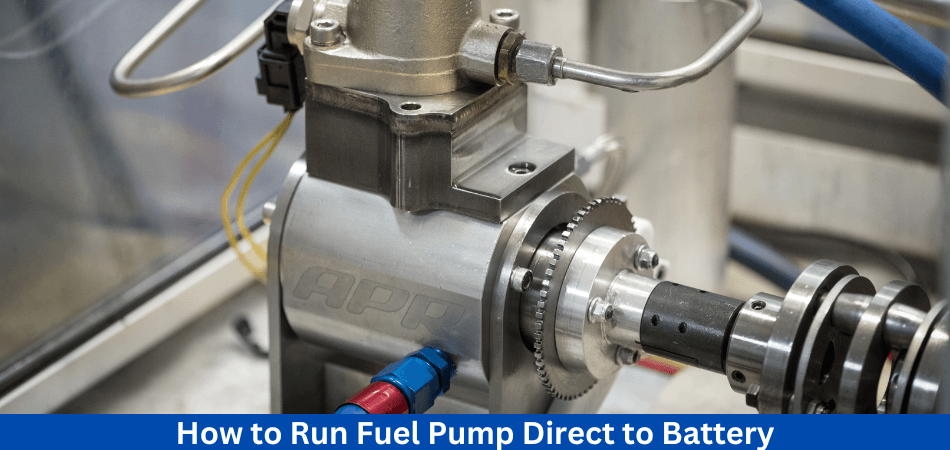
You can improve fuel economy and performance on your vehicle by running a fuel pump directly to a battery. By passing the fuel pump relay, you can send more voltage directly to the fuel pump, resulting in greater pressure and more consistent gasoline flow. But, how to run fuel pump direct to battery?
It is possible to run a fuel pump directly to a battery in a few different ways. You can do it yourself, and we will show you how to run fuel pump direct to battery in this blog post. Additionally, we’ll discuss some of the benefits and applications of running a direct wire.
So let’s learn about “How to run fuel pump direct to battery”
What Is A Fuel Pump And What Does It Do?
An engine’s fuel pump regulates the flow of fuel from the tank to the carburetor. Modern cars and motorcycles usually have their fuel pumps located inside their fuel tanks. To meet the engine’s demands, it delivers the correct amount of fuel at the right pressure.
Fuel pumps play a vital role in a vehicle’s operation. The engine would not be able to receive fuel without it. To direct wire the pump, all connections must be secure and the stranding must be correct. The pump must receive enough power from a heavier gauge wire in automotive applications.
The fuel pump plays an important role in delivering stable fuel flow to an engine, whether you’re running a lawn mower or a large carbureted block.
In general, carbureted engines use a low-pressure mechanical fuel pump located outside the fuel tank, while fuel injector engines use electric fuel pumps.
The electric fuel pump transfers fuel from the fuel tank to the fuel injector in engines equipped with fuel injectors. In order for the fuel injector to inject fuel inside the engine, these pumps must supply fuel at high pressures (typically 30-85 psi).
The pressure of the fuel must match the engine’s requirements for normal operation. Low pressure causes the engine to run out of fuel, causing it to stall, hesitate, misfire, or run lean. A high fuel pressure will cause the engine to fail, waste fuel, and produce contamination in the fuel. Read more about fuel pump here.
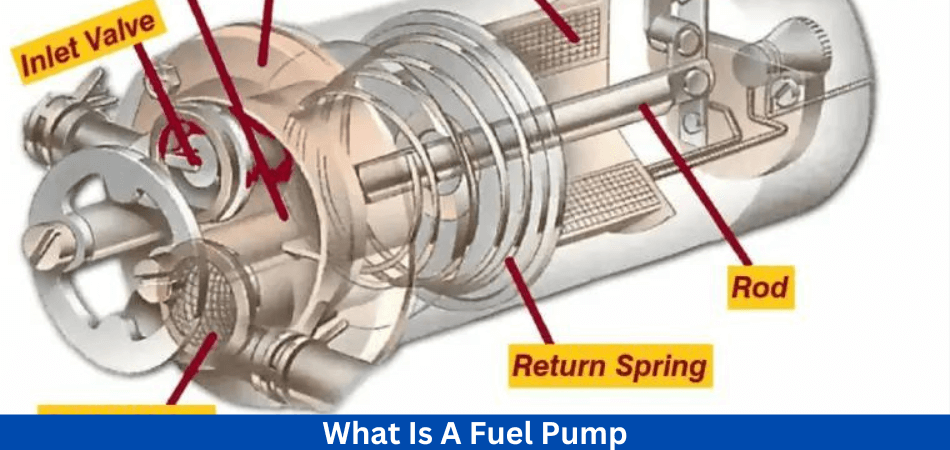
What are the Types of Fuel Pumps?
Fuel pumps can be divided into two types:
- Mechanical Fuel Pumps
- Electrical Fuel Pumps
1) Mechanical Fuel Pump
Prior to the widespread adoption of electronic fuel injection, gasoline engines often used mechanical fuel pumps to transfer fuel from the tank to the carburetor bowl.
The eccentricity of the engine’s camshaft drives the mechanical fuel pumps. An in-line cylinder block engine has a mechanical fuel pump mounted on the side.
There are two types of mechanical fuel pumps: plunger-type pumps and diaphragm pumps. One of the most famous positive displacement pumps is the diaphragm pump. In this pump, the volume of the pump chamber increases and decreases as the flexible membrane deflects, as in a piston pump.
2) Electric Fuel Pump
The fuel tank filled with fuel by electric fuel pumps, which transport it to the engine via the fuel line. An electric fuel pump transfers fuel with the help of an electric motor, which rotates a piston or diaphragm.
In the fuel tanks, there are electric fuel pumps. A high-pressure pump pushes gasoline/petrol into the engine by creating high pressure in the fuel pipes. Gasoline boils at a higher temperature under higher pressure.
Fuel pumps of this type operate continuously while the engine is running. Powertrain control modules (PCMs) in your vehicle control the pump’s operation. To ensure the correct amount of fuel delivered to the engine, the computer monitors the fuel pressure and adjusts the pump operation accordingly.
The main advantage of installing electric fuel transfer pumps inside fuel chambers is that they are less prone to catching fire. Liquid fuel does not explode, but electric parts (like fuel pumps) generate sparks and ignite fuel vapors. Therefore, immersing the pump in a fuel chamber is crucial.
By switching from a mechanical fuel pump to an electric fuel pump, the engine’s parts will be less stressed, as well as its fuel consumption will be reduced. If the pump runs continuously, you can turn off the engine with a signal to save fuel. A fast start is still possible with the required fuel pressure.
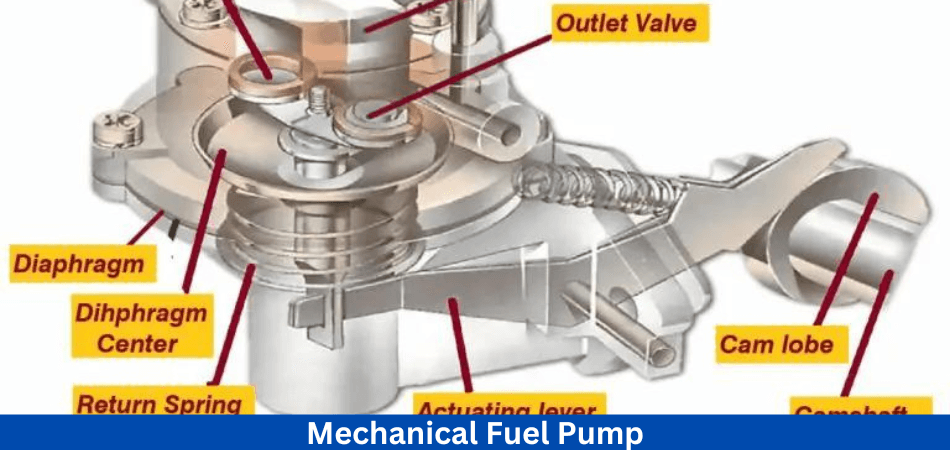
What Are The Benefits of Running a Fuel Pump Directly to A Battery?
Many people try running their fuel pumps directly to their batteries. While wiring your fuel pump directly to your battery can be a short-term fix, it is not recommended as a long-term solution. The reason is that some fuel pumps can wired directly, while others cannot.
Creating a worse problem than the one you attempted to solve is the last thing you want.
Let’s look at why you might want to do this modification in the first place. Fuel pumps running directly to batteries bypass the fuel pump relay, as we discussed previously. There are a few benefits to this pump modification:
- Increased Pressure
You can increase the fuel pressure of your engine by sending more volts directly to the fuel pump. In addition to improving performance, this can also improve fuel economy.
- More Consistent Flow
Direct battery connections also ensure a more consistent flow of gasoline to your engine because of their increased pressure. In addition to avoiding fluctuations in performance, this can make your car more reliable.
- Better Lighting
If Direct battery connections can provide the additional amperage you need to avoid dimming or flickering lights if you’re upgrading your headlights or electrical system.
- Prevent Corrosion
Battery terminals can corrode sometimes, both positive and negative. If you live in an area with high humidity, this is especially likely to happen, but it can also occur elsewhere. Connecting the fuel pump directly to the battery can help prevent corrosion.
- Improve Performance
In general, a direct battery connection improves your car’s performance. Because of this, if the fuel pump wires damaged, a direct wire to the battery can bypass the problem and fix the performance problems.

What To Consider When Rewiring Fuel Pump?
Here’s how to run a fuel pump directly to a battery, now that we’ve covered some of the benefits.
To keep in mind there are a few things to consider.
- Use a wire with a heavy gauge
The first thing you need to consider is the thickness of your wire. When connecting the battery to the fuel pump, you should use thick gauge wire to prevent voltage drop. The wire should able to handle the load and the pump should receive enough power.
- Make Use Of Wiring Harnesses
It is also necessary to protect the gauge wires that you are rewiring by using a wiring harness. If you don’t use a wiring harness, your battery connection to the fuel pump could be compromised.
- Don’t drive without testing
Before you hit the road, you’ll want to make sure all the wiring hooked up and working. Wiring mistakes can leave you stranded on the side of the road with a car that won’t start.
- Verify the fuel pressure in your car
Check your fuel pressure as soon as you have your new wiring installed. Overinflated engines can damage themselves.
If you ever have any questions, please consult a professional mechanic before making any changes. In most cases, he or she will know what you need to do.
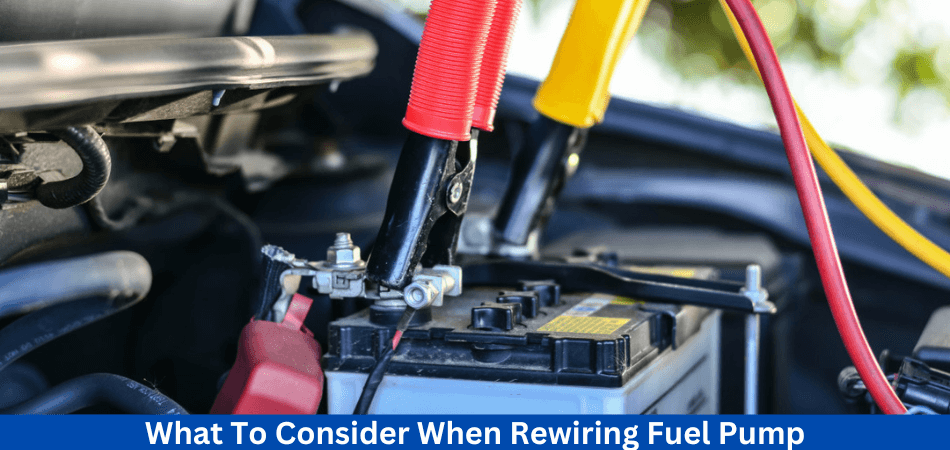
What are the Tools Required for Rewiring Fuel Pump Direct to Battery?
Here’s what parts you’ll need to connect a fuel pump directly to a battery, in addition to some of the benefits of doing so.
It may be necessary for you to have the following:
- Your car battery
- Your fuel pump
- A jumper wire
- A wiring harness
- Electrical tape
- Wire cutters/stripper
- Needle nose pliers
- Solder
- Soldering iron
- Clamps
- 30 amp fuse
- Fuse holder
- Cable
- Safety goggles
Checklist Before Directing Fuel Pump To Battery
There should be a few conditions within a rewiring scenario that meet the needs. Ensure the battery functions are not reducing engine power before going into the checklist.
A good rewiring may be able to prevent this issue from occurring. Here are the things you need to keep in mind when dealing with logical allocations:
- Make sure the fuel pump voltage is compatible with the battery voltage
- Check the grounding outlet to see if it is sturdy enough
- It is important that the power distribution is effective and sufficient. In order to achieve better results, you may want to introduce heavier gauge wire.
- Providing these requirements met, rewiring shouldn’t be problematic.
How To Run Fuel Pump Direct To Battery?
Here is the step-by-step guide on how to run fuel pump direct to battery. Please keep in mind that vehicles and processes can sometimes differ. Please note that we are giving a general overview here and that your experience may differ from ours.
Step 1: Connect A Fuse To The Battery
Connecting a fuse to the battery is the first step. By doing this, you will be protecting the battery from potential damage.
The first thing you need to do is locate your car’s battery. Make a short wire connection to the battery’s positive terminal with a clamp or pin. After that, solder a fuse holder to the wire’s other end.
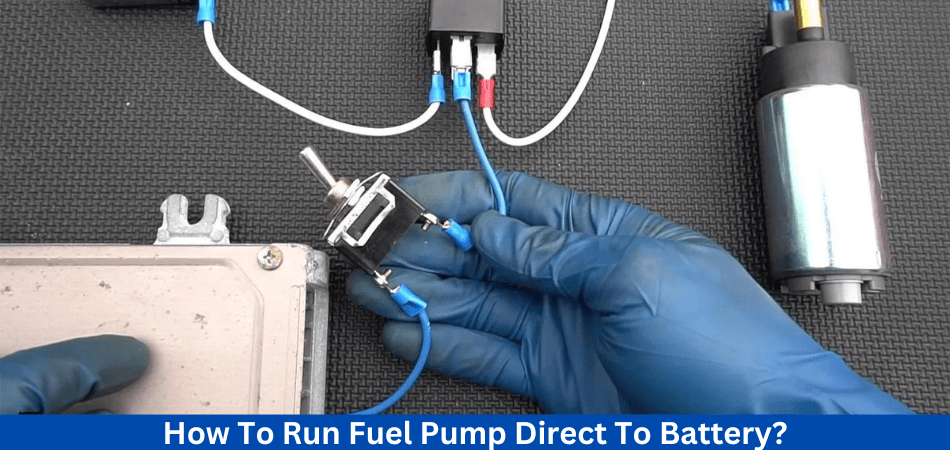
Step 2: Connect The Battery To The Fuel Relay
Now that you’ve connected the battery to the fuel relay, you’ll need to connect the fuel relay to the battery. Providing power to the fuel pump is the function of the fuel relay.
Locate your fuel relay in the engine bay. Connect the battery terminal to the fuel relay with a cable long enough to reach it.
Next, strip both ends of the wire and attach them to the battery terminal and fuel relay. If you have any exposed wires, cover them with electrical tape.
Step 3: Attach The Ground Wire
It is now time to connect the ground wire. Power flows to the fuel pump through the ground wire, which completes the circuit.
The best way to do this is to find a metal ground point near the fuel pump on your vehicle. There may be a bolt or screw attached to the frame of the car.
Ground the relay by attaching a jumper wire.
Step 4: Cut The Fuel Pump Wires And Attach
It is now necessary to cut the fuel pump wires and connect the trigger wire to the fuel pump. Power supplied to the fuel pump by the trigger wire when the engine started.
Your fuel pump has a wire harness, so locate it there. One wire will be the power wire, and the other will be the trigger wire. You will then need to connect the trigger wire (which is black and white with blue stripes) from the fuel pump to a relay terminal.
Step 5: Attach The Power Wire To The Fuel Pump
The next step is to connect the power wire to the fuel pump. When the engine is running, the power wire supplies power to the fuel pump.
Connect the power wire from the fuel pump to the other terminal on the relay by soldering it together.
Step 6: Test It Out!
Having completed all of the steps, it’s time to put it to the test! As soon as you have finished soldering, add the 30 amp fuse to the fuse holder by the battery.
Let your car idle for a few minutes after you turn it on. After starting the car and revving the engine, check to see if the fuel system has enough pressure (PSI, pounds per square inch).
If it isn’t working, check the circuit with a multimeter. You should always consult a professional mechanic if you run into trouble or a wiring diagram for your particular vehicle.
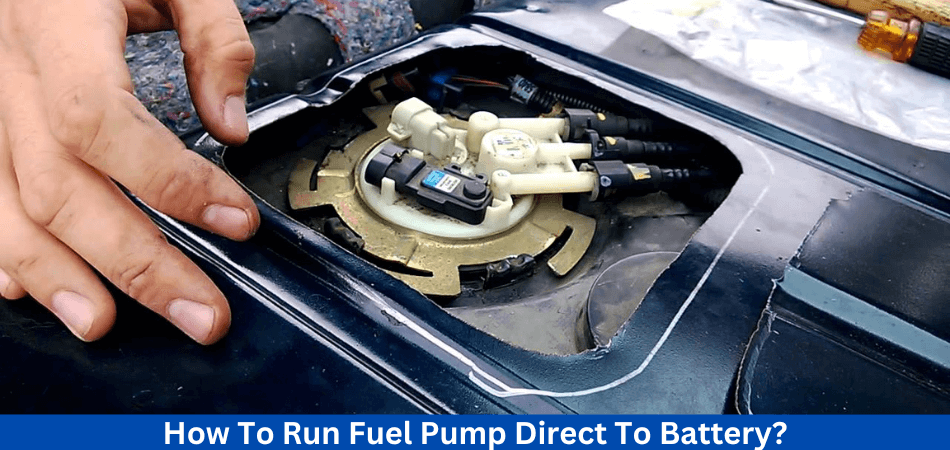
What are the Common Mistakes When Directing Fuel Pump To Battery?
Direct wiring a fuel pump can lead to problems down the road if you make some common mistakes. You don’t need to worry though, we have some solutions that will help you avoid these pitfalls.
1. Incorrect Gauge Wire:
Wires of the wrong gauge are one of the most common mistakes. As a result, your fuel pump may overheat and become damaged. Ensure you are using the correct gauge wire by checking the manufacturer’s specifications.
2. Poor Grounding:
It is also common to have poor grounding issues. As a result, the pump can operate in an erratic manner and even damage itself. It is important to secure the ground wire to a clean, rusted-free metal surface.
3. Not Using A Relay:
When you do not use a relay, you risk overloading the ignition switch and it may fail. It is always a good idea to use a relay when directly wiring a fuel pump.
4. Ignoring The Fuse:
Another common mistake is ignoring the fuse. The fuse protects your fuel pump and the electrical system of your vehicle. Fuse installation should always follow the specifications provided by the manufacturer.
5. Improper Installation:
Last but not least, improper installation can result in a number of problems. Ensure that you follow the instructions provided by the manufacturer when installing the product. Don’t hesitate to seek professional assistance if you are unsure.
You Can Save Yourself A Lot Of Trouble If You Avoid These Common Mistakes. The next sections provide some tips to keep in mind when it comes to direct wiring your fuel pump.
What are the Safety Measures Required for Directing Fuel Pump To Battery?
Having confidence in your work can ensure your safety 100%. It will be easier to accomplish things if you work with professionals. There is no possibility that anything bad could happen.
Be sure to wear protective gear, including goggles and gloves.
A few other important factors should considered in your work. There is a major focus on preventing negative outcomes, such as a fire outbreak.
You can find them here:
- When rewiring, make sure the pump is not stressed
- It is also important to recognize that the right fuel pump is used, which is specifically designed for direct wiring
- Be sure to follow the instructions provided by mechanics regarding the storage and charging of batteries. These things should not kept in a hot environment.
In the end, all the issues will resolved naturally, and your work output will be satisfactory.
What You Can Do To Make Fuel Pumps Last Longer?
To prevent the fuel pump from dying down sooner, there are many things you can do. On the other hand, some good implications will assist in improving the lifespan.
- Fuel should always be kept full, don’t wait until the fuel gauge reads zero before refueling
- Install a high-quality fuel pump from a reputable manufacturer
- It is also important to use durable and high-quality materials for the wiring
- Fuel filters should be replaced every year
- Ensure that dirt and debris do not get into the pump
- Maintain your vehicle regularly and take it to the service center more often
In spite of how much you love your car, you can also enjoy the maintenance scenario. Besides extending the lifespan of the parts, it will also extend the life of your car.
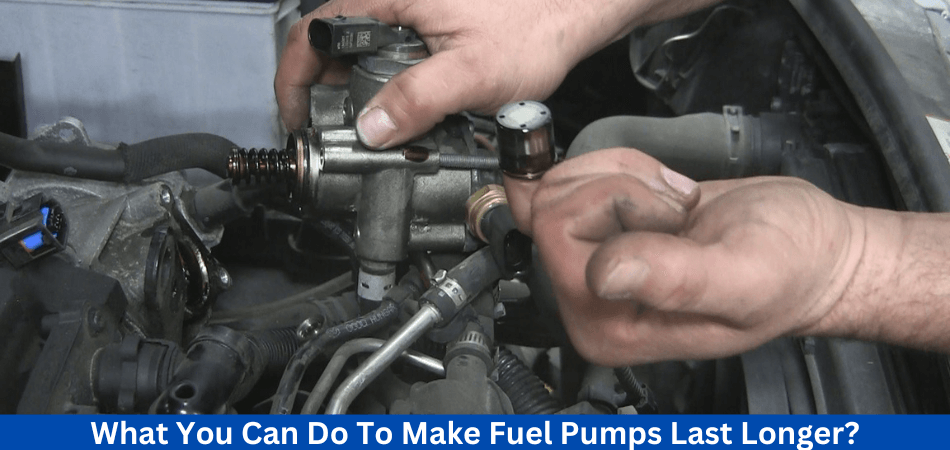
How to Get Rid of the Present Fuel Pump for Upgrade?
By unscrewing the screws, you can remove the hanger from the fuel pump. Unplug the harness-equipped fuel pump. Pull out the fuel pump nozzle from the causing unit. Remove the pump.
Find the stovepipe that is causing the problem. The stovepipe’s positive/red wire needs to be opened.
On the sending unit, remove the screw that holds the bottom wire. It is connected to the causing unit with a screw at the bottom (from the pump). Remove the screw from the bottom wire.
In order to replace the part, drill a hole. Next, install a hoop terminal on another wire.
Use a flathead screwdriver to remove the rubber fastening factor from the fuel pump.
You can install a brass bolt through the hole and then attach the fuel pump relay with a brass nut and washer under the hat. On the top of the bolt head face, connect a wire with a hoop terminal.
Connect the fuel pump to the relay unit via the hole/opening.
It is now time to wire up the fuel pump. It is possible to bolt the bottom wire inside the sending unit. Run a direct wire from the pump to the relay unit while installing new pumps. It is also possible to cut the fat finish on the sending unit tube. To connect the pump to the sending unit, use a rubber pipage hose.
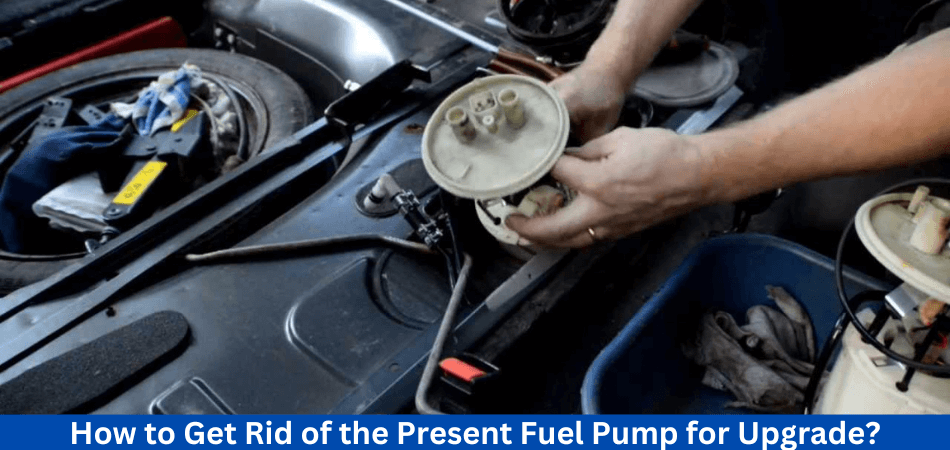
Conclusion: How to run fuel pump direct to battery?
Now you have a clear idea on how to run fuel pump direct to battery. Directing a fuel pump is an essential skill that can enhance your vehicle’s reliability and performance. This is a task that requires careful attention to detail, but it can certainly be accomplished with the right tools and guidance. In case you need a refresher on the process, feel free to revisit this guide.
Make safety your top priority at all times. You should seek professional assistance if you are unsure or uncomfortable performing this task. Would you like to learn more about vehicle maintenance and improvements? Take a look at our other guides and resources here.
FAQs
Is it possible to hardwire my fuel pump?
In the case of fuel pumps that are going out, hardwiring them will not make any difference. There will be a problem if they do not receive sufficient current. As the FP runs, will the flow vary or will it remain constant throughout as well as the further it gets to the tank? Vacuum is used to control fuel pressure in the manifold.
What color is the power wire on a fuel pump?
On On the other hand, the facility to the pump is sort of grey, grey, a shade of flash black, no matter how you look at it. The gasoline pledge is purple, lavender, lilac, mauve, periwinkle, plum, violet, or something like that. People are what the gram schematic calls them.
If we reverse the wiring of the fuel pump, what will happen?
In all likelihood, it would have killed the pump if it had been running backward. Pumps that use fuel to chill themselves typically die pretty quickly if they dry out.
Is a relay necessary for an electrical fuel pump?
Depending on the wire length, the wire thickness, the amount of current the pump attracts, and the type of controls you desire for the pump circuit. There are no fancy management requirements, low current pump, and short serious wire, so you won’t need a relay.
How thick should a fuel pump wire be?
The fuel pump power wire is 15 feet long and is 12 gauge. The power wire for the relay is 12 gauge. 5 feet of 14 gauge ground and trigger wire for relays. Hardware for mounting and terminals are included.
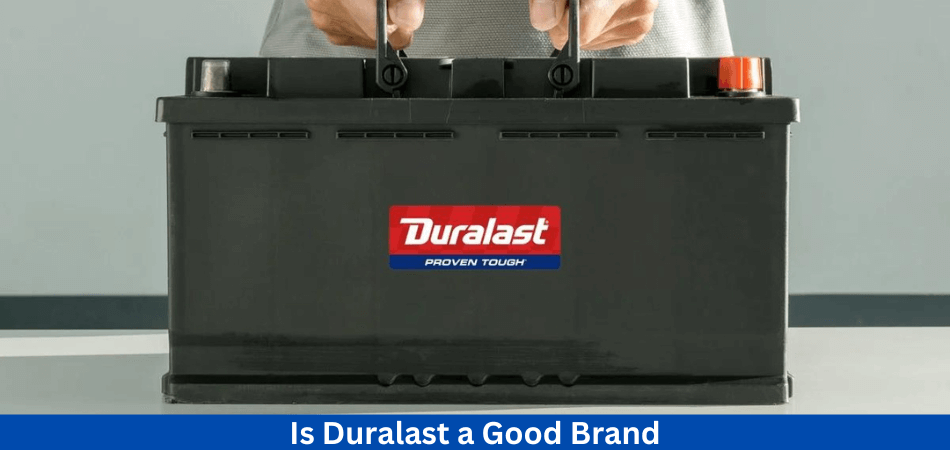
Duralast offers a variety of automotive parts and accessories, including brakes, batteries, and engine parts. The brand is owned by AutoZone, a leading retailer of automotive parts and accessories in the United States. For many makes and models, Duralast products meet or exceed the quality of original equipment manufacturer (OEM) parts. Duralast sells replacement parts and accessories for non-warranty vehicles in the automotive aftermarket. But the question is Is Duralast a Good Brand?
Duralast products are known for their high quality and affordability. There are, however, those who criticize it and those who support it. Duralast products may be reliable to some people, but they may be inferior to others who have had negative experiences with the brand. To provide a balanced view of the pros and cons of using Duralast products, this blog post examines the various factors that may influence Duralast’s reputation as a good brand.
An Overview Of Duralast’s History
AutoZone, a leading retailer of automotive parts and accessories in the United States, founded Duralast. In 1979, AutoZone was founded by J.R. “Pitt” Hyde III in Forrest City, Arkansas. As a single store, the company quickly expanded to multiple locations across the country selling automotive parts and accessories. During the 1990s, AutoZone started selling private-label Duralast products. In addition to meeting or exceeding OEM quality standards, these products were available at a lower price point than many OEM parts.
Duralast has evolved and expanded its product portfolio over time. In addition to brakes, batteries, engine parts, and more, the brand offers a variety of automotive parts and accessories. A popular choice among DIY mechanics and professional technicians alike, the brand focuses on quality and affordability.
The Duralast Gold line of products was launched in 2002, marking an important milestone in the brand’s history. With a limited lifetime warranty, these products are designed to offer the highest level of quality and reliability. Through the Duralast Gold line, the brand established itself as a reliable source of automotive parts and accessories.
In Due to changing consumer preferences and market trends, Duralast has undergone some changes and updates in recent years. A range of products are now available for purchase on the brand’s website and in its retail stores, for example. As well, Duralast has introduced numerous new product lines and categories, including Duralast Elite, which features high-performance parts for racing. While maintaining its focus on quality and affordability, Duralast has evolved and adapted to the changing needs of its customers.
Where Are Duralast Parts Made?
With parts manufactured all over the world, including Mexico, India, and beyond, Duralast offers a wide selection of automotive parts. We have everything you need, whether you’re looking for a reliable replacement part or something to keep your car running smoothly. Their reputation can attributed to the following factors:
- They offer affordable parts that are ideal for budget-conscious consumers.
- The materials they use are of high quality and can withstand wear and tear for a long time.
- It has been operating since the 1920s and is a trusted shop for all types of automotive repairs.
When shopping for new or replacement parts for your vehicle, Duralast is an ideal choice because they offer quality parts at competitive prices. One of the most popular names in automotive repair and maintenance today is because of their wide selection and easy-to-find locations.
With Duralast, consumers can rest assured that they’ll get dependable parts from a reputable source no matter what their budget is. It’s clear why so many people choose Duralast when considering which brand to buy for auto repairs or replacements based on this information.
Is Duralast a brand of Autozone?
AutoZone’s Duralast brand offers reliable parts at affordable prices that meet or exceed OE specifications. Private label parts feature a lifetime warranty and an internal regulator to ensure they work in hot and cold temperatures.
Furthermore, Duralast’s competitive prices allow customers to shop around and find the best deal for their buck on its wide variety of auto parts. A Duralast part manual isn’t always necessary when buying one, but it can provide additional peace of mind as it contains detailed instructions on how to properly install and use it.
Duralast parts have proven to stand the test of time when tested under real-world conditions. A trusted name in automotive retailing, this AutoZone brand consistently delivers quality products from batteries to brakes and alternators. Thus, it is an excellent choice for those seeking quality and durable aftermarket auto parts at great prices.
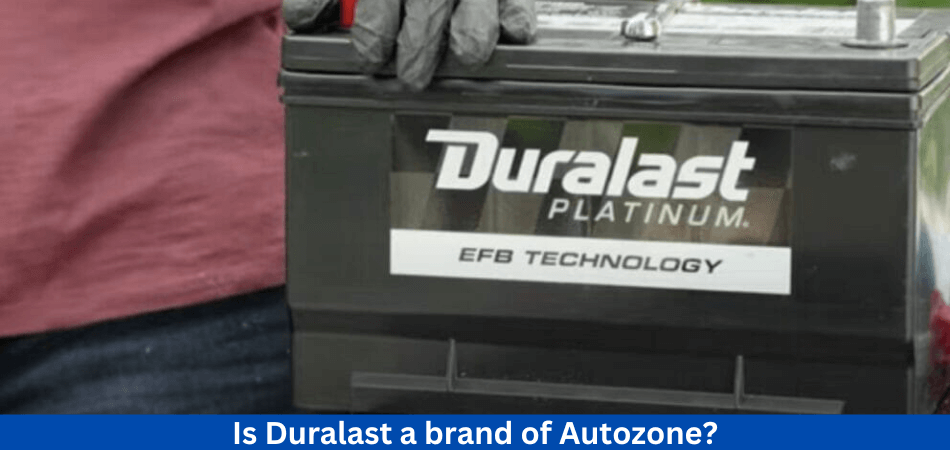
What are the Products Offered By Duralast?
Duralast offers an extensive selection of automotive parts and accessories, such as brakes, batteries, engine parts, and more. Duralast products offer the following benefits and features:
Quality: Quality products are designed to meet or exceed the quality of OEM parts and are tested to ensure they meet the highest performance and reliability standards.
Affordability: For those looking to save money on automotive repairs and maintenance, Duralast products are often more affordable than OEM parts.
Wide range of products: There is a wide range of Duralast products available for vehicles of all makes and models, including domestic and imported ones.
Limited lifetime warranty: A limited lifetime warranty is included with many Duralast products, offering customers additional peace of mind and protection.
Duralast Gold line: In addition to offering the best quality and reliability, Duralast Gold products also come with a limited lifetime warranty.
Duralast Elite line: In addition to racing brakes and suspension components, Duralast Elite products designed for high-performance applications.
Automotive aftermarket products manufactured by Duralast for vehicles that are no longer covered by a manufacturer’s warranty. Its products are popular with DIY mechanics and professionals alike and are suitable for use in a variety of industries and markets, including automotive repair and maintenance, racing, and performance.
What is the Quality of Duralast parts?
Known for their superior quality and exceptional performance, Duralast parts are tough and reliable. Its quality control protocols, rigorous materials, and industry-leading manufacturers make Duralast a good brand for affordable automotive products that perform as well or better than original equipment.
It has been reported that Duralast products last longer than other brands, rebuild better than expected, and come with a lifetime warranty. Ford parts have been my go-to brand for years without any issues and I’m confident they’re not junk. When combined with AutoZone’s excellent customer service, Duralast offers customers a great value proposition when it comes to automotive repairs.
With our products, customers are assured they are getting top-quality parts that won’t break the bank. Although there are some negative reviews about Duralast out there, overall the consensus is that it is a great option for car owners seeking high-quality parts at a reasonable price.
Is Duralast A Good Brand?
Is Duralast a Good Brand? Duralast is undoubtedly one of the most reliable and reputable brands on the market, making it a good brand. In the continental United States and some international markets, Duralast manufactures and distributes everything from engines to tie-rods.
Both consumers and large professional institutions respect Duralast in the auto parts market. You should definitely consider Duralast if you’re looking for a brand backed by professionals. You can consider them a safe choice for your auto parts needs because of their respectable business practices and fair and equitable warranty agreements.
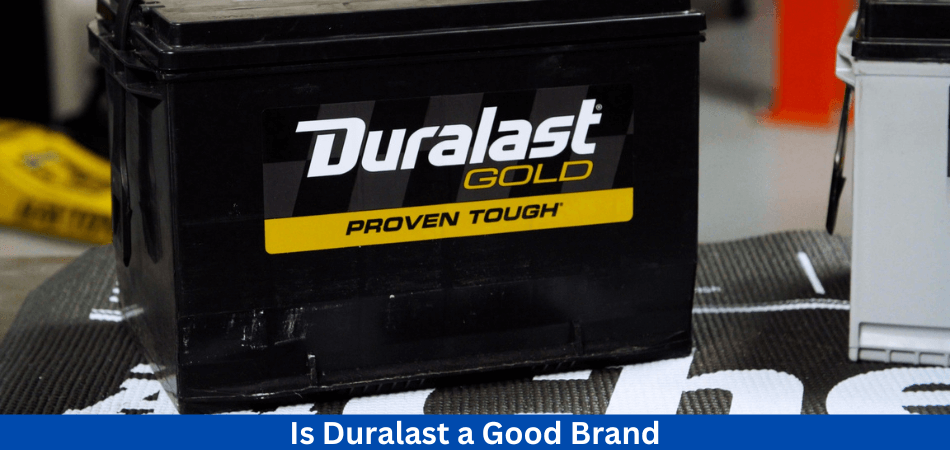
Is Duralast A Good Brand Cost-Wise?
Duralast is pretty middle of the park in terms of their actual cost breakdown, even though their overview painted them as an optimal choice. Parts provided by them are generally durable and good quality. So cost-wise Is Duralast a Good Brand?
Most people, however, find them too expensive. This is especially true when comparing alternative manufacturers or alternative marketplaces. The quality-to-cost ratio that Duralast uses may only fit a small window of people whose budget matches it.
Many people tend to either choose something cheaper that is somewhat poorer in quality or something a little more expensive that is quite a bit better in quality. Towards the end of the article, we’ll discuss which manufacturers or marketplaces are a little pricey but quite good.
Is Duralast A Good Brand Reliability-Wise?
Whenever you choose Duralast, you can assured that you are getting a part that will stand the test of time if you find that what they have to offer meets your needs. While they offer a decent warranty on some of their parts, they are vastly inferior to other sellers like AutoZone. So Is Duralast A Good Brand Reliability-Wise?
For example, AutoZone (for example) offers a lifetime warranty on axles, which Duralast might give you a multi-year warranty on. What are your thoughts on Duralast parts 10 years from now, even if you felt inclined to believe they were slightly better? Duralast axles that are 10 years old will they still perform as well as a brand new free replacement axle? It might be possible, who knows? Probably not, though.
Is Duralast Ignition Coils a Good Product?
Duralast ignition coils provide reliable, durable performance, allowing you to hit the road with ease and peace of mind. A brand like Duralast offers high-quality auto parts at an affordable price. Their ignition coils guaranteed for a lifetime and meet or exceed OE standards.
Duralast products have received positive reviews from many users, suggesting they’re worth considering for certain vehicles. Some users, however, have reported negative experiences, suggesting OEM parts may be better suited to certain applications.
It depends on the specific product and vehicle application whether Duralast ignition coils work well. Before making a purchase decision, do your research and speak with a professional mechanic to ensure that you’re getting the best possible product.
You should compare both brands before choosing one before choosing one. Napa also offers similar products at competitive prices.
How Good Are Duralast Suspension Parts?
Are you looking for durable suspension parts? Duralast suspension parts are like sturdy anchors, ensuring smooth and comfortable rides for years to come. With heavy-gauge steel and resilient components, they meet or exceed OE performance standards.
Duralast manufactures durable parts with high-quality materials, making them accessible to the market. There are a range of positive and negative reviews for this product, suggesting it may be a better option for certain vehicles than OEM parts or other aftermarket brands like Moog. Purchasing a product, however, requires research.
How Good are Duralast Brake Pads?
The Duralast brake pads are a great choice if you concerned about your safety. There are several options available from the brand, such as Duralast Gold brake pads and standard brake pads. AutoZone offers lifetime warranties on both items. For reliable braking power at an affordable price, our products meet or exceed OE quality, performance, and durability standards.
Besides being compatible with most vehicles, their high-quality products provide excellent stability as well. According to users, Duralast’s brake pads produce less dust and have a five-year lifespan.
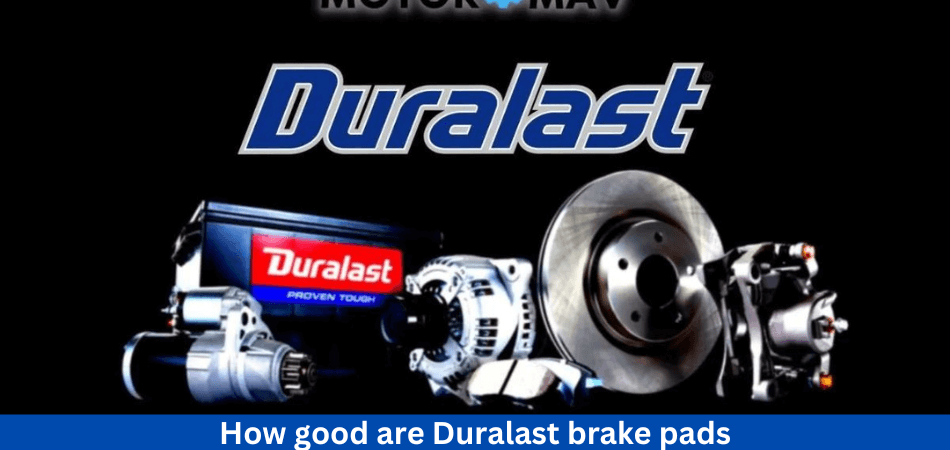
Is Duralast a Good Car Battery?
Duralast known for its long-lasting power and reliable performance when it comes to car batteries. AutoZone’s website has an average rating of 4.7 out of 5 stars from customers. Also, Consumer Reports rated the 51R-DLG model as a recommended battery with excellent cold cranking and life ratings. There are several models offered by the company, such as the Gold and Platinum series, which provide optimal performance in all types of vehicles. In addition to offering a lifetime warranty, Duralast also offers a wide range of car battery options. Is Duralast A Good Brand Reliability-Wise?
In light of all these factors, Duralast is clearly a good brand of car batteries. You can replace or exchange your battery if something goes wrong with it, even if you’ve been using it for years. Having an AutoZone nearby can be a great idea in an emergency. With Duralast’s lifetime warranty, even if your battery dies after a while, you’ll protected.
Can Duralast Wheel Bearings be trusted?
You can count on Duralast to provide a reliable wheel bearing at a reasonable price! Wheel bearings offered by AutoZone under the Duralast brand as well as the Duralast Gold brand. Durability and reliability are excellent features of the Gold option for those seeking superior performance.
Besides being factory-sealed and lubricated for life, their products come with lifetime warranties. Wheel bearings from Duralast tend to receive positive reviews from users. While some have found them to be an affordable alternative to more expensive OEM parts, others have experienced excellent quality and performance. Nevertheless, some say Timken may be a better choice for certain vehicles than other brands.
Take all of this information into consideration when deciding whether Duralast is the right brand for you. You can get the most bang for your buck without compromising safety or quality by researching FAQs and similar posts from other consumers before making a decision.
What is the lifespan of Duralast rotors?
Rotor life expectancy for Duralast rotors will range from 25,000 to 85,000 miles. A number of factors can affect the lifespan of automotive parts. Rotor longevity can affected by your driving habits, your vehicle’s condition, and how well you maintain it.
In general, rotors designed to last a long time, but eventually, they will wear down and need replacing. As a result of their quality and their usage, rotors can wear down at different rates. A well-maintained and high-quality rotor may last longer than a poorly maintained or lower-quality rotor.
Rotors should maintained according to the manufacturer’s recommendations and replaced when worn. It is important to check the condition of your rotors on a regular basis and to replace them when necessary to ensure the safety and performance of your vehicle.
What is Duralast’s warranty period?
Specific Duralast warranty terms will vary based on the product that you have purchased. To find out more about the warranty for a specific Duralast product, you can refer to the product documentation or contact AutoZone directly. Most Duralast products covered by a limited lifetime warranty at AutoZone, which means that they are covered for as long as you own them. Please read the warranty carefully and understand its terms and conditions, as some exclusions and limitations may apply.
Is Duralast a good brand compared to Autopartswarehouse and Autozone?
As these three marketplaces are highly comparable, they tend to appear in the same conversations. It should noted that each of them offers different benefits and is quite different from the others. As an example, Duralast built to last, whereas Autozone built to be decent, but also reasonably inexpensive to replace. Is Duralast A Good Brand?
In comparison to Duralast, Auto Parts Warehouse offers a nice blend between the two, though they don’t always have as many items in stock. It likely depends on what part you are looking to replace and what offers the three brands have if you are in a competition between them.
Unless it is a super niche part that they don’t carry or manufacture, it is always a good idea to browse all three of them. Here is what you should probably consider as your best option in the next section. It’s even better than Duralast.
How Do Duralast Parts Compare To OEM Parts?
No, not really. Duralast is not a bad brand by any means. Duralast’s problem is that their prices are so close to OEM parts that you might as well go with OEM parts since they’re more likely to be better and you already KNOW they’re compatible.
As your mechanic already knows the parts they are working with quite well, they can sometimes fix or replace parts more easily and solve problems more quickly. It’s true that Duralast offers a few % off of the price, but for the sake of (usually) a few bucks, you may as well go with the original manufacturer’s parts.
If you want to purchase parts, a good flowchart would be to buy from OEM unless they don’t carry the part you want for some reason or Duralast is more than 10% cheaper.
Duralast Vs Carquest
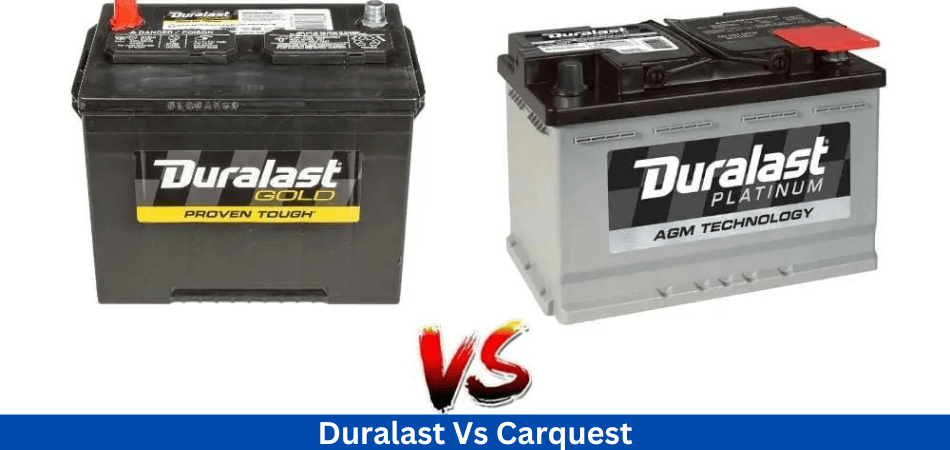
Both Duralast and Carquest have their advantages and disadvantages – so which is best for you? With over 60 years of experience in the industry, Duralast is a great choice for affordability and reliability.
When comparing the two, keep these points in mind:
- There are two types of brake pads offered by Duralast: Gold and standard. Both options praised for being stable when braking, producing less dust, and having a long service life.
- The alternators from both brands have received mixed reviews, with no clear winner.
- The quality of a product may vary depending on the type of vehicle and its application. It is important to research thoroughly before making a decision.
After considering all the factors, you should choose an auto part that meets your specific needs as well as your budget. Before investing in either Duralast or Carquest, make sure you read reviews and compare products carefully.
The next step is to compare Duralast Gold with standard Duralast products.
Duralast Vs Duralast Gold
Selecting automotive parts requires considering the differences between Duralast and Duralast Gold – they offer different levels of quality and performance.
Compared to standard Duralast parts, Duralast Gold components engineered to meet or exceed OE quality, ensuring better performance and durability.
Standard Duralast brake pads provide similar performance in normal driving conditions, but Duralast Gold brake pads provide higher quality control and a refined production process. As a result, Duralast Gold batteries offer greater vibration resistance and power, making them ideal for heavy vehicles with high demands, such as those with heated seats or infotainment systems.
In order to ensure you get the best quality and performance for your specific vehicle needs, you should research and compare products from both lines. All of these factors will help you make an informed buying decision that meets your needs.
Duralast Vs Diehard
As both Diehard and Duralast automotive batteries come with their own advantages and disadvantages, comparing them can be tricky. It well known that Duralast batteries are affordable, made with high-quality materials, and have reliable performance. Conversely, Diehard batteries’ cold-cranking amps (CCA) range from 550A to 900A, making them renowned for their exceptional longevity.
There are similar reserve capacity ratings between both brands, but Diehard provides a longer warranty of three years compared to Duralast’s two years. In the end, the right choice depends on your specific needs and what kind of vehicle you are looking for.
To ensure you get the best quality and performance for your car or truck, it is imperative to research and compare both brands’ products before making a purchase decision It is also important to consider factors such as cost, CCA ratings, reserve capacity ratings, and warranties offered by each brand when choosing between Duralast and ACDelco batteries.
Learn more at here.
Duralast Vs Acdelco
Both Duralast and ACDelco automotive parts offer unique benefits and drawbacks, making it tricky to choose between them. Duralast offers great options with its Gold and Platinum battery lines, which highly regarded. Known for their affordability and reliability, they provide reliable performance.
As well as having a good reputation, ACDelco batteries offer a variety of CCA ratings. The Duralast models have reported to last longer by some users. There are viable options for both brands when it comes to brake pads. There limited information available about ACDelco’s offerings in comparison to Duralast’s, but Duralast’s Gold and standard brakes offer solid performance.
Overall, you should research both brands’ specifications and how they fit your vehicle needs before choosing between them. To ensure your car or truck has the best quality and performance, you should consider all aspects before buying. It’s important to compare before making a decision – what works best depends on individual requirements.
Duralast Vs Valucraft
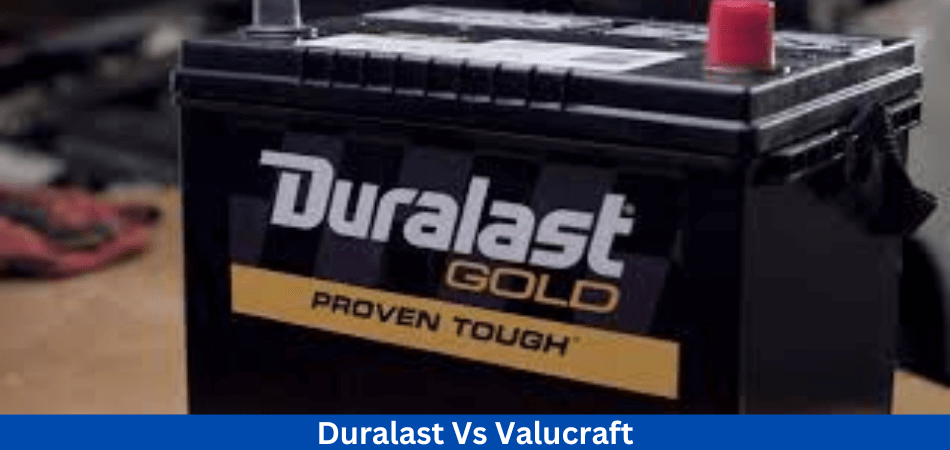
There are two brands that offer different levels of quality and performance when it comes to automotive parts: Duralast and Valucraft. Because Duralast parts made of high-quality materials, they provide reliable performance while remaining affordable.
In contrast, Valucraft parts are cheaper, but they may not perform as well. Valucraft brake pads and rotors may not perform as well or last as long as Duralast brake pads and rotors. A Duralast part also comes with a longer warranty than a Valucraft part.
Duralast Vs Wagner Brake Pads
Choose between Duralast and Wagner brake pads, two brands with different levels of performance and quality. Duralast’s reliability and affordability make it a popular product. Duralast Gold and Standard brake pads are affordable options that made with high-quality materials and known for their reliable performance.
Conversely, Wagner offers ThermoQuiet brake pads, known for their excellent stopping power and quiet operation. It has reported that they provide better wear and service life than other brands. Prior to making a purchase decision, you should research the best option for your vehicle’s needs, as both Duralast and Wagner brake pads offer good quality and performance. There are a number of benefits to each option, so you can find the one that suits your needs best.
Duralast Vs Everstart
A comparison of Duralast and uralast and Everstart automotive batteries? Considering the pros and cons of each will help you decide which is best for you. In addition to its affordability and quality materials, Duralast known for its reliable performance. Performance and reliability are highly regarded when it comes to their gold and platinum options.
Conversely, Everstart batteries also considered durable and reliable, with a lifespan of 2- 5 years. They’re sold at Walmart made by a company that produces some of the more premium brands too, offering up to 800 CCA ratings for better cold-cranking performance in some cases.
Despite the fact that both brands offer good quality, you should research each product carefully to ensure that it meets your specific vehicle needs. Depending on your situation, either could be the right choice. Therefore, weigh both equally before choosing which is best for you. Be sure to keep these considerations in mind as you research Duralast vs. OEM.
Do Duralast products have any common issues or complaints?
Customers have reported a range of problems with Duralast products. There are serious quality concerns for some drivers, from wiper blade fitment issues to defective parts such as radiators and battery chargers within a short time period of use.
A remanufactured part, such as an alternator, may not meet the same standards as a new one due to the rebuilding process. Wheel bearings and suspension parts can differ in terms of performance between different vehicles, causing some users to choose other brands such as Moog or Timken.
It is important to do your research and compare products before making a purchase in order to get the best value for your vehicle needs, even if these complaints don’t reflect the brand’s overall quality. If Duralast is right for you, you can make an informed decision. In the coming weeks, we’ll examine Duralast’s quality and reliability in comparison with other automotive brands.
Conclusion: Is Duralast A Good Brand?
Now that you know more about Duralast, you should have a better idea of whether the company is right for you. The brand provides high-quality products that built to last and are certainly reputable. It is clear that Duralast is on par with its closest competitors Autozone and Auto Parts Warehouse. However, Duralast isn’t competitive with most OEM options. You might as well invest a little more in OEM parts.
Read more of our articles here.
FAQs
Is Duralast a reputable brand?
Automotive professionals generally consider Duralast to be a reputable brand. Several auto parts stores and retailers carry their products, and they have been in business for many years.
What is the reliability of Duralast products?
The Duralast brand is known for its reliability. Batteries and brake parts are essential auto parts that many consumers trust for their durability and performance.
What kind of warranty does Duralast offer?
Warranty coverage varies from product to product with Duralast products. If you purchase an item, you should read the warranty details to understand how it is covered.
Compared to other automotive brands, how does Duralast fare?
A number of well-known automotive brands compete with Duralast. Individual preferences and product categories may influence the comparison. Make an informed decision by researching and reading reviews.
Can you tell me where I can buy Duralast products?
Duralast products are available at auto parts stores, online retailers, and even some large general merchandise stores. To find the closest location, check the Duralast website or contact a local retailer.

A hose clamp is used to clamp a hose to a fitting, preventing the fluid in the hose from from leaking at the connection. There are a variety of attachments available, from car engines to bathroom fixtures. In spite of this, hose clamps are used across a wide range of industries in order to secure the transportation of products, liquids, gases, and chemicals. Hose clamps fall under four broad categories: screw/band, spring, wire, and ear. Different types of clamps are used for different kinds of hoses depending on their end attachments. There are many questions surrounding the use of hose clamps, one of the most frequently asked question is how to tighten a hose clamp?
In this guide, we will explain the different types of hose clamps, their uses, and how to care for them. A discussion of the different industries in which hose clamps are utilized will also be covered, providing you with answers to all your questions about hose clamps!
Furthermore, we will focus on, especially the guide on how to tighten a hose clamp. So let’s get started.
How Do Hose Clamps Work?
- The first step in attaching a hose clamp is to attach it to the edge of the hose.
- Next, the hose edge is placed around an object.
- As the clamp is tightened, the hose is secured in place and nothing from inside can escape.
In general, screw/band hose clamps are not commonly used for ultra high pressure scenarios, but rather in lower pressure environments as well as for quick fixes, especially in the home. The automotive, agricultural, and marine industries, among others, use them. Learn more about hose clamp here.
How To Use A Hose Clamp?
It is possible to use a hose clamp to keep your hose from kinking or to keep it organized while in storage if your hose tends to kink. Hose clamps fit most hose sizes, and they clamp the hose to keep it in place by compressing it. You must first determine the size of clamp you need before using a hose clamp. Make sure the screw of the clamp faces upward when you place it around the hose. Tighten the screw until the hose is securely attached. Overtightening the screw can damage the hose, so be careful not to do so.
In order to prevent fluid from leaking, hose clamps secure a hose to a fitting. In the automotive and plumbing industries, they are commonly used. T-bolts, worm-drives, and plastic hose clamps are the three main types of hose clamps. Whenever there is a high-pressure hose or a high-vibration application, T-bolts can be used as clamps. Screwdrivers and wire cutters are also acceptable tools for installing hose clamps, but TorqueWover is the best choice. Manufacturers describe torque standards for clamps in inches. Heavy-duty applications are best served by steel. The use of plastics is a cost-effective alternative to metals in a variety of applications, but their specific uses necessitate their use.
What are the Common Types of Hose Clamps?
Clamps are often used to attach fluid-filled hoses to machinery. Coolant hoses connected to the radiator and motor of a typical car or truck using clamps. The clamps prevent the coolant hoses from leaking as well as holding them in place. If the clamp is tight enough, the coolant won’t leak even as it heats up inside the hose. There are three types of hose clamps that are most commonly used.
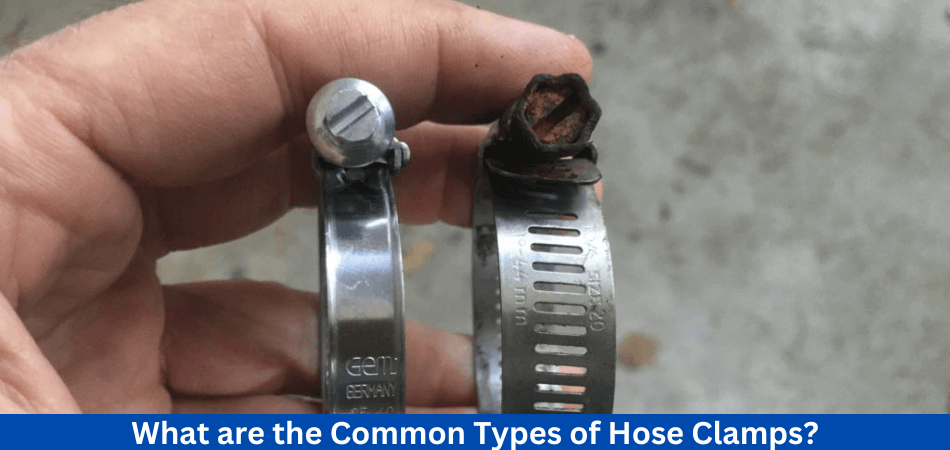
1. Screw Clamps
Screw clamps are clamps that have an integrated screw, also called worm gear clamps. This is a strip of metal with a thread pattern, usually made of stainless steel or galvanized steel. The thread pattern on screw clamps connected to a screw that used to tighten or loosen them. The screw clamps will tighten when the screw turned right, whereas the screw clamps will loosen when the screw is turned left.
2. Constant-Tension Clamps
Constant tension clamps are another type of hose clamp. Hoses are continuously tensioned with constant-tension clamps. There are no screws on them. The constant-tension clamp made from a coil of spring steel. The ring-shaped clamps resemble screw clamps, with both types resembling rings. A constant-tension clamp, however, does not have any screws.
The installation of constant-tension clamps requires a different method than that of screws. The ends can pressed together to install them. Tabs fixed at the end of constant-tension clamps. By pressing together, these tabs will force the constant-tension clamps to open. The constant-tension clamp can placed around a hose and then released so that the hose clamped.
3. Wire Clamps
Wire clamps are also available. As their name implies, wire clamps are made up of a single wire. A U-shaped wire formed by pressing and manipulating it. There is a captive nut and a captive screw on the opening of this U-shaped design. By removing the screw, you can place a wire clamp over a hose. With a screwdriver, tighten the screw after adding the screw. The captive nut can used to secure the wire clamp once it has ben tightened sufficiently.
A wire clamp is less common than a screw clamp or a constant-tension clamp. Nevertheless, some hoses still use them. Easy to tighten and loosen, they have a simple design. Wire clamps have the disadvantage of not lasting as long as other types of clamps.
Which Hose Clamps Should You Choose?
Different automotive systems require different types of hose clamps, depending on the size and type of hose, the pressure and temperature requirements, and where the hose located. In general, the following hose clamp types recommended for different automotive systems:
1. Cooling System
An ear clamp or spring clamp is commonly used in the cooling system. An ear clamp provides a tamper-proof seal while worm gear clamps are easy to install and adjust.
2. Fuel System
Fuel system hose clamps are commonly used because they provide a secure grip and are easy to install and adjust.
3. Vacuum System
Worm gear hoses and spring clamps provide constant pressure on the hose and are easy to install and remove in vacuum systems.
4. Exhaust System
These clamps provide strong, secure connections and can withstand high temperatures in the exhaust system.
5. Air Intake System
The air intake system usually uses worm gear hose clamps or T-bolt clamps for their secure connection and heat resistance.
What are the Advantages of Automotive Hose Clamps?
There are many reasons why automotive hose clamps are widely used in the automotive industry, including:
- Secure Hose Connections: Using hose clamps in automotive systems ensures that fluids flow properly and prevents leaks.
- Easy to Install and Remove: Changing hoses or performing maintenance on automotive systems is easy with hose clamps.
- Adjustable: Worm gear clamps, for example, are adjustable, allowing the clamp to tightened around the hose with ease and precision.
- Durable: The metal used in automotive hose clamps makes them solid and durable, able to withstand high temperatures and pressures.
- Versatile: Hose clamps come in a variety of sizes and types, making them suitable for a wide variety of automotive applications.
- Cost-effective: In automotive systems, hose clamps are a cost-effective way to secure hoses because they are relatively inexpensive.
A hose clamp provides a secure and reliable connection between hoses and ensures that fluids flow properly in an automotive system. They are ideal for use in the automotive industry because of their ease of use, adaptability, durability, versatility, and low cost.
How to Tighten a Hose Clamp?
A hose clamp tightens a hose over a fitting usually made of stainless steel. It is commonly used for car engines, bathrooms, and other plumbing applications, providing a secure and tight connection to prevent leaks. But, how to tighten a hose clamp?
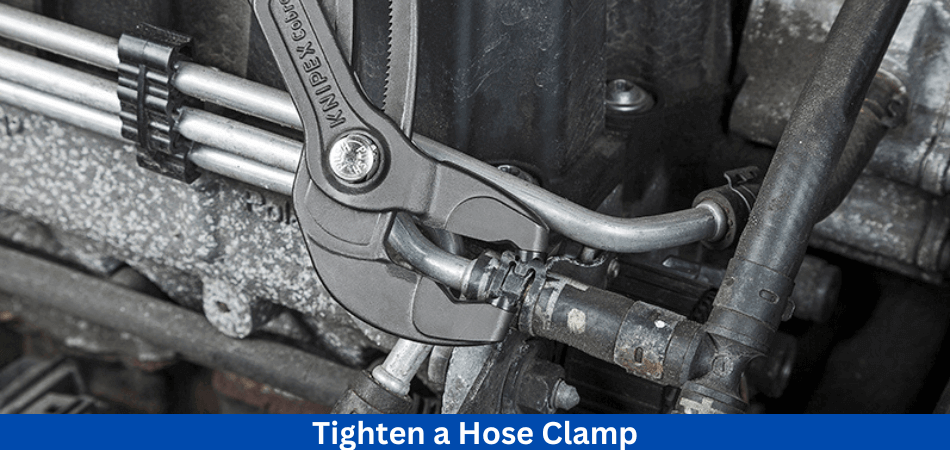
Tighten the hose clamp by turning it anticlockwise with a flat-head screwdriver and hex wrench. Once the clamp separated, continue rotating it. The clamp should positioned over the fitting after being carefully slipped onto the hose. Make sure you have your screwdriver handy again. Ensure that the connection is tight by turning the bolt clockwise.
The purpose of this article is to examine the tools needed for tightening hose clamps in detail. Our guide will also show you how to tighten a hose clamps step by step. Now let’s get started!
Things you will need:
- Flathead screwdriver
- Hex wrench (alternative to a flat-head screwdriver)
Check out these quick tips for tightening hose clamps yourself!
Step 1: Unscrew the Clamp
You will need a flathead screwdriver (or a hex wrench) and a hose clamp. Rotate the screw anticlockwise with the tool. Rotate the clamp until the hose separated while you open it.
Step 2: Position it On the Hose
Make sure the clamp is properly attached to the hose by sliding it on carefully. Attach the hose to the fitting and hold it firmly in place. The clamp needs to positioned in such a way that it will not slide off of the joint with the help of your other hand.
Step 3: Switch the Direction of The Clamp
Make sure the clamp is facing you when you turn it over. By doing this, you will be able to access the screw more easily.
Step 4: Put the Screw Back into Its Sleeve
Reinstall the screw in its sleeve the other, slide the screw into the sleeve that held it before it separated.
Step 5: Tighten the Clamp
The driver should rotated clockwise using a wrench or screwdriver. Once the driver engages, tighten the clamp until the clamp contracts, securing the hose in place.
How To Tighten Metal Hose Clamp?
Things you will need:
- Hose clamp tightening torque
Step 1: Choose the Right Clamp
Metal hose clamps come in a variety of types. A solid metal hose band with buckles is the most common type. This type of connector is ideal when tight connections required.
Step 2: Carefully Position the Metal Clamp onto The Hose
Make sure the clamp is properly attached to the hose by sliding it on carefully. Attach the hose to the fitting and hold it firmly in place. By using your other hand, position the clamp so that it does not slip off the joint.
Step 3: Slide the Driver Back into Its Original Sleeve
Slide the screw into the sleeve that initially held the clamp while contracting it.
Step 4: Tighten the Clamp
The driver should rotated clockwise. Tighten the clamp until the screw and nut engage and the clamp contracts, holding the hose firmly in place.
How To Tighten Radiator Hose Clamp?
Things you will need:
- Screwdriver
- 5/16” nut driver
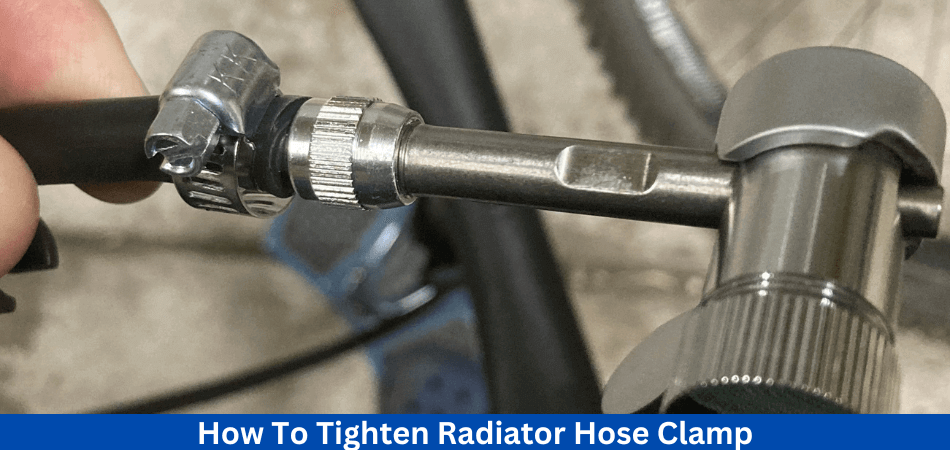
Step 1: Pick an Appropriate Size
A radiator hose clamp’s size is the most important factor to consider. The clamp should sized and typed according to the hose’s diameter.
Step 2: Unscrew the Radiator Hose Clamp
The radiator hose clamp can opened by turning the screw counterclockwise. The best tool for this job is a screwdriver or a 5/16″ nut driver. The slotted band must separated from the screw threads using a screwdriver/nut driver.
Step 3: Fit the Band Around the Hose
Clamp the hose by opening the band completely and sliding it over it. To make it easier to access and use the tools, make sure the screw head faces the right direction.
Step 4: Tighten the Clamp
The screw should inserted into the screw-housing that held the screw before you separated it. Make sure the driver rotated in a clockwise direction. The clamp should tightened until it is securely attached to the hose.
How To Tighten Coolant Hose Clamps?
Things you will need:
- 1/4” rachet
- Philips head screwdriver
Step 1: Locate the Clamps
Radiator clamps are usually located in odd places which makes tightening them difficult. Use different tools to target each clamp if you need to improvise. As a result, it is crucial to know where radiator clamps located.
Step 2: Find the Right Tools
Choosing the right tools is the second steppending on the location of your clamps. Clamps for coolant hoses work well with a 1/4″ ratchet. For the clamps located in the upper areas, you could use a shorter rachet and a regular-sized rachet.
Clamps that are easy to reach can even reached with a Phillips head screwdriver.
Step 3: Tighten the Clamps
The third step is to tighten the clamps, you can push certain pipes out of the way, ensuring you don’t move them out of place too much.
Using the tools you have at hand, position the clamp so that it is easier to tighten. Position the screw back into the sleeve that held the clamp before it separated to contract it. Once the clamp is securely attached to the pipe, continue rotating the driver clockwise.
Why Should You Avoid Overtightening Hose Clamp?
As You have learned how to tighten a hose clamp, you might heard a myth that, the tighter the hose clamp, the better. As a result, overtightening can damage both rubber hoses and clamps, as well as increase leakage chances.
For clamp fastening, most OEM parts have constants (Nm) for safety factors of hose and clamp. Depending on the size and usage, these constants will vary.
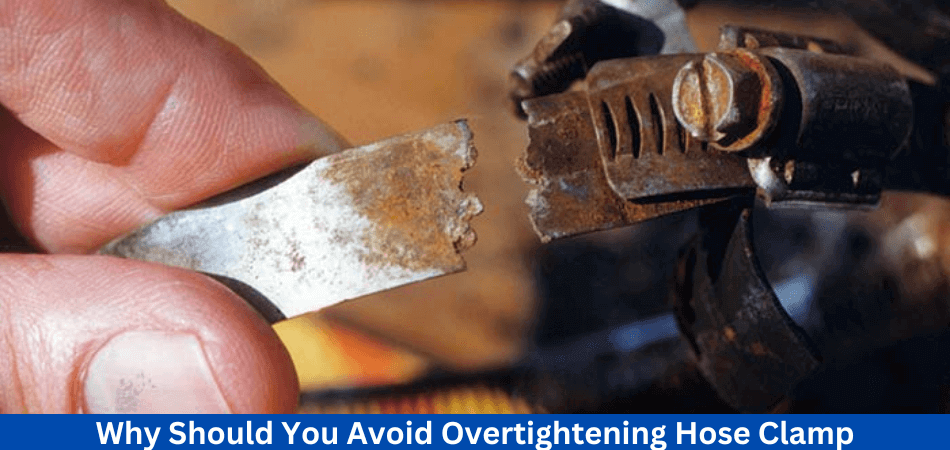
In a situation where a plastic pipe connected to rubber hose, a user contacted us with the complaint of leakage. According to our investigation, the clamp had been overtightened, resulting in a misshapen plastic pipe. The user forced to replace the entire unit, incurring unnecessary additional costs.
A clamp’s tightness and torque are normally directly related, so that as we tighten it, it becomes tighter. At some point, this direct relationship between input (torque) and output (tightness) stops. As overtightening violates the safety factor of the clamp, excess torque would damage the clamp, hose, or pipe instead.
To ensure clamp torque meets the guideline given for each clamp, a torque meter is commonly used when installing clamps. However, the following technique can used without a torque meter. The clamp is to be screwed only until the hose is slightly below the clamp. After the surface has smoothed, stop screwing. So, AVOID OVERTIGHTENING!
Why It’s Important to Install Your Hose Clamps Properly?
Hose clamps might not be the first thing you think of when considering potential health and safety hazards for vehicles. In certain situations, a hose clamp that has not been installed properly can be extremely dangerous.
In addition to highlighting some of the worst-case scenarios, we also emphasize the importance of proper installation wherever your hose clamps used.
FIRE CAN OCCUR IF HOSE CLAMPS ARE NOT INSTALLED PROPERLY
Excessive tightening of a hose clamp can result in a serious vehicle fire. Overtightened clamps squeeze the hose, causing rubber to extrude and bending the fuel tube itself.
In turn, this can lead to fuel leaks, which are the last thing you want to happen to your car. In the event that this leaking fuel catches alight, the entire vehicle could destroyed.
When hose clamps are improperly installed, most people assume that they are not tightened sufficiently. However, these examples demonstrate that overtightening a hose clamp can also be fatal.
It’s more than just a problem for large vehicles, such as cars or trucks. The excessive tightness of a hose clamp can also cause other smaller vehicles to catch fire. Go-karts and golf carts can found at your local golf course. A seaborne vessel, such as a yacht, could even affected.
Since these vehicles are less likely to undergo regular MOT checks, they can present an even greater safety risk. Likewise, a hose clamp that’s too tight can wear through the material, resulting in a hole in the fuel tank.
How to Properly Remove a Hose Clamp?
You may have to remove a hose clamp in many situations. Any type of pipe can connected with hose clamps, whether it’s in plumbing, on a vehicle, or on piping of any kind. If the clamp has been on for a long time, it may be difficult to remove. When it comes to removing hose clamps, here are some options to consider.
1. First Identify the Type of Clamp
When it comes to removing an adjustable hose clamp, there are a number of tools that you can use. To remove a hose clamp, you can either use pliers and your hands or a hose clamp removal tool. You may be able to remove the clamp more easily with a hammer and screwdriver if it is too tight or badly corroded. Identifying the type of clamp you are dealing with is the first step in removing a hose clamp. A pinch clamp and a worm-driven clamp are two types of clamps. By using pliers, simply reverse the direction of the arrow on the clamp head to remove the latter. By doing so, it will be easier to remove the clamp from the hose. Pinch clamps must removed with hose clamp pliers, a special type of pliers.
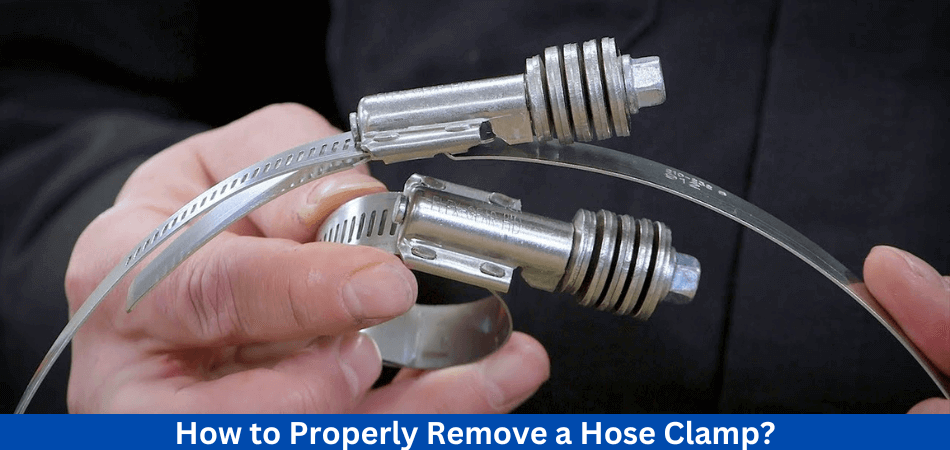
2. Use a tool to remove the hose clamp
It is fortunately possible to remove hose clamps using a specific tool. If you have worked on a car before, you have probably encountered one. Removing hose clamps is one of the most common tasks when working on a car. You can make the entire process easier by using a hose clamp removal tool. You can easily remove the clamp with this tool by slipping it over the hose clamp. This type of tool is available in several forms. Alternatively, you can find ones that adjust to fit any hose clamp size. A locking pliers should used with the tool to secure the clamp during removal.
Can You Remove a Hose Clamp Without Tools?
Yes, in a nutshell. Adjustable hose clamps can removed with your hands only. The hose clamp only needs to twisted in opposite directions by placing your hands around it. You should be able to remove it from the hose once it loosens, then clamps enough to allow you to remove it. It’s also possible that the clamp is too tight. You may not be able to do the job alone with the strength of your hands in such situations. It may be easier to use pliers if that is the case.
Removing an adjustable hose clamp becomes easier if you use the right tools and identify the clamp type. Get in touch with us today if you would like more information.
How to Care for Your Hose Clamp?
- If you overtighten your clamps, you may experience pressure problems in the future.
- Make sure the hose clamps you choose aren’t too large. Even though too-large clamps may still do the job, they can be aesthetically unappealing as well as hazardous.
- If you want to ensure durability, don’t scrimp on the quality of your hose clamps and their installation.
Final Thought: How to tighten a hose clamp?
Now, you might have leaned how to tighten a hose clamp? For anyone who works on plumbing, automobiles, or household repairs, learning how to tighten hose clamps is a valuable skill. This guide will show you how to secure and leak-proof your hose connections by following the steps outlined and using the appropriate tools. Keeping hose clamps in good working order is essential for preventing costly leaks and damage. A mastery of tightening hose clamps will save you time, money, and frustration in the long run, regardless of whether you are a DIY enthusiast or a professional. Remember, with a little practice and the right knowledge, you can tighten hose clamps with confidence.
Read more of our articles here.
FAQs
How often should I tighten hose clamps?
It is a good idea to tighten a hose clamp when you notice a leak around the hose connection or if the hose feels loose on the fitting. A regular maintenance check can also prevent unexpected problems.
How do I tighten a hose clamp?
For most hose clamps, you will need a screwdriver or a nut driver. Using hose clamp pliers is one of the easiest ways to tighten some hose clamps.
Is there a way to identify the type of hose clamp I have?
In addition to worm gear clamps and spring clamps, T-bolt clamps are also available. You can identify the type by looking at the design and tightening method. If you’re unsure, consult the manufacturer’s instructions.
How should a hose clamp be tightened?
The first step is to locate the hose clamp on the hose. Turn the clamp’s screw or bolt clockwise using the appropriate tool. Be careful not to over-tighten the hose or fitting, and continue to tighten until it is securely attached.
What is the recommended tightness of the hose clamp?
Depending on your application and the type of hose material, the ideal tightness varies. A snug, leak-free connection should be created without causing damage to the hose or fitting.
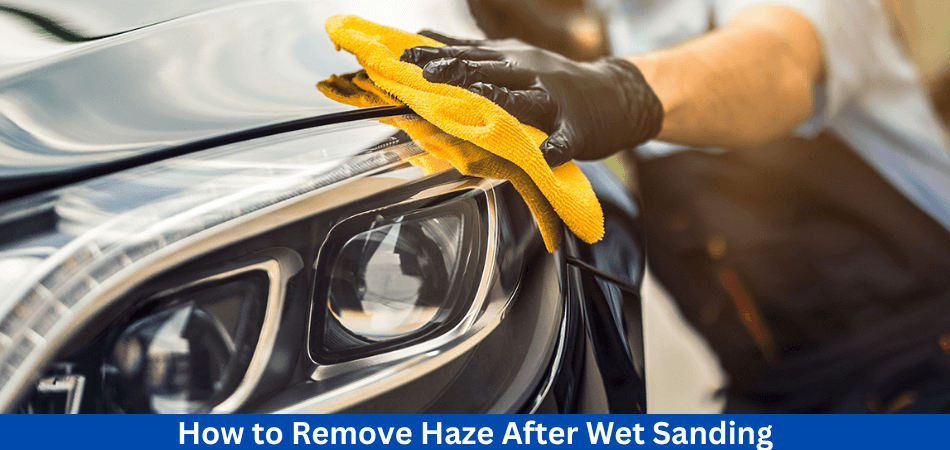
You might be wondering how to remove haze after Wet sanding. Regular cleaning, buffing, and shining are essential for keeping your car’s paint job looking glossy. It’s inevitable that even the most meticulous car owners will find little scratches or scuffs caused by bushes, trees, or even the weather.
Although finding these imperfections on your car’s surface can be disheartening, it does not necessarily require a full paint job.
If a car paint job has lost its natural luster, how can it be restored without a complete repaint? The following article explains the wet sanding process when to use it, and what to do when it doesn’t work. Moreover, it also covers, How to remove haze after Wet sanding.
What is Wet Sanding?
Wet sanding – What is the process intended to smooth out and remove small, surface-level scratches from car paint? Using high-quality wet sanding techniques can create a smooth, like-new finish. The orange peel effect, where car paint becomes uneven and pebbled, resembling orange skin, can also be removed using it.
During wet sanding, dampened sandpaper is used to create an even surface, allowing the existing paint to bleed into any gaps. In some cases, however, it can be difficult to apply the correct pressure and avoid removing any deeper layers of paint.
What are The Common Applications of Wet Sanding?
1. Wet sanding wood
In order to reshape wood surfaces, remove splinters, or straighten uneven wood, people have adopted dry sanding over the years. To give woodwork in homes a glassy and clear appearance, wet sand them. This can be done on cupboards, chairs, tables, or worktops.
The wet sanding of some wood products, such as violins, should be avoided. When wood absorbs water, it becomes swollen or wrapped. Spraying enough water and wiping it off after sanding is the best method.
2. Wet sanding metal
It is the process of wet sanding a metal that gives it a perfect finish. The metal is polished to remove minor defects while improving its shine. It is possible to revive a dull metal by wet sanding it properly after it has lost its luster.
A desirable result is achieved by frequently applying water to the metal surface and the sandpaper while wet sanding.
3. Wet sanding drywall
Drywall sanding with wet sandpapering for different purposes. A room can be prepared either for repairing a small portion or for painting the whole thing. The difference between wet and dry sandpaper can seen despite the longer sanding time. When sanding with a wet sponge, dust can remove during the process, and the wall feels better afterward.
For wet sanding, there are abrasive sponges available, but you can also use a regular sponge.
4. Wet sanding a car
Sanding a car while wett sanding a car is commonly used in auto body shops. A minor defect or deep scratch on a car can repaired with this tool. Wet sanding is useful when painting a car because it removes dust specks and particles.
Wet sanding can also used to fix other imperfections. When sanding a car, quality detergent, fine-grit sandpaper, and water recommended.
What are the Differences Between Wet Sanding vs. Dry Sanding?
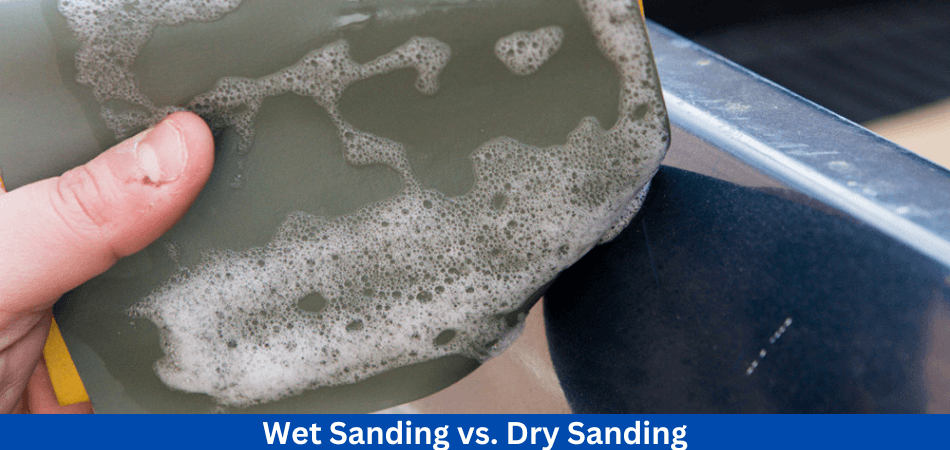
As the names suggest, wet sanding and dry sanding are very different. Let’s examine each process in more detail to understand the differences between them. Dry sanding adds just two elements to the mix for a smooth, lasting finish, while wet sanding just adds another.
Dry Sanding
Sanding without waterooking for a more aggressive approach, dry sanding allows you to take off more material in a quick fashion. Low-grit sandpaper is a great method for roughing in your project’s shape. Most often, small circles will used to remove material and minimize deep scratches when dry sanding by hand or with power tools.
All the dust and debris that fly off the surface during dry sanding can create a huge mess. Except for elbow grease, there is no lubricant needed. When dry sanding, you may need to begin with a lower grit of sandpaper and then finish with a higher grit when wet sanding.
Wet Sanding
Most projects finished with wet sanding. It may take some time to refine the surface with a light touch. Smoothing out details and achieving a more desirable finish are often achieved through wet sanding.
Sandpaper designed for wet sanding isn’t just lubricated with water during wet sanding. If you’re sanding bare metal, you can also use WD-40. To help reduce water tension on your sanding surface, you may even want to add a bit of detergent. Using this method can prevent deep scratches from caused by sandpaper catching.
Sandpaper used for wet sanding usually comes with a backing pad. When water soaks into the pores of the sandpaper, it becomes flimsy and easily folds back on itself. As well as preventing this from happening, the backing pad can also help create a smoother finish than simply using your hands. When wet sanding, your fingers’ ridges and valleys can easily translated to the surface, but not when using a sanding block.
Sanding blocks can also purchased for wet sanding. Sanding drywall is the most common application of this technique. In order to achieve a uniform finish when wet sanding, use linear movements. Every time you pass, you’ll alternate directions. Learn more about wet sanding here.
What are the Equipments Required for Wet Sanding?
Wet sanding requires several tools and equipment. These are as follows:
- Sandpaper
- Sandpaper squeegee/handle
- Bucket and water
- Car cleaning solution
- Sponge
- Microfibre cloths
- Car wax
- Polishing compound
- A buffer
- Cloth tape
Using the in-depth steps below, you can wet sand any scratches or scuffs in your car’s paintwork with the right equipment.
What are the Safety Equipments Required for Wet Sanding?
When wet sanding, dust, and debris are likely to created, so it’s important to take the necessary safety precautions. In addition to safety equipment, here are some things you’ll need:
- Goggles
- Respirator mask
- Gloves
A respirator mask protects your lungs from inhaling harmful particles while goggles protect your eyes from dust and debris. Sandpaper and chemicals used in the process will scratch your hands if you don’t wear gloves.
Before you begin wet sanding, make sure you wear all safety equipment. Priority should always given to safety.
How To Choose Sandpaper for Wet Sanding?
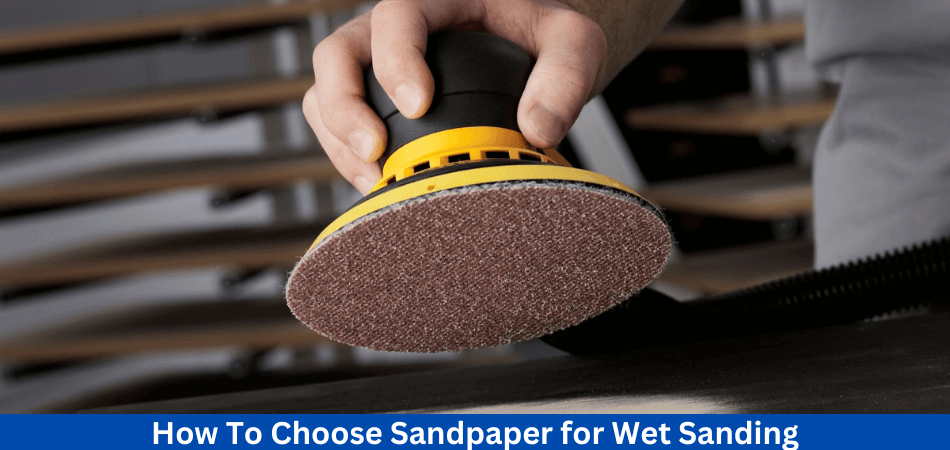
Selecting the right sandpaper is the first step in wet sanding a car. That’s why it’s so important. Therefore, you should pay more attention to the sandpaper you choose.
It is important to choose the right sandpaper for your car from the many types available in the market. As a result, you will damage the paint rather than create a great paint layer. The first thing you should do is check the problem with your car. Sandpaper with a 400-grit rating is a good place to start if you have a rough primer on your car. Using 400-grit sandpaper will remove any bumps on the surface. Sand the car with 600 grits of sandpaper after that.
In another case, 400 grits sandpaper works well when you wet sand a finished paint job. Sandpaper of 800 grits or 1000 grits level would be better in this case. Make sure you choose the right sandpaper for your car. Make sure you choose the right sandpaper when doing this job since a mistake could result in serious car damage. Next, let’s talk about wet sanding a car.
How to Wet Sand a Car: Step-by-step Guide
Step 1: Set up the wet sanding location and car
To wet sand car paint, it is important to find a good location. If you rinse the car, you should choose a place where the water won’t stain the floor and won’t remove some paint. If you are going to wet sand a part, you should clean it with water or soap first. This will give you a clear view of the car part so you can easily get in. Due to the fact that you will be using sandpaper. Sand and dust should not allowed to get stuck in the sandpaper as this will cause more scratches on the paint.
Step 2: Get the sandpaper and cleaning liquid ready
Cut the sandpaper into small pieces after removing it from the package. Depending on the part of the car you are wet sanding, it may be necessary to wet sand it. Meanwhile, prepare a bucket of water. Avoid using automotive soap that also acts as a wax or polish. Dish soap can substituted for automotive soap if you don’t have any. It is necessary to use a lubricant when wet sanding to prevent the sandpaper from burning the paint.
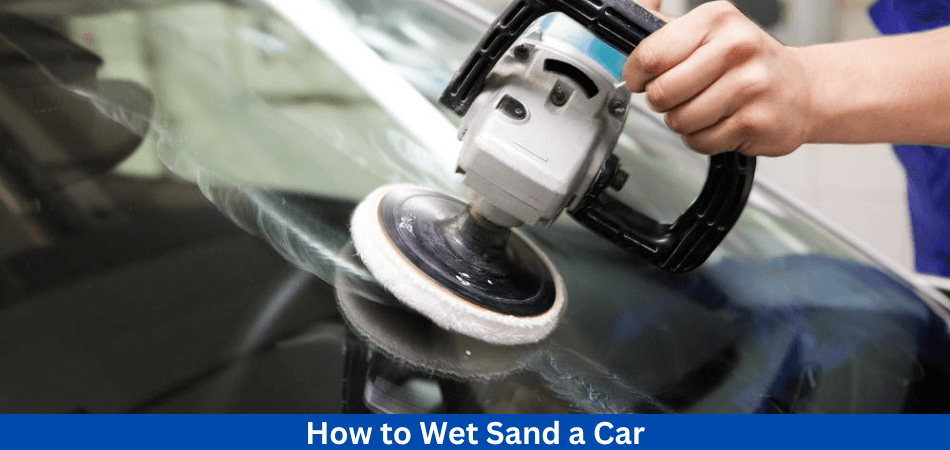
Step 3: Soak each sandpaper sheet for five minutes
Sandpaper must soaked for 5 minutes after being wet sanded for the third step. Place the sandpaper sheets along the edge of the bucket so half of each sheet soaked in soapy water. While the halves that are soaking in water should be completely submerged in soapy water, the dry part will help you secure the sandpaper.
Step 4: Start wet sanding
It is not a good idea to wet sand your car by hand. If you want to sand, you should use a squeegee or pad. It will prevent an inconsistent finish if the sandpaper placed on the sand pad. You can now start sanding gently in circular motions with a light amount of pressure. The paint surface should checked again after a few circles. It may be necessary to apply a little more pressure if the sanding does not seem to affect the clear coat. You will scratch your car if you put too much pressure on it. You will expend less energy if you sand your car gently to reduce blemishes.
Step 5: Use multiple directions to move the sandpaper
So The sandpaper needs to moved around now. To catch different angles, it’s a good idea to switch the direction of your circular motions periodically. As a result, the paint surface is even throughout. Sandpaper should not applied with different pressures in this step. You can check if you are applying the right pressure. The color of the paint should bleed into the water and tint it a little. The water will turn darker if you sand too hard. If you want to sand a larger area, you can add more water.
Caution:
- Your tools’ edges should handled with care.
- Take frequent breaks
- You should avoid scratching the paint with the handle of the tool or one of the edges of the sandpaper.
Step 6: Repeat The Process
So The car paint has already sanded. To ensure that the paint is evenly applied, repeat the process with a higher grit sandpaper. After the first stage of wet sanding, this will help remove any shallow scratches or abrasions.
In addition to sanding the car, this step also gives you the opportunity to repair any damage you have caused. There is, however, a limit to how much damage can fixed. During the sanding process, try to minimize mistakes.
Step 7: Clean the sand area
Your car should rinsed after sanding and resanding. Any soap or debris left on the vehicle should rinsed off with a hose. You will need to apply a glaze or wax once it dries, so be sure to rinse it thoroughly.
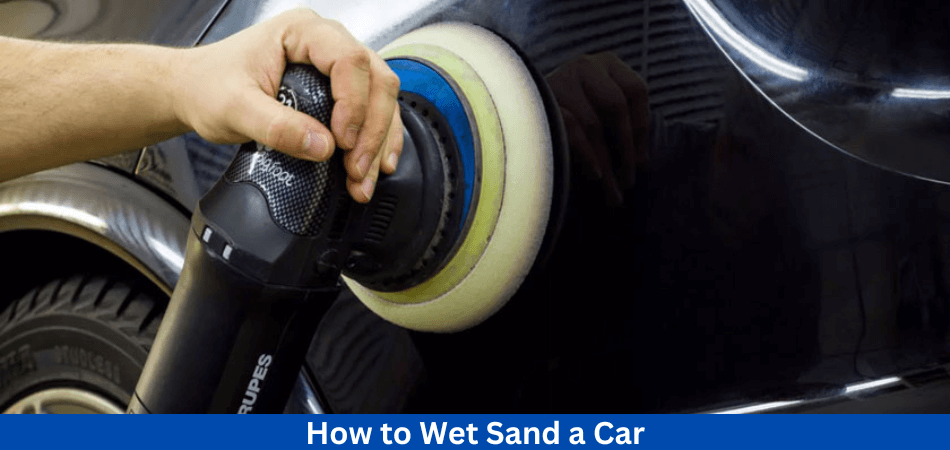
Step 8: Time for Buffer and Rubbing Compound To Polish
So The next step is to apply some rubbing compound to a buffer pad and then polish the area with a power tool. When buffing the rubbing compound into the paint, turn on the rubber, use a medium speed, and apply light pressure.
Do it gently, strong pressure on the paint can burn it, so start lightly and add more pressure only when necessary.
Step 9: Apply The Wax
As a final step in wet sanding a car, wax should applied to the paint layer. When you apply wax to the paint, it looks like the finished product even after buffing. You can think of it as a paint protection. Be sure to use high-quality automotive wax when sanding. Adding a wax layer can also help prevent the buffed area from fading at a different rate than the rest of the paint.
How To Know When To Stop Wet Sanding?
It’s important to be attentive when wet sanding; otherwise, your base coat can damaged. To cover the damage you have caused, your car will need to repainted.
Water can sprayed on the surface area to check your progress, and then a microfiber cloth can used to dry it. By doing this, you’ll be able to see how much more work you need to do.
The bucket water should also turn somewhat milky when the clear coat removed. There should be no color change in the water if there is no clear coat.
In both cases, color fragments in the water damage the car paint, which needs to repainted.
Tips for Achieving the Best Results During Wet Sanding
Are you looking to improve your wet sanding skills? We’ll explain how to achieve a high-quality finish in the following sections.
- Slow motion close-up of tattooing hands preparing the hood of a deep blue sports car for polishing
- Protect adjacent panels with cloth tape: Wet sanding can concentrate on specific panels, so using cloth tape can ensure that the non-damaged panels remain intact.
- Sanding machines might seem time-saving, but they can leave swirls in the paint and provide much less control than hand-sanding.
- When starting to sand, apply gentle pressure: You don’t want to damage your car’s paint by sanding too deep.
- If the sandpaper rubbed in back-and-forth motions using the same pressure levels, you can achieve an evenly sanded surface much more quickly.
How to Remove Haze After Wet Sanding? Guide Explained!
The rubbing of compound, wax, and grime on the surface of the car can cause hazing over time. Paint can become unattractive as a result. So How to remove haze after Wet sanding.
Well, you can remove hazing from your car’s paint with several products available on the market.
In order to remove the haze, you will need the following:
- Sandpaper (1500 and 2000 grits)
- Dupont compound
- Water
- Microfiber towel
- Dupont 7 polish
- Turtle wax
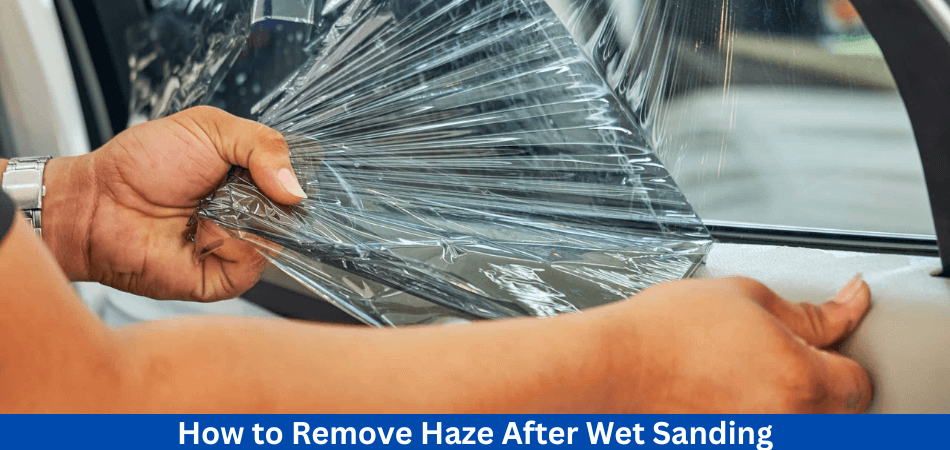
After wet drying, you need to remove the haze as follows:
- You won’t get a good finish if you use 1200-grit sandpaper. Sandpapers with 1500 and 2000 grit should be used. If you use 1200-grit sandpaper, you will need a compound that is aggressive to remove a lot of paint just to remove deep scratches. Quality paper, such as Meguiar’s Nikken 2000 grit, makes haze removal easy and fast.
- The Dupont compound should be used alongside a new 1-inch wool wheel on a Sioux buffer. When you sand, you will be able to remove cuts and scratches more easily.
- The compound residue can removed with a 50/50 solution containing isopropyl and water.
- Dry the surface with a microfiber towel and run your fingers through it to make sure the haze has removed. It might be necessary to repeat the process if the haze is still present or the surface is not smooth.
- To bring out the beauty, use a 2-inch wool thickness wheel, along with Dupont 7 polish. As a result, compounded wheels will no longer leave marks on the surface.
- To further remove hazing, use a high-grade wax such as turtle wax. Immediately after waxing, wash your car and thoroughly dry it.
- It is going to be an amazing result in the end. There should be a deep shine on it as if it polished glass. This is how to remove haze after Wet sanding.
Note: Keep your car out of direct sunlight when waxing. It is possible to scratch the paint easily when it heated by the sun.
What are the Benefits of Wet Sanding A Car?
1. Remove Deep Scratches
As a first step, it can help remove deep scratches. You can benefit from wet sanding your vehicle in this way. In addition, it can remove any debris that may have fallen on the freshly painted surface. Also, orange peel can removed by wet sanding.
2. Even Out new Paint
In some cases, new paint requires a few touch-ups, and wet sanding is an effective method to achieve an even finish. It is often used by professional automotive detailers to ensure that your car appears in pristine condition.
3. Level Touch-Ups for Easy Polishing
You can also use wet-sanding to level touch-ups on your vehicle, which makes polishing much easier. Wet sanding should always handled by a professional who specializes in the process. If you attempt to do this on your own, you run the risk of permanently damaging your vehicle’s paint.
What are the Potential Risks of Wet Sanding?
Wet sanding: What are the risks small scratches can be a great way to restore the paint job and achieve a smooth, glossy finish without having to take it to a professional. You should, however, be aware of the potential risks associated with this process.
- You can further damage the paint job of the car if you use the wrong materials or tools.
- If the paint sanded or buffed incorrectly, it may become uneven or discolored.
- Paint can become scratched or dull if not applied correctly.
Can You Do Wet Sanding with Soap?
While wet sanding your car, you should use soap instead of water. When you add soap to the wet sanding process, you can gain several benefits.
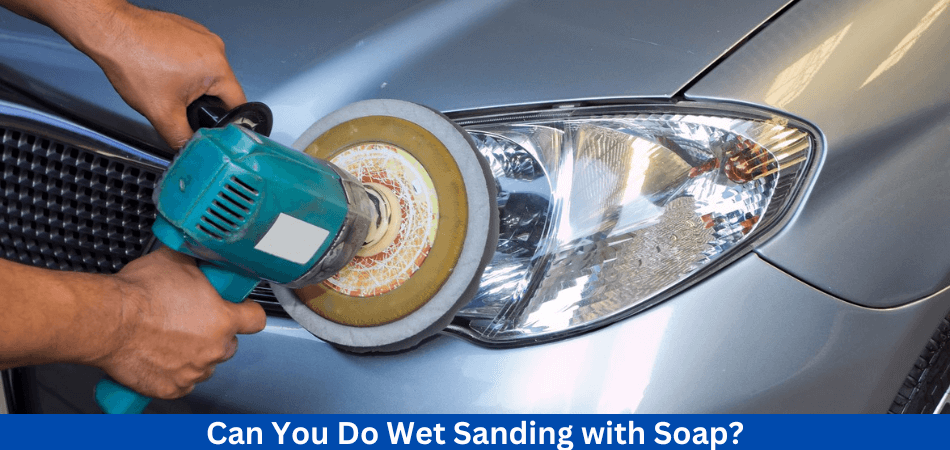
Reason 1: Lubrication
By lubricating the sandpaper, soap can reduce the amount of heat and friction generated during sanding. By adding soap, you make it easier to work on the surface, which reduces the risk of damage to the paint and body of the car.
Reason 2: Improved Finish
The second reason is that the finish has improved to produce a smoother, better finish on a surface. When it comes to car paint, this is especially true.
Reason 3: Reduced Dust
It is possible to reduce the amount of dust that generated during the sanding process by wet sanding with soap. The surface can seen and worked on more clearly as a result.
How to Know If Wet Sanding is Right for You?
Paint scratches and imperfections can’t all fixed by wet sanding. It can be difficult to repair scratches deep enough to expose the metal layer, for example. The use of wet sanding alone would not suffice for these cases.
In general, this method can used to restore scratches or imperfections in the clear coat or upper layers of paint.
When You Should Not Wet Sand Your Car?
By wet sanding your car, you will be able to save the paint layer. In some cases, you should not sand your car. When your car paint scratched too deeply, it’s time to fix it. Thus, sanding your car is more likely to cause harm than good if you insist on doing so. You should not do it if your car has a deep scratch.
Conclusion: How to remove haze after Wet sanding
Now you have some idea of How to remove haze after Wet sanding. To avoid regrets, wet sanding or removing haze after wet sanding should be done properly. Care must be taken to follow the processes meticulously.
After wet sanding, it can be disappointing to experience haze. When the steps are not followed properly, removing it can also be stressful. It is important to take your time when working on the car paint and to avoid damaging it.
Wet sanding your car or removing the haze after wet sanding will not be difficult if you follow the process. To remove the haze or wet sand in your driveway, you can always hire a professional. You will spend some money, but if you are an amateur, you will not have to deal with the stress and damage to the vehicle’s exterior. Read more of our articles here, like “How to Remove Haze After Wet Sanding”
FAQs
What causes the haze to form after wet sanding?
It formed when fine sanding particles and debris mixed with water during wet sanding and then dry on the surface, resulting in a cloudy or hazy appearance.
How can I prevent haze from forming during wet sanding?
Sandpaper should always be clean, the surface should be rinsed frequently during the process, and haze should minimized. It is also possible to prevent excessive haze by using the right sandpaper grit and technique.
How do I remove haze after wet sanding?
A buffer or polishing machine (optional) may also needed along with clean water and clean, soft cloths or microfiber towels.
What is the first step in removing haze?
Remove any loose particles from the sanded surface by thoroughly cleaning it. On a clean cloth, apply a small amount of polish or compound.
To remove haze, what type of polish should I use?
Make sure you choose a polish or compound that is specifically designed for the material you are working on. For example, automotive clear coats require different products than wood finishes.
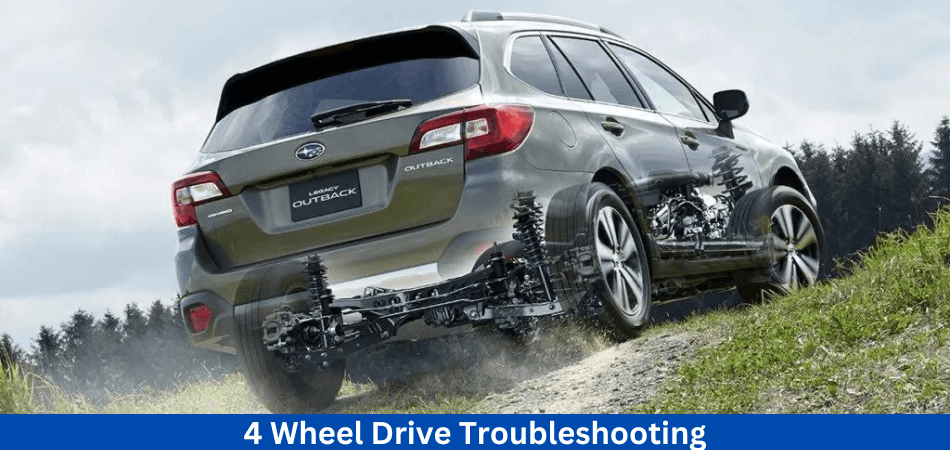
The four-wheel drive is robust, however, there are sometimes niggly issues that require immediate attention. Suppose your four-wheel drive refuses to engage. What is the cause of this and how you can do 4 wheel drive troubleshooting?
Examine the 4WD actuator to see if it is functioning properly. There is a solenoid and electronic switch used in modern 4WDs that need to checked if the 4WD light is blinking on the dash but the system isn’t engaging. Corrosion should checked on all related wires. It is also important to engage your 4WD system once a month to keep it well lubricated.
In the next section of this article, we will explain what an drivetrain is, why we should keep our 4WD system well-lubricated, and how to troubleshoot the transfer case module. You can read more about your 4WD system, including 4 wheel drive troubleshooting.
What Is A Drivetrain?
Drivetrain refers to the mechanism that supplies power to the wheels without including the engine. A vehicle’s drivetrain can designed to send power to either one set of wheels or all four wheels depending on its utility. The following is a detailed explanation of each configuration:
1.Two-wheel Drive (2WD):
A two-wheel-drive system directs engine power only to two wheels. Either the front wheels or the rear wheels can used. The engine of a front-wheel drive car arranged transversely, i.e., perpendicular to the vehicle’s axis. Direct connection of the engine to the front wheels enabled by this layout. Rear-wheel drive cars have their engines arranged longitudinally, meaning they arranged along their axis. Transmissions use driveshafts to connect the engine to the rear wheels.
2. Four-wheel Drive (4WD):
An all-wheel drive system connects the engine to and sends power to all four wheels by combining the FWD and RWD systems in tandem. Four-wheel drive systems can either operate at all times or switch between 2WD and 4WD as needed.
What is a Four-Wheel Drive (4WD)?
Differentials fitted to the front and rear axle assemblies of part-time 4WD systems. Power transferred from the diff to the wheels through the axle. Differentials are the big round bell housings you see underneath trucks, usually on the bottom. In 2H, power transferred to the rear final drive and differential gears through the rear propeller shaft or driveshaft. The system is similar to that of rear-wheel-drive cars with front-mounted engines.
When the vehicle turns left or right, the rear differential gears allow the rear wheels to turn at different speeds. As each wheel continues to receive equal torque.
With 4WD engaged, the transfer case connects the front and rear axles and transmits equal power to the front and rear driveshafts. Each axle assembly transmits the drive to the other.
On slippery, uneven surfaces, 4WD dramatically improves the vehicle’s ability to acquire and maintain traction.
Due to the swiveling of the front wheels, the turning circle is wider than that of the rear wheels, causing a difference in rotational speeds between the two. Thus, the propeller shafts (driveshafts) at the front and rear move at different speeds.
Both axle shafts turn at different speeds due to the difference in speed between the inner and outer wheels. There can also be differences in speed resulting from uneven tire wear between the front and rear wheels or different inflation pressures.
How Four-Wheel Drive (4WD) Works?
In slippery conditions, 4WD dramatically enhances the vehicle’s ability to maintain traction. Because four wheels are better than two, you now have all four clawing for traction and propelling the vehicle forward, regardless of the surface conditions.
The vehicle you are driving has two wheels and is stuck in mud or snow with two wheels. There is no traction on the wheels in the mud/snow and the vehicle cannot propelled forward. The other 2 wheels of a 4WD vehicle will pull the vehicle out since 50% of the power split between the 2 wheels with good traction.
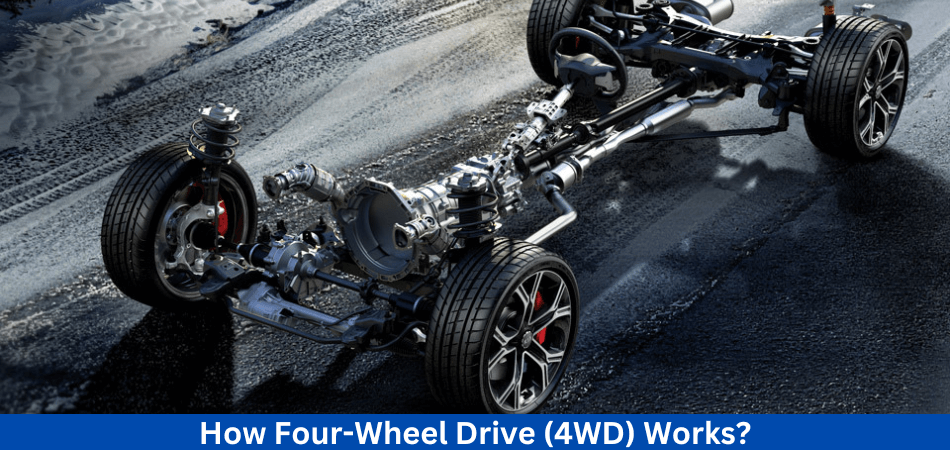
When to Use Four-Wheel Drive (4WD)?
When traction on the surface limited, four-wheel drive should engaged. Our advice is to engage 4WD as soon as the tarmac left behind. Since the rear wheels are pushing and the front wheels are pulling, the vehicle is more stable on slippery roads.
4H Driving in 4×4 mode allows you to drive over and through slippery, low-traction surfaces while maintaining a normal driving speed. These are the ideal 4WD conditions:
- Loose Sand
- Snow roads
- Ice-covered roads
- Gravel roads
- Wet roads
- Slippery low traction surfaces
- Muddy tracks
What Types of Four-Wheel Drive (4WD) Are There?
1. All-Wheel-Drive (AWD)
A Providing power to all four wheels of a vehicle through a front, rear, and center differential.
2. Part-Time-AWD
Until traction lost, part-time all-wheel drives operate like front-wheel drives. As a result, power will automatically sent to the rear wheels to maintain traction.
3. Part-Time 4WD
Drivers can select the best drivetrain mode for specific driving conditions by switching on and selecting 4DW.
4. Full-Time-4WD
Throughout all terrains, power is continuously delivered to all four wheels.
Advancements In Four-Wheel Drive (4WD) System
Electronics and differential design play a major role in any advancements in the 4WD system.
In order to overcome the disadvantage of simple differentials: the loss of power at the wheel with the least traction, locking and limited-slip differentials developed. A variety of vehicle types equipped with partial 4WD, full-time 4WD, or all-wheel drive systems.
Electronic actuation and sensor technology have eliminated the need for manual engagement of 4WD systems by locking differentials and driveshafts. Based on the terrain, the vehicle’s onboard computer selects the most optimum settings, so the driver doesn’t have to worry about anything.
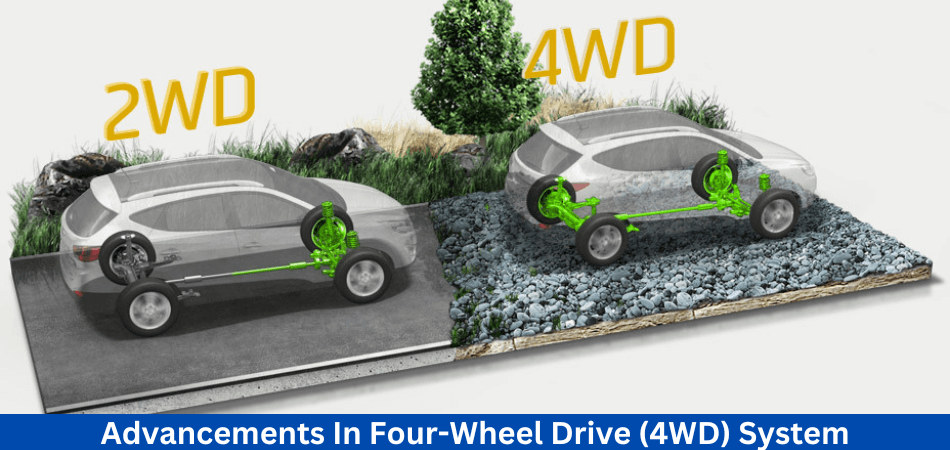
What are the Pros And Cons Of A Four-Wheel Drive (4WD) System?
Four-Wheel Drive (4WD) Advantages
- Power and traction are the main benefits of 4WD. Have you ever seen those Jeep commercials where it climbs boulders and rocks? Here’s an example of 4WD in action.
- If For climbing steep hills or off-roading, you will need more power to get over obstacles and climb steep hills. You may not need 4WD if you are off-roading, but 2WD will get you over even the steepest San Francisco hills.
- 4WD improves traction in difficult driving conditions, such as snow, ice, rocks, and other situations. Traction and control improved when both sets of wheels engaged.
- A heavier vehicle has a better grip on the road due to its increased weight.
- If you enjoy off-roading, 4WD is a great choice.
- A four-wheel drive will greatly benefit you if you frequently drive in low-traction conditions or enjoy off-roading.
Four-Wheel Drive (4WD) Disadvantages
- In It is not necessary to use 4WD in most cases. This increases fuel consumption and leads to overconfidence, resulting in more situations where you can get stuck. Using 4WD only when necessary will save you money and fuel.
- The main disadvantage of 4WD is the added cost of purchase, maintenance, and fuel. Additional equipment (differentials, transfer cases, etc.) increases the initial market value, tire wear, and repair and maintenance costs of the vehicle.
- Compared to 2WD systems, 4WD and AWD systems use more fuel because of their added power and weight.
- As weight added, traction and control improved, but stopping distance increases. The lighter the vehicle, the easier it is to avoid a collision.
- It is common for drivers to become overconfident in 4WD and AWD, which, ironically, leads to more situations in which they become stuck.
- Even though 4WD provides better traction, you should take extra care on slick, icy, or snowy roads. A dangerous accident can result from overconfidence.
What Are The Benefits Of A Four-Wheel Drive (4WD)?
There are many benefits of having a car that is 4-wheel drive including-
1. Elevated driving position
The 4-wheel drive might be the right choice for you if you prefer to drive your car higher off the ground. A higher driving position gives you better visibility on the road, and makes accessibility easier, and people often feel a greater sense of safety.
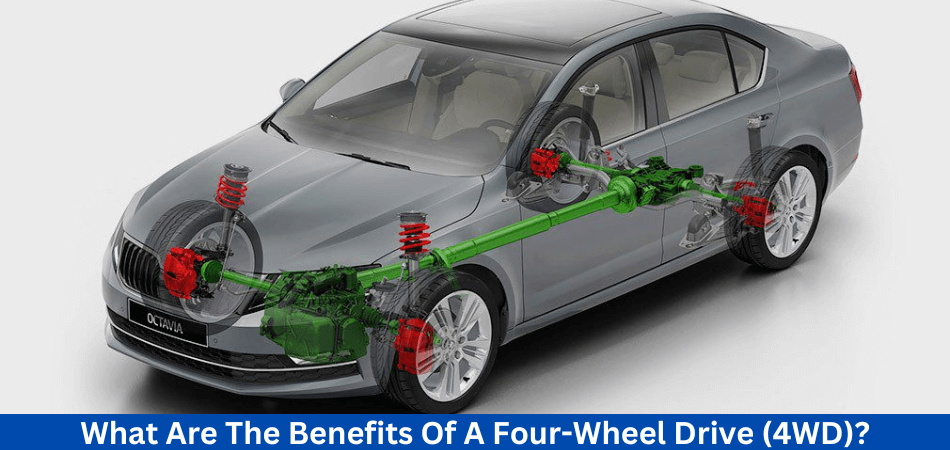
2. Off-roading
Offroading is exactly what 4-wheel-drives designed for. Your 4×4 is capable of handling tricky terrain that most struggle with when out and about. An adventurer’s dream, this vehicle is a great choice. It’s safe to pack up your camping and hiking gear knowing your car can handle it.
3. Towing
If you need to tow when you’re out and about, your 4×4 has got you covered. In addition to its 1700-kg towing capacity, the Skoda Kodiq can tow a maximum of 2000kg! Before you set off, make sure you know your vehicle’s weight limits so that anything you’re towing doesn’t exceed 85% of the vehicle’s towing capacity.
4. Space & Storage
Choosing a 4-wheel drive might be the best choice if you value interior space when looking for a new car. Likewise, 4x4s have adjustable and removable seating, and their elevated height makes getting in and out super easy. This also means less back-breaking work when installing child seats if you have children.
What are the Problems With Four-Wheel Drive (4WD)?
The convenience of having 4-wheel drive when you need it most is obvious to anyone who owns a 4-wheel drive vehicle. You can rely on your 4WD to save the day, regardless of whether you enjoy regular adventures or find yourself in a tricky spot. However, you should understand that problems can arise from time to time with any vehicle part. Therefore you might need sometimes 4 Wheel Drive Troubleshooting.
1. Indicator Issues And Signaling Problems
You’ll notice an indicator light on your dashboard displaying inaccurate information when your 4WD system doesn’t engage properly. The problem needs to corrected by a qualified mechanic. It is possible that the gear hasn’t been completely shifted if the indicator light blinks constantly.
2. 4WD Stuck
It is possible for older 4WD vehicles to remain in 4WD mode while their engines are running. This will result in a constant blinking of the indicator light. It is usually possible to resolve this problem by shutting off the vehicle’s engine and starting it again. Driving in reverse for 12 feet is another option. In order to disengage the 4WD, you must shift to drive. The final option, if none of the above methods are successful, is to run your vehicle in low gear. Put your car in two-wheel drive before turning it off while you’re driving. A skilled mechanic will needed if nothing helps.
3. Shifter Fork Damage
During the transfer shift work, the lever moved from 4WD to normal drive. It is possible for the shifter fork to become damaged due to the great amount of pressure, which will cause the system to slip from normal to 4WD. A professional will need to replace the damaged or faulty shifter fork.
4. Problems With The Chassis
After experiencing a few adventures, your 4WD vehicle is likely to have encountered some rough terrain. As a result of this kind of use, the chassis can crack, and rust can also develop due to rain and moisture. It is important to address rust sooner rather than later to minimize damage. It’s a good idea to ask about rubberizing solutions after cleaning and repairing the problem area if necessary.
5. Suspension Problems
When you drive your 4WD vehicle on hard roads regularly, the suspension can also suffer. A mechanical problem can result in chassis damage, so you should always be on the lookout for it. Among the parts that should inspected regularly are nuts and bolts, the steering rack, and your shocks. You will feel those bumps if you have worn or damaged shocks! Furthermore, faulty shocks compromise your vehicle’s traction. The worse your shocks, the more your vehicle bounces and the less it sticks to the road.
Wear and tear are inevitable, but you can make sure that you inspect your vehicle and watch out for signs of trouble. Additionally, you can enjoy peace of mind and coverage by choosing the right extended warranty for your 4WD vehicle.
6. Unresponsive 4wd System
Often, an unresponsive 4WD system caused by a faulty 4WD switch. In spite of differences in car makes and models, the basic functionality of a 4×4 system is often the same. The 4WD actuator locks the vehicle’s front and rear differentials together when the four-wheel drive mode selected. By doing this, both axles rotate together in uniform motion, bringing all four wheels into motion at the same time.
An actuator can delayed or not respond correctly if the 4+4 switch malfunctions. As a result, the 4WD system also fails. Faulty 4WD switch systems characterized by this symptom. Vehicles may also become stuck in 4WD mode as a result of this problem.
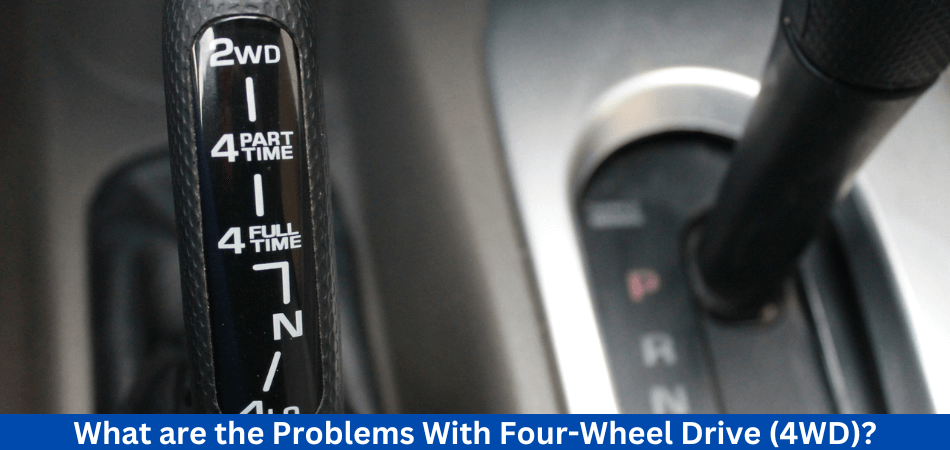
7. Lights Flashing On The Dashboard
Indicators for 4WD modes are typically found on dashboards of cars equipped with four-wheel drive systems. In the event of a malfunctioning 4WD transfer switch, the indicator light may flash or blink continuously.
There are also other underlying problems that can cause the 4WD indicator to flash on the dashboard. To ensure vehicle safety and proper maintenance, a driver should be familiar with all dashboard warning lights.
8. Repetitive Disengaging From 4wd Mode
It is also indicative of a failing 4×4 switch if the car repeatedly disengages from 4WD mode without any input. In order to accurately diagnose and resolve a problem with a bad 4WD switch, it is important to monitor these common symptoms.
4 Wheel Drive Troubleshooting: How to Fix Your Faulty Four-Wheel Drive (4WD)?
Wondering about 4 Wheel Drive Troubleshooting. You might face the above mentioned problems that will require 4 Wheel Drive Troubleshooting. Here are the troubleshooting tips for you.
1. Engagement Issues:
Be sure you follow the instructions in your vehicle’s manual when engaging and disengaging 4WD. The transfer case shift linkage or electronic controls may need to lubricated or replaced if problems persist.
2. Strange Noises:
For any damaged or worn components, inspect the differentials, axles, and transfer case. Parts should replaced or repaired as necessary. Noises that are unusual may indicate problems with the gearsets, bearings, or seals.
3. Vibration or Shaking:
Make sure that the driveshafts, u-joints, and CV joints are in good condition. If any components worn or damaged, they need to replaced in order to prevent vibrations or shaking. Make sure the tires balanced and in good condition as well.
4. 4WD Not Working:
If the 4WD doesn’t engage at all, make sure the transfer case, the front axle, and the differential are not damaged. Ensure that there is no leak or blockage in the vacuum lines (if applicable). Any damaged components should repaired or replaced. A diagnostic scanner should used to diagnose and fix electrical problems.
5. 4WD Warning Light On:
Read the error codes stored in the vehicle’s computer using a diagnostic scanner. It is possible to pinpoint the problem by looking at these codes. Electrical problems, sensor malfunctions, or problems with the 4WD actuator could be the cause. According to the error code, resolve the specific issue.
6. Fluid Leaks:
Locate the source of the leak, which may be the transfer case, differential, or axle seals. Replace or repair damaged seals or gaskets. Be sure to use the correct type and amount of fluid when refilling.
7. Difficulty in 4WD Engagement:
If you have trouble engaging 4WD, try driving forward or backward a short distance to help the components mesh. Ensure that your vehicle is on a flat surface. Consult your vehicle’s manual for specific engagement instructions if problems persist.
8. Regular Maintenance:
The importance of preventative maintenance for 4WD systems cannot overstated. Inspect and grease components, change fluids, and check for signs of wear according to the manufacturer’s recommended maintenance schedule.
4 Wheel Drive Troubleshooting – Information Messages
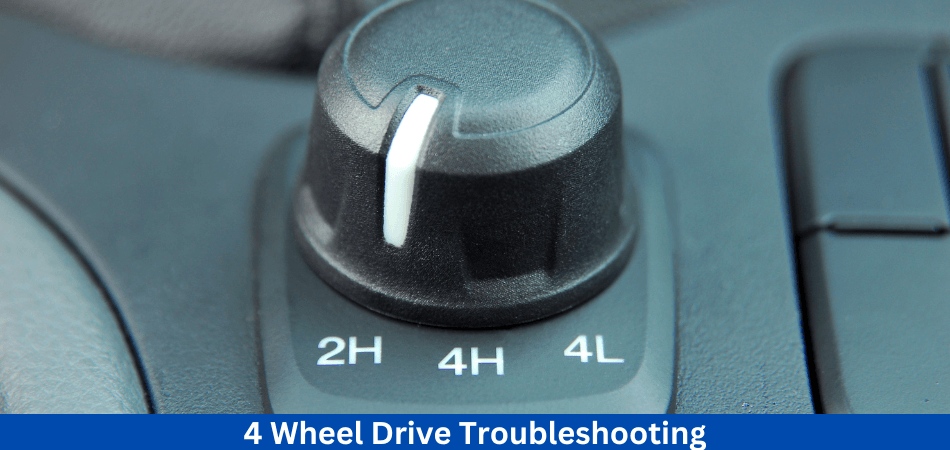
- For 4L slow to a stop: Activates when driving too fast and trying to switch to four-wheel drive low.
- For 4L Shift to N: Shows when the driver attempts to shift into four-wheel drive low without the transmission in neutral (N).
- For 4L press Clutch: Signals when the clutch pedal is not pressed when shifting into four-wheel drive low.
- To exit 4L slow to a stop: Activates when the driver tries to shift out of low-range four-wheel drive.
- To Exit 4L Shift to N: Displays when shifting out of four-wheel drive low without the transmission in neutral (N).
- To exit 4L Press Clutch: Displays when the clutch pedal is not pressed when shifting out of four-wheel drive low.
- 4×4 Shift in Progress: Shows whether the four-wheel drive system is shifting into or out of two-wheel drive high.
- 4X4 Temporarily Locked: Signals a situation in which more four-wheel drive performance is temporarily required. Once these driving conditions are no longer detected, the system resumes normal operation.
- 4×4 Temporarily Disabled: Displays when the four-wheel system detects elevated temperatures and temporarily disables the front wheels. Upon returning to normal system temperature, the system resumes normal operation.
- 4×4 Restored: Indicates when the four-wheel drive system has restored to normal operation.
- Shift Delayed Drive Forward: Indicates a shift cannot completed and forward motion required.
- 4×4 OFF: The system disabled when the tires mismatched or there is an external problem.
- Neutral Tow Enabled Leave Transmission in Neutral: This display indicates whether neutral towing has been successfully engaged.
- Neutral Tow Disabled: Indicates that neutral tow mode has disengaged successfully.
How to Maintain the Four-Wheel Drive (4WD)?
Keeping your 4WD system (Four-Wheel Drive) maintained will ensure its reliability and safety. For your 4WD vehicle, here is a maintenance checklist:
1. Regular Inspections:
Make sure the 4WD system is regularly inspected for visible damage, loose or worn components, or leaks. Ensure that driveshafts, u-joints, differentials, and axles are in good condition.
2. Fluid Changes:
Change the fluids in the transfer case, front and rear differentials, and manual locking hubs (if applicable) according to the manufacturer’s recommendations. Fluids should used according to their specifications.
3. Greasing:
The u-joints, CV joints, and any other grease fittings should lubricated as necessary. Vibration minimized and wear reduced with proper lubrication.
4. Tire Maintenance:
Make sure your tires are properly inflated and rotated on a regular basis. Tire treads that are excessively worn should replaced.
5. Alignment:
Make sure your 4WD vehicle aligned regularly. Uneven tire wear and handling problems can result from misalignment.
6. Brake System:
Make sure your vehicle’s brake system maintained, including brake pads, rotors, calipers, and brake lines. Off-road and on-road safety depend on properly functioning brakes.
7. Suspension Components:
Replace worn suspension components such as bushings, shocks, and struts as necessary. Proper handling and ride quality ensured by a well-maintained suspension system.
8. Electrical Components:
The electrical components of your 4WD system, including switches, sensors, and the 4WD control module, should inspected and tested. Any malfunctioning parts should replaced as soon as possible.
9. Air Filters:
Clean air is essential for optimal engine performance, so make sure the air filter replaced regularly. Fuel efficiency and power can reduced by dirty air filters.
10. Battery:
Make sure the battery is securely mounted and that the terminals are not corroded. Be prepared for winter weather, as cold temperatures can strain batteries.
11. Exhaust System:
The exhaust system consists offhaust system for leaks, rust, or damage. Engine performance and fuel efficiency can reduced by a damaged exhaust system.
12. Off-Road Driving Maintenance:
If you frequently use your 4WD vehicle off-road, you should be especially diligent about maintaining it. After off-road excursions, clean the mud and debris from under the vehicle and inspect the undercarriage for damage.
Conclusion: 4 Wheel Drive Troubleshooting
Now you might have some idea of 4 Wheel Drive Troubleshooting. Engaging your 4WD system periodically is a valuable exercise. It will not necessarily prevent your 4WD components from packing up, but it will alert you beforehand if it does. Lubrication-wise, this is an excellent exercise for keeping 4×4 drivetrain components well lubricated and protected from moisture build-up inside differentials. To prevent corrosion, inspect all electrical cables to vital 4WD components and spray them with a good silicone spray.
Check smallest items first, such as dashboard switches, wires, connections, lubrication levels, and then electronic components and the diff actuator switch when troubleshooting.
Read more of our articles here.
FAQs
What is causing my 4WD to not engage?
This issue can be caused by several factors, including a faulty transfer case, a broken drive shaft, or an electrical problem. Having it diagnosed by a mechanic is essential.
What is the best way to tell if my 4WD is engaged?
When 4WD is engaged, an indicator light appears on the dashboard. It can also be tested by driving slowly on a loose surface (such as gravel) and feeling if all four wheels are pulling.
What does a blinking or flashing 4WD light mean?
4WD lights blinking often indicate a problem with the system. Possibly, the transfer case has low fluid levels, or there is a sensor issue.
Is it possible to switch my 4WD on and off while driving?
It depends on the 4WD system in your vehicle. While some can be shifted on the fly, others require stopping and shifting into 4WD.
How do I get my 4WD out of 4WD mode?
If In case you are unable to shift out of 4WD, try stopping, shifting into neutral, and then shifting back into 2WD. Consult your vehicle’s manual or a mechanic if that doesn’t help.
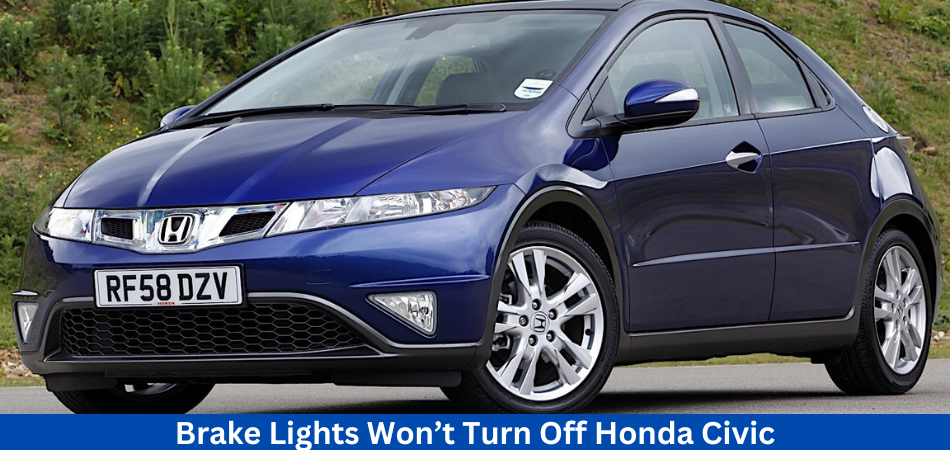
Having trouble turning off the brake lights on your Honda Civic? Read this article to find out why Brake Lights Won’t Turn Off Honda Civic. The brake system is one of the most important parts of a vehicle. It is possible to cause an accident or receive a ticket due to a faulty brake.
It is important that you keep track of the condition of your brakes if you drive a car that uses brakes. Ensure that the brake fluid and engine oil are at the proper levels. Check either of them if you notice they are not in proper condition before they cause more damage.
Lights are another aspect of your brake system that you need to take into account. Brake lights can be difficult to turn off, which is one of their most common problems.
Drivers may wonder whether they need to turn off their vehicles if their Brake Lights Won’t Turn Off Honda Civic. If this occurs, it is a sign that there is a problem somewhere, and you need to have it diagnosed. Check out this post about how to fix if Brake Lights Won’t Turn Off Honda Civic.
Why Do The Brake Lights Stay On The Honda?
In a Honda Civic, brake lights indicate that you’re braking; therefore, other drivers should do the same. If the brake lights won’t turn off, you and your passengers, as well as motorists behind you, could be at risk.
It is common for people to confuse tail lights with brake lights and vice versa. A tail light will turn on when either the headlights or parking brake activated. In order to indicate that the driver is braking, the brake lights will illuminate.
After pressing the brake pedal, the stoplight switch completes the circuit, turning on the brake lights. A faulty brake light or circuit error most likely caused the brake lights not to go off. You can confirm this by checking the fuse and the brake switch located under the dashboard.
Why Do Brake Lights Stay On When Car Is Turned Off?
Turning off the car can cause the brake lights to come on. It can happen if the brake switch malfunctions or if the brake pedal is stuck. The brake switch might need to repaired or replaced. Depending on the extent of its damage, you will decide what to do. One of the most common reasons why the brake light continues to illuminate even when the car turned off is a faulty brake switch.
A stuck brake pedal is another reason for this. Because the pedal isn’t closing the switch properly, the brake lights won’t turn off. There will be no solution until the problem resolved.
How Do You Deal With Brake Lights That Stay On?
It may drain your battery if your brake lights don’t go off. Until you find a solution, you will need to turn off the car and disconnect the battery. In the case that your Honda civic’s brake lights won’t turn off, it is very likely that the brake light switch is faulty and needs to repaired.
Check if the lights will go off by removing the brake light switch plug. When you remove it, the brake light switch will turn off, and you will need to replace it. Honda Civic brake lights won’t turn off when the brake pedal is stuck, which is another reason. It won’t work unless the connection between the switch and pedal fixed.
How To Disconnect The Brake Light Switch?
First, you need to remove the battery from your car before you can disconnect the brake switch. The purpose of this is to prevent electric shock while you are fixing it. In order to stop the current flowing in the vehicle, you must remove the negative terminal. You can find the switch above the brake pedal once you have done that. There are wires connected to the box. The last step is to remove the connector from this switch. For the connector to come out, you only need to press the plastic tabs.
If your switch is older, you might need a wrench to loosen the nut before unscrewing it. New switches, however, must rotated counterclockwise to removed. It is not difficult to disconnect the switch.
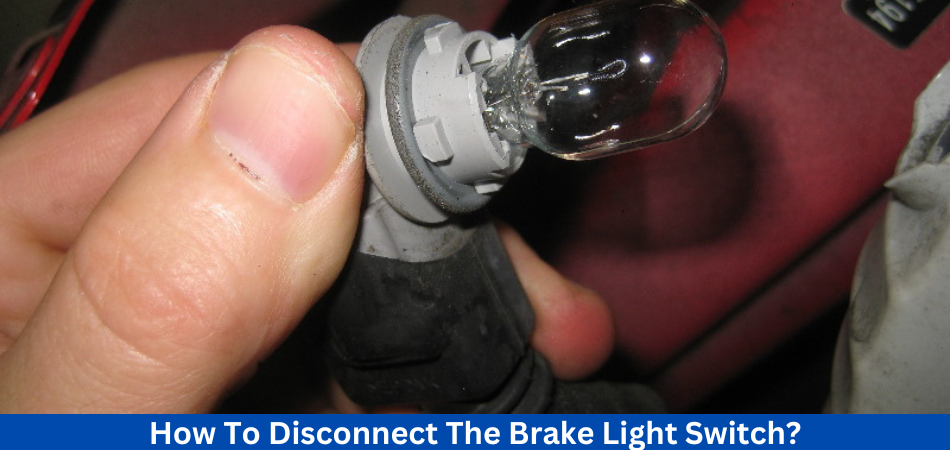
Why Brake Lights Won’t Turn Off Honda Civic? 7 Key Reasons
Are you wondering why Brake Lights Won’t Turn Off Honda Civic. Let’s learn the reasons.
1. Defective Brake Switch:
If It is a common problem for brake lights to stay on when the switch is not working properly. To avoid accidents, it is necessary to fix or replace an ineffective brake switch. A new Honda Civic brake light switch should installed if the brake switch becomes old. It is highly compatible with Honda Civic 2001 to 2013 so I prefer to use the HERCOO Brake Stop Light Switch.
2. Stuck Brake Pedal Spring:
The lights won’t go off when the brake pedal is stuck and not close enough to switch. This is primarily due to the spring losing power when it returns to its default position.
As long as the pedal and switch are not connected, the brake lights will remain on. A professional service can assist you in resolving this issue.
3. Faulty Wiring:
In some cases, brake lights won’t turn off due to faulty wiring. It may be a big problem if you’ve tried every basic method to fix the brake lights, but they’re still on. A professional technician should consulted in this situation.
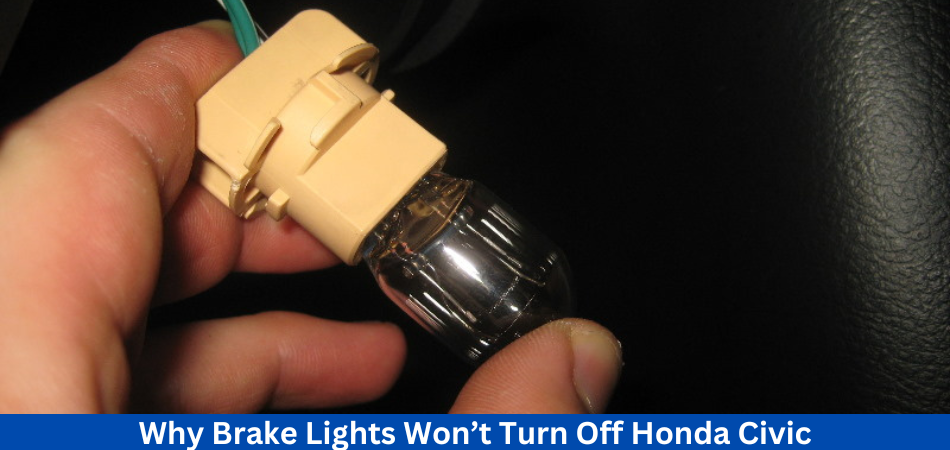
4. Switch stopper issue:
Having a problem with the brake light switch stopper on your Honda Civic is another reason your brake lights won’t turn off. You should check the floor of your car if your stopper is missing. It needs to replaced if you can’t find it.
5. Bad Electric system:
Another significant problem is a poor electric system. All electric lines should checked and everything should be working properly.
6. Faulty fuse diagram:
ThiDiagram with faulty fuses on the lid of the box will assist you in locating the brake fuse. Check if it has blown out if you find it. In this case, you must replace it with a Genuine Honda Multi Block Fuse for Honda Civic brake lights.
7. Socket Issue:
If In the event that none of the above points work, the last option is to check whether the socket is dirty or corroded. A middle link responsible for turning on the brake lights may also worn out in the wiring.
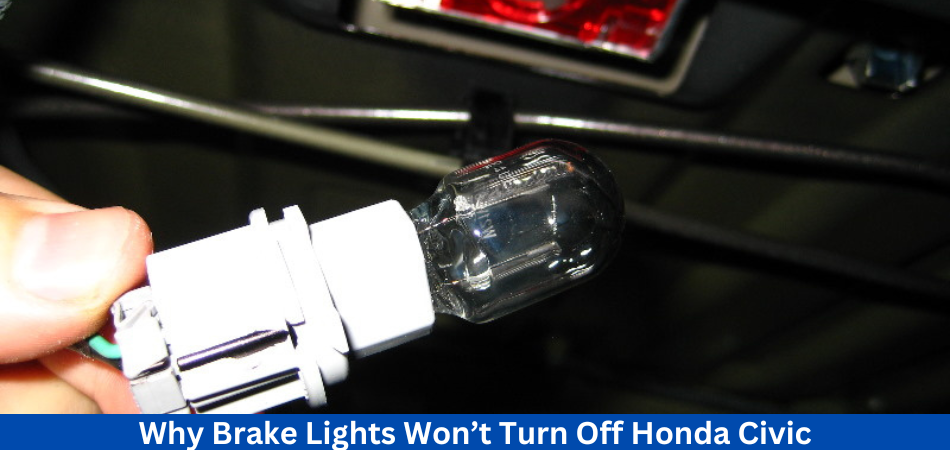
How To Fix if Brake Lights Won’t Turn Off Honda Civic?
There are some common issues you can fix yourself when your Honda Civic brake lights won’t turn off, making your problem a solution at first glance.
Here are six simple ways to fix the problems:
Solution 1: Repair The Brake Lights Switch
- To avoid shock, disconnect the battery before working on the car’s electric system.
- Remove the cable and tuck it into the side of the battery. Disconnect the negative terminal from the positive terminal.
- Locate and detach the damaged terminal.
- To get the cable to the battery terminal, use a socket jerk to lose the nut.
- Disconnect the wiring pigtail from the brake pedal switch
- Make sure it is not damaged now
- Ensure that the switch’s return is working properly.
Solution 2: Replace New Brake Lights Switch
- Near the brake pedal are the brake light switches, which are two-way switches. A defective light circuit in the car’s electric system can completed with it. What is the installation process?
- If you wish to reuse the same pigtail hitch later, disconnect it and tuck it away for safety before removing the brake lights switch
- From the pedal linkage, remove the brake switch.
- You can reuse it and install a new brake light switch (remember to keep the top hardware).
- You can use electrical tape to hold the harness in place while it is being installed if it is accidentally released.
Solution 3: Replace Blown Fuses
- The manual guide will help you find the fuse boxes. Under the hood and on the driver’s side of the cabin, there are fuses that need to replaced.
- To access your fuse box, remove the interior trim parts of your car. In addition, if you have a brake light that has blown, you must check more than one fuse.
Solution 4: Disengage The Car Battery
- If You need to drain the battery if the Honda Civic parking brake light stays on or does not work. When you encounter this problem, detach the battery while your car is off.
- It Not only does it prevent the brake light from trapped, but it also prevents the battery from running out of power while the issue is being resolved.
- If the hood latch is electric, ensure it disconnected before disconnecting the negative terminal. Make sure to test the brake as soon as possible if the brake lights still don’t turn off.
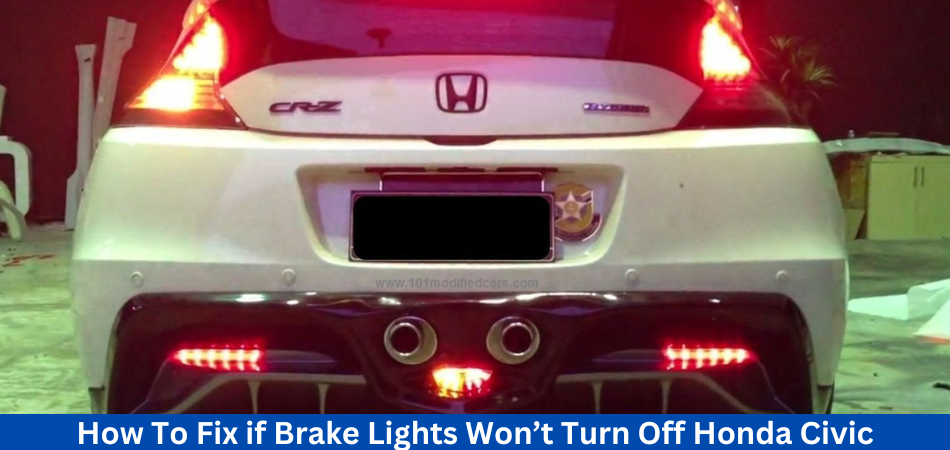
Solution 5: Clean the Brake Socket and pedal
- Your Honda Civic brake light does not turn off because of a dirty connection or worn wiring. So make sure the brake lights don’t get trapped in the sockets by cleaning them out.
- If the sockets do not work after cleaning, replace them by snipping the older wires or linking them to a new unit like the Dorman Honda Civic brake light socket.
- There is also a possibility that your 2005 Honda Civic brake lights will not turn off due to a dirty brake pedal. Possibly there is a defective rubber stopper between the switch and the pedal or there is rust between the switch and the pedal.
- To Protect the brake pedal from it, keep it clean, and keep it corrosion-free. Contact a professional service if the cleaning process isn’t working.
Solution 6: Replace Honda Civic Brake Lights
This video shows how to replace the brake light bulb on a Honda Civic from 2006 to 2012 and how to turn off the brake lights on the Honda Civic.
- The two screws can opened with a flathead screwdriver.
- The brake light held by a counterclockwise screw. You can take it out with a plier, even though it’s pretty tough.
- You can now easily remove the light from the housing with two hands.
- Make sure you know the size and features of the bulb so you can replace it with one with similar features. My recommendation here is to pick new brake lights for the Honda Civic. Double flare lights should used if there are three wires.
- Additionally, you can download and install the upgraded version of Alla Lighting. The AUTOONE brand also offers alternative Brake Light Bulb.
- Connect the new bulb and remove it the same way you removed the cable. The light needs to linked properly by simply pushing here.
- Go You can use a screwdriver or your hands to fix the clips again. That’s all there is to it. The procedure for changing another brake light is the same. Save your car from any accidents with your new brake lights.
Why Honda Civic Parking Lights Won’t Turn Off?
If you press the brake, the parking lights will come on and should turn off as soon as you release the brake. It is an indication that there is a problem with the system if the parking lights are still on after parking. Battery drain resulting from parking lights is not as great as that caused by headlights, but it is still significant.
It is common for switches to fail when this happens. After the handle has jiggled, confirm that it is down. It is safe to assume that the switch is responsible for the light going off. For the parking lights to function normally, the switch needs to replaced.
If There has been a slight delay in lowering the brake handle, which causes the parking lights to stay on. If the parking brake is engaged, the lights will come on if the handle is not down and the parking brake is not disengaged.
Why Honda Civic Airbag Lights Won’t Turn Off?
Your car’s airbag lights may be on for a long time if a sensor is faulty. A mechanic can fix this by resetting the computer system and checking the sensors, which fail sometimes without reason.
It is also possible that the airbag backup battery has depleted. It is possible for the car battery to drain the backup battery, just like the airbag’s light does. The problem should automatically resolve after completely recharging the battery, but if it doesn’t, you should recharge the backup battery and reset the sensors.
There is also a possibility that the airbag module is wet. It probably got wet when the car parked outside during heavy rain, and rainwater got into the car. Another possibility is that you accidentally poured water into the car, which reached the module. Water may corrode the airbag module located under the passenger’s or driver’s seat, impairing its performance.
In addition to protecting the electrical wiring of the car, the airbag clock spring maintains continuity between the airbag on the driver’s side and the airbag on the passenger’s side. Additionally, they coil when the steering wheel turned. As a result, the airbag’s lights may not work if these springs damaged.
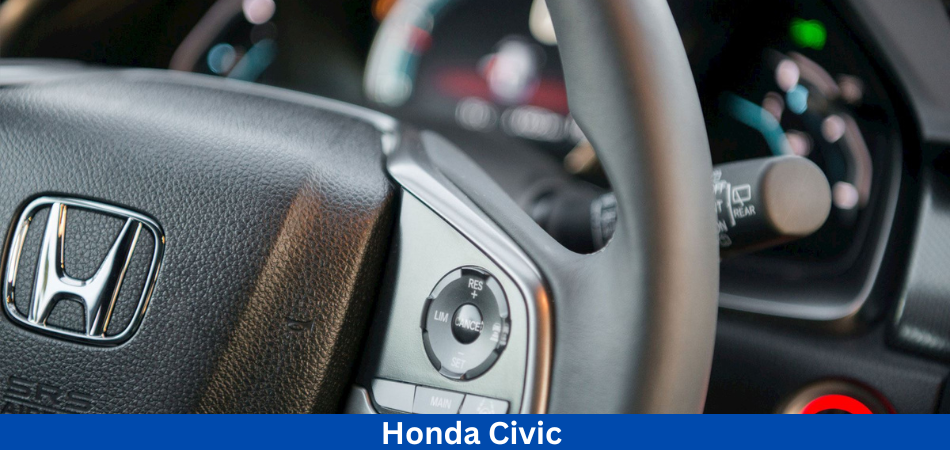
Why Honda Civic Interior Lights Won’t Turn Off?
Several switches control the interior lights, which controlled by a fuse that covers several items. Try adjusting the interior light switch when the switch refuses to turn off. The brightness of the dashboard display controlled by this switch. When the switch is at its highest level, the lights can turned on. Try reducing the switch to its lowest point to see if the problem resolved.
To hear a clicking sound, open each door, locate the door switch, and press each switch. A clicking sound indicates that the switch has turned off. The switch may need to replaced or repaired if you do not hear a clicking sound, or if you have been adjusting the button for a long time.
Why Honda Civic Hazard Lights Won’t Turn Off?
The hazards on your Honda Civic alert other drivers that your vehicle is stationary. After an accident or if the car breaks down, you may be in a dangerous situation on the road. By staying away from these hazards, other drivers can prevent accidents from occurring.
There is a possibility that your hazard lights are not turning off due to a broken connector on the hazard switch. It may be that the switch is experiencing a short. Make sure a mechanic tests the control to determine whether it needs to repaired or replaced. The hazard lights can turned off by pressing the reset button under the dash.
Why Honda Civic Tail Lights Won’t Turn Off?
When the vehicle is off, the brake light switch can still engaged, leaving the brake lights on. Most cars have a stopper that disconnects the switch when the brake pedal is not depressed.
Stoppers are normally plastic and can shift or break, leaving the switch connected and the brake lights on. The brake pedal stopper located on top of the pedal, and you should always keep it in place.
To fix this, press the brake pedal to gain access to the switch and press the brake light switch button. The switch needs to replaced if it doesn’t work.
In addition to removing the battery, you can also remove the charger. A stopper that does not engage the switch is causing the tail lights to turn off; therefore, it needs to replaced. If you need a temporary fix, you can improvise an object the same size as the stopper and fix it there. Up until you replace the stopper, which shouldn’t take long, this should keep you going.
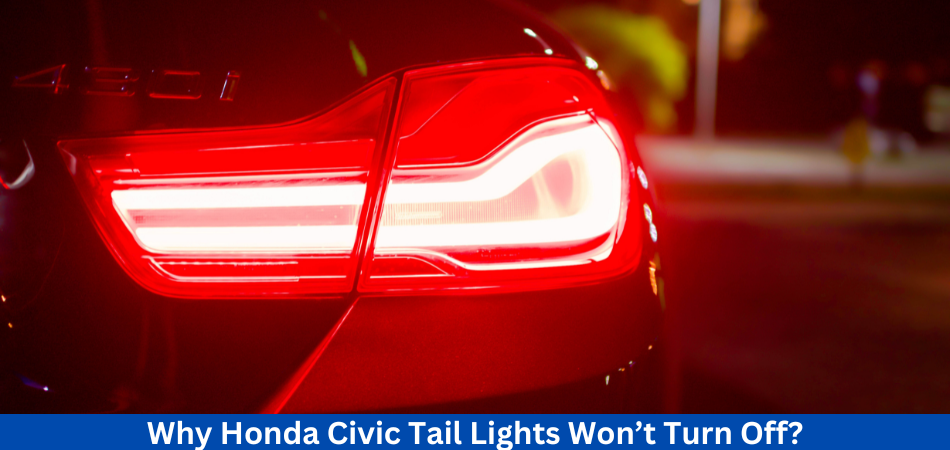
Why Honda Civic Dome Lights Won’t Turn Off?
The dome lights in your Honda Civic should turn on when the door is opened and off when the door closed when they are properly installed. There may be a problem with the switch if the dome lights don’t turn off.
Each door has multiple switches for operating the dome lights. The main knob located on the dashboard, to the left of the steering wheel. Make sure you remove the bulb to prevent the battery from drained. As long as the car inspected by a mechanic, this should last.
To loosen the screws, remove the bulb, then use a screwdriver (most require a Phillip’s head, but some require a flathead). There may be a clip you can slide a flathead under; pry it off gently, set the faceplate to the side, and unscrew the bulbs. During this process, make sure your car is off.
Conclusion: Brake Lights Won’t Turn Off Honda Civic!
A vehicle’s brake light is an important component, and any issue with it should not ignored. This post explains why brake lights remain on after a car has turned off.
You should remove the battery from your car if your brake lights won’t turn off as a car owner or driver. Due to the issue, the battery is being protected from drained.
Learn more of our article here.
FAQs
How can I turn off the brake lights on my Honda Civic?
The brake lights on your Honda Civic may not turn off for several reasons. To help you troubleshoot the problem, let’s examine some common FAQs.
Why won’t my Honda Civic’s brake lights turn off?
To diagnose and possibly fix this issue, you can take several steps. Troubleshooting FAQs include the following:
Are the brake lights on because of a stuck brake pedal?
The brake lights can stay on if the brake pedal is stuck or misaligned. The brake light switch may remain engaged if the brake pedal does not return to its resting position properly.
Is the brake pedal stuck or misaligned?
Make sure the brake pedal returns to its normal position after you release it. It might be stuck or misaligned if it doesn’t. It may be necessary to inspect the pedal and the mechanisms surrounding it for obstructions or problems.
Could a faulty brake light switch be the problem?
Brake lights that will not turn off are often caused by a malfunctioning brake light switch. Pressing and releasing the brake pedal turns on and off the brake lights.
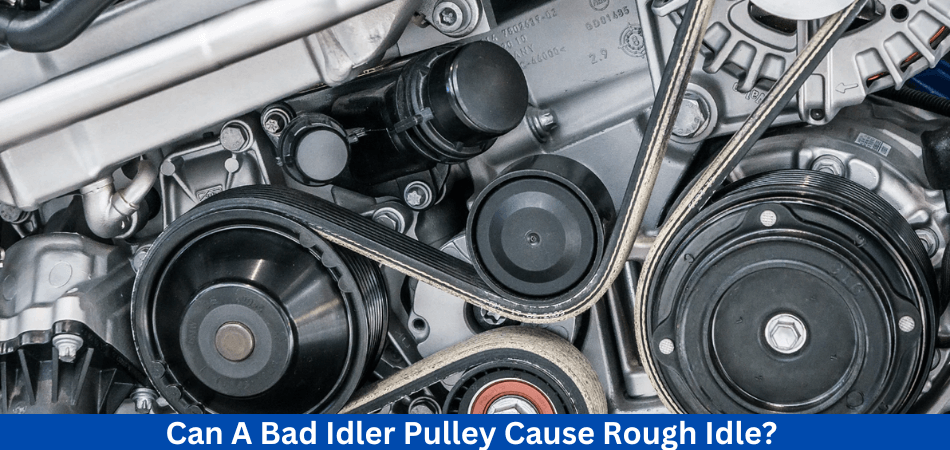
A vehicle’s engine drive belts depend on idler pulleys or engine pulleys. Engine drive belts are guided by idler pulleys through different major components. But Can A Bad Idler Pulley Cause Rough Idle?
Having idler pulleys makes it easier for the engine belt to loop around all the components in the correct direction. Thus, a bad idler pulley will affect the AC compressor, water pump, alternator, and power steering pump of your vehicle.
Over time, idler pulleys tend to fail and should be replaced as soon as possible. But how do you know if you have a bad idler pulley and Can a bad idler pulley cause rough idle? Here are the symptoms that indicate a faulty idler pulley so you can take proactive measures.
Where is the Idler Pulley Located?
Idler pulleys and belts are located near the front of the engine. The belt will rotate along with the engine. If you look at the serpentine belt moving on the engine, you can see the idler pulley.
Most vehicles have one idler pulley, but some have more depending on the configuration. The idler pulley’s tension is set by its position on the rail-type mount that tightens it. Some idler pulleys, however, use spring tension instead.
What are the Functions of an Idler Pulley?
You have several drive belts or a serpentine belt on your car engine that run all of its accessories. A/C compressor, water pump, alternator, water pump, and power steering pump are some of these accessories. These belts can, however, interfere with other parts if not kept in place.
All drive belts guided by the idler tensioner pulley. All of the accessories must routed around the belts. The idler pulley ensures a smooth rotation of the belts, ensuring the proper operation of your vehicle.
It is likely that the idler pulley will operate normally for many years – even for the life of the vehicle – but if it has been abused for many years, it will eventually wear out. It will cause strange noises and other issues with the drive belts if the idler pulley becomes too damaged.
Should The Idler Pulley Spin Freely?
There should be no restriction on the idler pulley’s rotation. Often, idler pulleys used in drive systems to provide tension to belts, chains, and cables. This allows the belt/chain/cable tension to remain uniform and consistent during operation when the idler pulley is able to spin freely.
As a result of the idler pulley not spinning freely, the tension can be uneven, resulting in premature belt/chain/cable failure. A non-spinning idler pulley should addressed immediately as it could lead to serious damage if left unattended.
It is crucial to inspect the pulley regularly and replace any worn or damaged parts as needed.
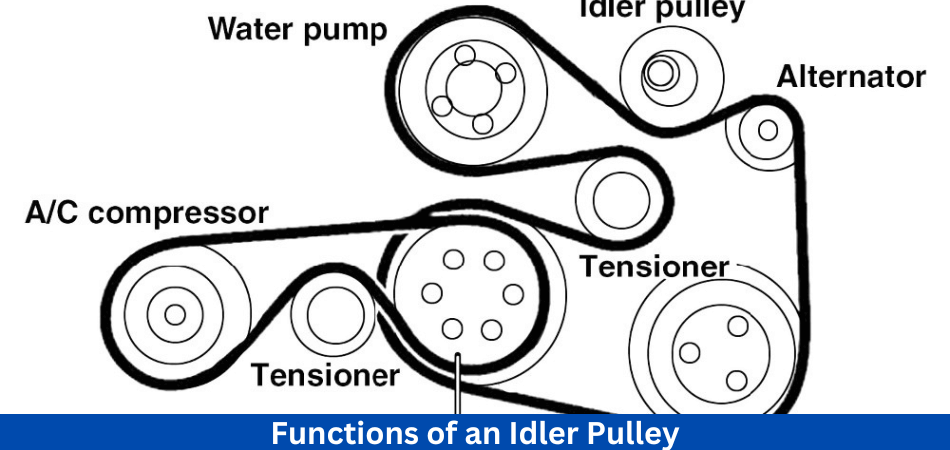
How Many Pulleys Does An Engine Have?
In this article, we have covered the basics of pulleys and idler pulleys. Idler pulleys hold tension on the drive belt and transfer rotational energy from the crankshaft to other accessories. As a result, idler pulleys do not produce or waste energy. Through the different components, it simply transfers energy.
Have you ever wondered how many pulleys and idler pulleys are inside the engine bay? These terms can sometimes be confusing for people, so let’s go into more detail about them.
Crankshaft pulleys are the biggest pulleys inside engines. On most blocks, this pulley can found in the center.
Alternators are the second most important component. It powers the alternator, which is the component that generates electricity and charges the battery and powers the cabin’s accessories.
Lastly, there is the AC pulley that powers the air conditioning system in the car. The power steering system is also powered by a pulley. The last is probably the water pump. There are pulleys on all of these components. However, the crankshaft, which centered in the engine, is the main power source.
We mentioned pulleys that create energy, and some components use this rotational energy by using these pulleys.
How Long Do Idler Pulleys Last?
Let’s move on to more specific stuff like how long these components last under normal conditions now that we’ve covered the basics.
Because idler pulleys are constantly exposed to attrition, they wear out over time as well. Approximately 50,000 to 100,000 miles pass before they fail and break down.
Despite these wide margins, their life spans depend on your driving skills and maintenance habits. Furthermore, you need to account for the fact that idler pulleys don’t wear out immediately, but rather gradually lose performance over time.
What are the Symptoms of a Faulty Idler Pulley?
It is not surprising that these pulleys wear after prolonged use since they are either metal or plastic. If the idler pulley is faulty, you may notice some of these signs.
1. Squealing
The fact that this is not an easy symptom to ignore may be a good thing. The squealing noise coming from under the hood is enough to make you change your morning plans and drive to the mechanic right away.
When the surface of the pulley worn and not smooth, squealing will occur. It is generally caused by too much, unwanted friction on a surface where things should move smoothly. Due to the continued movement of the belt, it repeatedly rubs against the surface.
It is also possible that the noise caused by faulty idler pulley bearings. The base of the pulley supported by bearings that allow it to rotate smoothly. This may lead to other noises like rumbling and cluttering.
2. Visible wear
Whenever a pulley used over time, especially when it makes squealing noises, there are always visible signs of wear on its surface.
Nevertheless, you would only be able to identify this symptom if you regularly inspect parts of your engine even when nothing is wrong. It is important to know where the idler pulley located first. As a second step, you would need to know how its surface looked when it was brand new or relatively good condition. By doing so, you will be able to tell when it needs to replaced. The surface of the pulley should be free of scuff marks or scorching. It is likely that the belt will also show visible wear.
3. Frozen pulley
The idler pulleys rotate smoothly on their shafts thanks to ball bearings. A problem with these bearings could cause the pulley to stop rotating altogether or to continue rotating but with rough resistance. Pulleys like this frozen.
The belt needs to removed from the idler pulley if the pulley is frozen. To prevent anyone from turning on the engine, make sure the engine is off and the keys are not in the ignition before starting. Spin the pulley a few times with your hand without the belt on and observe how it moves. The spin should be smooth. The pulley probably needs to replaced if it doesn’t.
4. Belt travel
If The belt moves smoothly along the system when the car is at idle. In the event of significant deterioration of pulley hardware, the belt will move from side to side. If you move it, you’ll notice that it wobbles or shakes. There is a loss of tension in the belt, which prevents it from maintaining the required tension. It can partially or fully push the belt off the pulley if belt wobbling continues for some time.
There are times when the middle groove on the pulley’s surface widens. In spite of the fact that the belt continues to move, it destabilized.
5. Damaged bracket
An idler pulley mounted on a bracket. Sometimes, the idler pulley and bearings are fine, but the bracket on which it mounted is warped or has come loose. A bracket can come loose due to excessive vibration, which loosens the bolt holding it in place.
For the idler pulley to function properly, it needs a stable mount. The belt could fall off the pulley if the mount is unstable. It is easy and quick to tighten a loose bracket bolt.
6. Power steering problems
Power transmitted from the engine to other components via the idler pulley. The power steering pump is one of them. When there is a problem with the pulley and belt, steering your car may be challenging. It may be difficult to move the steering wheel from side to side, and in some cases it may be impossible.
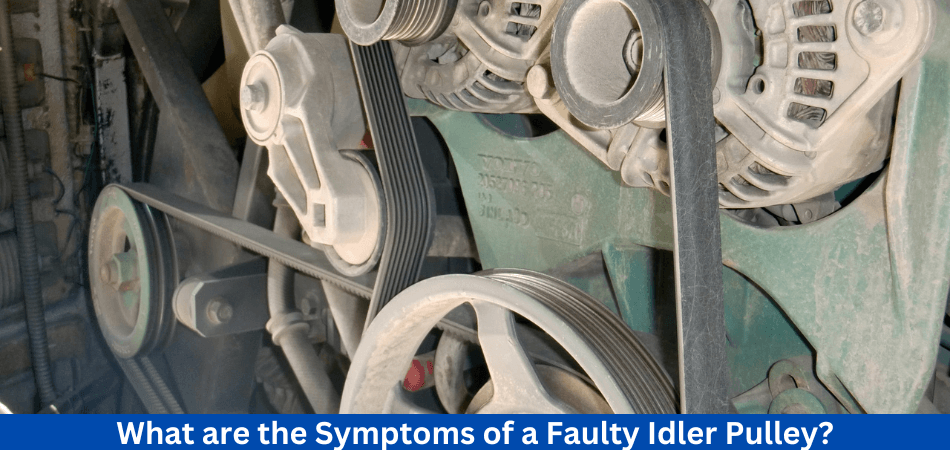
What Does It Sound Like When A Tensioner Pulley Is Bad?
There are several different noises that can produced by a bad tensioner pulley. Squealing sounds, high-pitched whines, or ticking sounds may heard depending on the degree of damage. It may also make a grinding or rattling noise if the pulley is completely worn out.
The pulley may also whine if the bearing inside it fails. The tensioner pulley is essential for the serpentine belt to transfer power to other parts of the engine, so it should diagnosed and replaced if necessary.
A bad pulley can cause further damage to the belt and other components if it is not replaced.
How To Diagnose A Bad Idler Pulley?
We learned what an idler pulley is, why it fails, and the symptoms of its failure in What Are The Signs Ofything. A pulley problem can cause a number of symptoms, as we noted earlier.
Often, when these pulleys worn out or broken, they make a whining noise. When you press on the gas, they like to wobble and play.
As a result, this is a good test to determine if a pulley is bad. Put the gas pedal to the floor and start the car. See if any pulleys move the belt in and out when under heavy load. You can use this method to determine if a pulley broken. Another way is to perform a visual inspection.
You can also pull it off in another way. The screwdriver used for this purpose. You will need a plastic bottle and a long screwdriver to accomplish this.
With the screwdriver, connect the threads of the plastic bottle by cutting it in half. Next, start the engine and follow the following steps for a successful operation.
It is necessary to stick the screwdriver against all of these components with pulleys. Don’t put it on the belt, you don’t want to hurt yourself.
If An unpleasant sound will created by a bad pulley. This plastic bottle simply amplifies the sound produced by the pulleys. As a result, you may hear some strange noises if they are bad. What is the best way to replace one?
How To Replace An Idler Pulley?
Idler pulleys can replaced in half an hour and are dead easy to replace. If you have already diagnosed the problem, it is not a difficult task. To remove the idler pulley, you will need a ratchet or a wrench with a proper socket, a new idler pulley, and a pulley tensioner bar.
If you want to remove the pulley, you will need to remove the belt tension. Next, you replace the pulley, which is the next step.
The new part mounted after this and the tension restored to the belt. In general, it was a simple task. We have attached a video that shows how this process done correctly in a few minutes. How much will this job cost in total? The next chapter will elaborate on this.
What are the Replacement Cost of Idler Pulley?
The average cost of replacing an idler pulley varies between $70 and $250, depending on the car model and labor costs. The idler pulley will cost you $40 to $100, and the labor will cost you $30 to $150.
Prices will vary depending on the type of vehicle you drive, how easy it is to install, and local labor rates. Additionally, auto repair shops may charge different taxes and fees.
It is possible to save on labor costs by replacing the idler pulley yourself. Replacing an idler pulley doesn’t require specialized tools and isn’t difficult.
Even though replacing an idler pulley is not an expensive job, some people put it off. Ignoring this low-cost replacement is a bad idea because it could lead to something much worse. The idler pulley is responsible for driving the engine drive belts. The longer you wait, the more likely you are to encounter future problems.
Under the hood, you should always listen for noises. It is important that you resolve the issues before the sounds become louder and worse. You can avoid costly repairs if you replace the idler pulley at the first sign of wear.
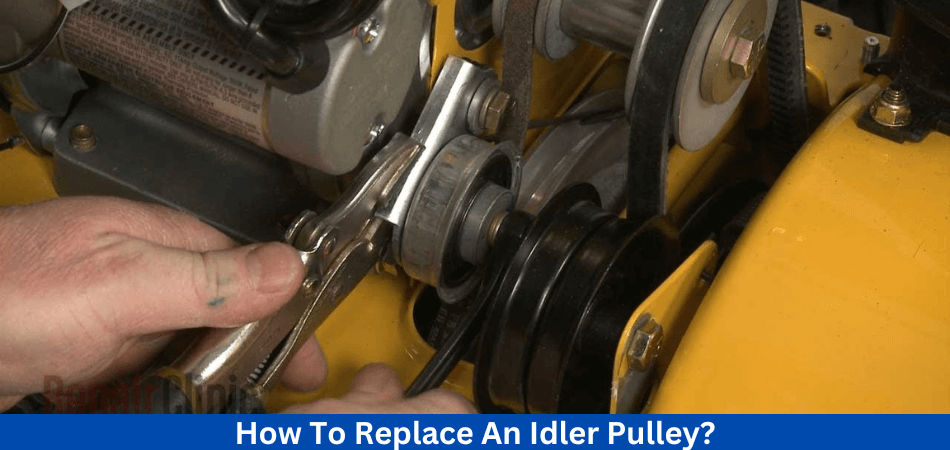
How Long You Are Safe To Drive If The Idler Pulley Is Failing?
Now that we know the symptoms, Let’s see how long you can drive your car with a bad idler pulley.
Since we are talking about a very long period of time and a margin of almost 50,000 miles, this is a tricky question. However, one thing is clear. A 100% damaged pulley will prevent the belts from moving and the car will stop or not be able to start.
There is a gray area between the time you notice the first signs of attrition and when you need to drive your car to a mechanic.
The general recommendation is to replace the broken parts as soon as possible if not immediately. Certain components, like clutches, degrade more predictably and don’t cause problems that bring the vehicle to a complete halt. Although it’s annoying to have to release the clutch pedal a bit more before the engine catches up, it’s not dangerous.
There is a completely different story when it comes to idler pulleys. In some cases, you can safely drive for tens of thousands of miles before performance drops. One slip of the belt is all it takes for the engine to lose momentum and for you to lose control.
Therefore, extreme caution is more than recommended.
Can A Bad Idler Pulley Cause Rough Idle?
Can a bad idler pulley cause rough idle? The answer is “No”. An idler pulley maintains the tension on a serpentine belt only. Other than having a similar name, idler pulleys, and loose tensioner arms have nothing in common with engine idling.
When your idler pulley fails, your car can experience a number of problems. In order to keep your car’s accessories running properly, the pulley maintains tension on the serpentine belt.
If the pulley is malfunctioning, the belt can start to slip, preventing the accessories from functioning properly. As a result of the slipping, the belt itself can damaged and worn.
In general, a squealing sound coming from the idler pulley when the car is running is a sign of a bad pulley. The idler pulley may also be gritty or rough in parts if it is going bad, which can detected visually.
Regardless of the case, it is important to replace the idler pulley as soon as possible to prevent any further damage to the belt or the accessories it drives.
Does A Bad Idler Pulley Affect Performance?
It is true that a bad idler pulley can affect performance. As a result, the idler pulley controls the amount of effort other components (such as the alternator and water pump) must exert to rotate the serpentine belt.
If A worn or broken idler pulley is unable to provide the correct tension, the rest of the system will have to work harder. Additional strain can cause components to work inefficiently, resulting in a reduction in performance and fuel economy.
In addition, if the idler pulley is not functioning properly, the serpentine belt may eventually slip off, leading to expensive repair costs.
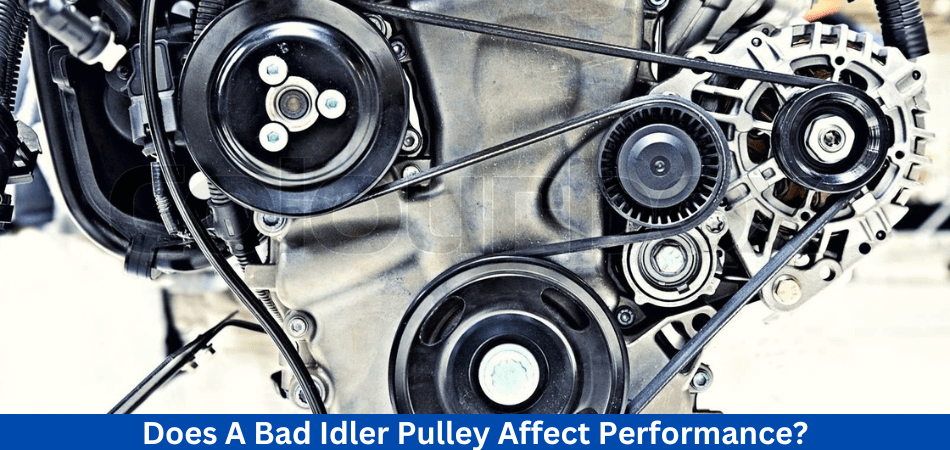
Can A Bad Idler Pulley Drain the Battery?
Bad idler pulleys can drain batteries. Insufficient voltage and current can result from a bad idler pulley, causing the alternator to fail. A charging system with insufficient voltage can increase the battery’s electrical draw, resulting in a drained battery.
As well as keeping a vehicle running efficiently, idler pulleys are also important for battery maintenance. An idler pulley that squeals or grinds should replaced, and the battery should tested for charge if it shows signs of wear and tear.
A drained battery should replaced as soon as possible to ensure the vehicle’s electrical system is properly charged and powered.
Can A Bad Pulley Cause Acceleration Problems?
You can experience acceleration problems if you have a bad pulley. Pulleys play a vital role in the performance of the vehicle’s engine, so a faulty one may result in a lack of acceleration.
When a pulley malfunctions, the belt it guides can slip off, which reduces ignition timing, resulting in less power produced by the engine. Alternators, power steering pumps, and air conditioning compressors can also be negatively affected by slipping and skipping belts.
As a result, if a pulley worn out, it may not line up with other components, causing the belt or other components to move out of place or travel at different speeds or angles, resulting in an inefficient belt and slow acceleration.
It may be necessary to replace the pulley in some cases to resolve the problem.
Conclusion: Can a bad idler pulley cause rough idle?
Now you can answer the question “Can a bad idler pulley cause rough idle” The idler pulley may not be one of the most well-known car components or the most common source of headaches for drivers. However, they are essential for smooth engine performance, and if one fails, the vehicle will not start.
It is indeed the devil in the details, and you should leave nothing to chance. Be on the lookout for the signs of attrition we gave you and act as soon as possible. The squealing noise under the hood is a definitive sign that you should stop driving around and replace the broken pulley if you cannot repair it right away.
Find more of our blogs here.
FAQs
How does an idler pulley relate to a vehicle’s engine?
An The idler pulley plays an important role in maintaining proper tension on a vehicle’s serpentine belt or drive belt. Rather than powering any accessories, it guides and maintains tension in the belt that drives the alternator, power steering pump, and air conditioning compressor.
Why is a rough idle in a car a problem?
When a vehicle is at a standstill, rough idle refers to an irregular or uneven engine idle speed. Symptoms include engine vibrations or fluctuations in RPM (revolutions per minute). In addition to being a symptom of various underlying problems, rough idle may indicate a problem with an engine’s performance or other components.
Is it possible for a bad idler pulley to cause a rough idle in a vehicle?
A bad idler pulley can cause a rough idle in a vehicle. Serpentine belt tension can be improper if the idler pulley fails or malfunctions. In turn, this may affect the performance of engine-driven accessories, such as the alternator and power steering pump.
What are the Symptoms of a bad idler pulley?
Bad idler pulleys are often characterized by unusual engine noises, visible damage or wear on the pulley itself, and irregular belt wear. The idler pulley may need to be replaced if these symptoms occur.
Is my vehicle’s idle rough because of a bad idler pulley?
The idler pulley can be the source of a rough idle for a variety of reasons. It is possible to test an idler pulley for damage or wear by inspecting it and listening for unusual noises coming from the engine area. If the problem cannot be accurately diagnosed, it’s best to consult a mechanic.
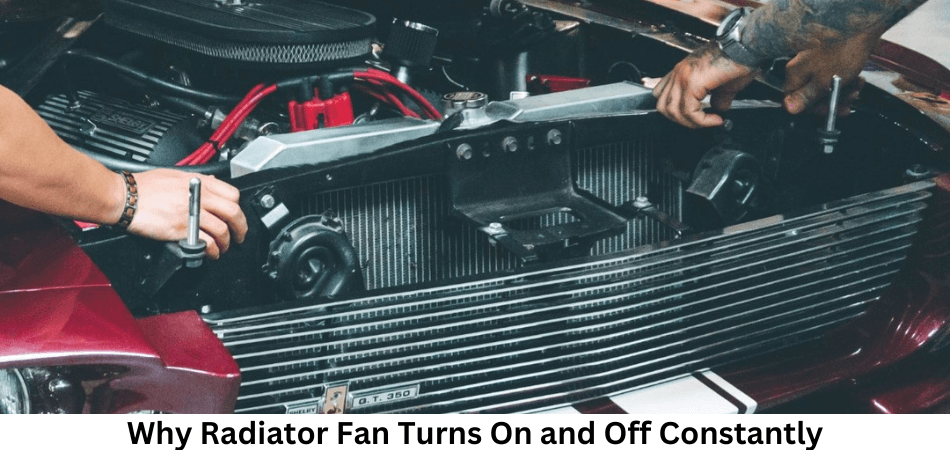
It is crucial for the proper functioning of your car’s radiator fan. Your car’s components are protected from overheating by this device. It’s natural to feel concerned when it suddenly turns on and off. But Why Radiator Fan Turns On and Off Constantly?
If your radiator fan is constantly turning on and off, this may be an indication of a problem. In order to dissipate heat, the radiator fan draws air through the radiator. There may be an underlying issue that needs to addressed if it operates erratically.
A radiator’s purpose and function will explained in this article. We will also explain Why Radiator Fan Turns On and Off Constantly under normal circumstances. We’ll conclude by helping you determine whether your radiator fan going on and off is a sign you should troubleshoot your car.
How Does a Car Radiator Work?
The internal combustion engine of your car allows it to move around. The internal combustion engine generates heat by generating energy. Car radiators prevent dangerous levels of heat from being generated by your engine.
Overheating of your engine prevented by a car radiator. To transfer heat from the engine to the surrounding atmosphere, it uses the principle of convection. In order to operate, the radiator relies on a complex system of thermostats, coolants, and fans.
It is not necessary to worry if your car’s temperature increases. In some cases, however, high temperatures can damage the internal components of your vehicle. It is here that your car’s radiator comes into play.
Understand car heat generation
In order to understand how your car’s radiator works, you must first understand how it generates heat. Your vehicle runs on an internal combustion engine.
If A piston moves inside a cylinder in an internal combustion engine. Combustion gasses pushed into the cylinder, which moves the piston, which drives your car’s complex gear system. As a result of this process, a lot of energy generated, and when there’s enough energy in one place, it heats up.
A car engine’s temperature should be between 195 and 220 degrees Fahrenheit (91 to 104 degrees Celsius). Your thermostat activates the radiator fan when the engine temperature exceeds that level.
Radiators release liquid coolant and water that absorb heat
When your radiator activates, liquid coolant and water released. Coolant and water play a crucial role in keeping liquid from entering your engine. Before returning to the radiator, both absorb excess heat from your engine.
Radiators transfer heat away from engines
A radiator’s fan cools the heated coolant and water once they return to the radiator. This process transfers heat from the engine to the air outside the vehicle.
When the job is complete, the radiator turns off
As soon as your engine’s temperature drops below a defined threshold, the coolant’s heat dissipates into the atmosphere. When this happens, the radiator fan will shut off, and the radiator will stop pumping coolant. A similar cycle will repeat if the engine’s temperature reaches a critical level again.
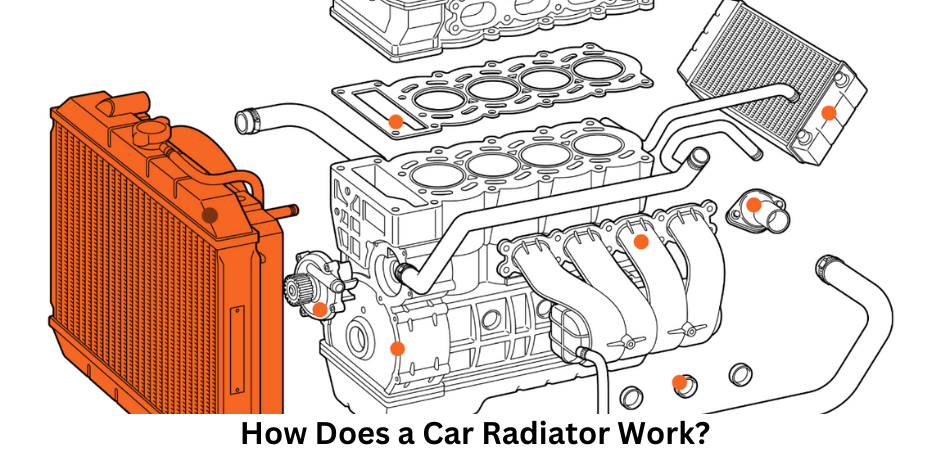
What Are the Signs That Your Radiator Fan Is Working Properly?
In Most of the time, a car radiator fan turning on and off isn’t a cause for concern. If anything, it’s a sign that the radiator is functioning properly. Without your knowledge, your car will overheat and be damaged.
In the absence of other signs of damage, you will be able to tell whether the car radiator fan is working properly. Your car radiator fan is safe to drive if there is no smoke coming from underneath the hood or the engine temperature gauge does not reach “high.”
On On the other hand, your radiator fan may turn on and off when something is wrong with your car. If that’s the case, how do you know? You’ll learn how to tell if your car radiator isn’t working correctly in the next section.
When your car radiator turns on and off, there’s a problem with it. The proper way to fix your radiator depends on what’s wrong with the vehicle, so it’s important to recognize these signs.
- Symptoms of a malfunctioning car radiator include:
- Despite high temperatures, the radiator fan does not turn on.
- There is no way to turn off the radiator fan, so it remains permanently on.
- The engine of your car is constantly overheating.
- Coolant leaks or does not pump.
Is the cooling fan switch responsible for a fan that keeps going on and off?
Fans that keep turning on and off controlled by the cooling fan switch. The cooling fan switch can fail, causing the fan to turn on and off repeatedly, causing overheating and damage to the engine.
If The cooling fan switch in your car needs to replaced if it is malfunctioning. It’s a relatively easy task that almost anyone can complete.
You will need to open your car’s hood to replace the cooling fan switch. When you open the hood, you will see the fan assembly. There are two wires that attach to the cooling fan switch, which located on the left side of the fan.
The switch should removed from the fan by carefully removing the wires from it. Go to an authorized mechanic if you are not sure you can do this job.
After removing the old switch, install the new one by reversing the steps you used to remove it. You should then close the hood of your car after attaching the wires to the switch. Make sure that the fan is now functioning properly. Mechanics can assist you further if it isn’t.
Are radiator fans controlled by the ECU?
Yes, the ECU controls the radiator fan. A malfunctioning ECU can cause the fan to turn on and off constantly. It can be difficult for drivers to figure out what is causing the problem, which can be frustrating.
A mechanic should inspect your vehicle if you are experiencing this issue. The fan may be turning on and off due to an ECU problem or another issue. You can restore smooth operation to your car by identifying and fixing the problem.
Is it necessary to turn on the radiator fan on a regular basis?
It is recommended that the radiator fan runs every time the engine is running. In addition to keeping the engine cool, the fan also keeps the passengers cool. The engine can overheat if the fan does not come on, which can cause serious damage. When the air conditioning turned on, the fan should also come on. As a result, the air conditioning system runs more efficiently.
Can I check if the radiator fan is bad without removing it from the engine?
It is possible to check if the radiator fan is bad without removing it from the engine. Listening to the fan while it runs can help you do this.
When you hear a high-pitched squealing noise, the fan is probably broken and needs to replaced. You can also check by feeling the air coming out of the fan.
If the air is hot, then it is likely that the fan needs to replaced. The blades of the fan can also checked for damage. The fan should replaced if any of the blades bent or broken.
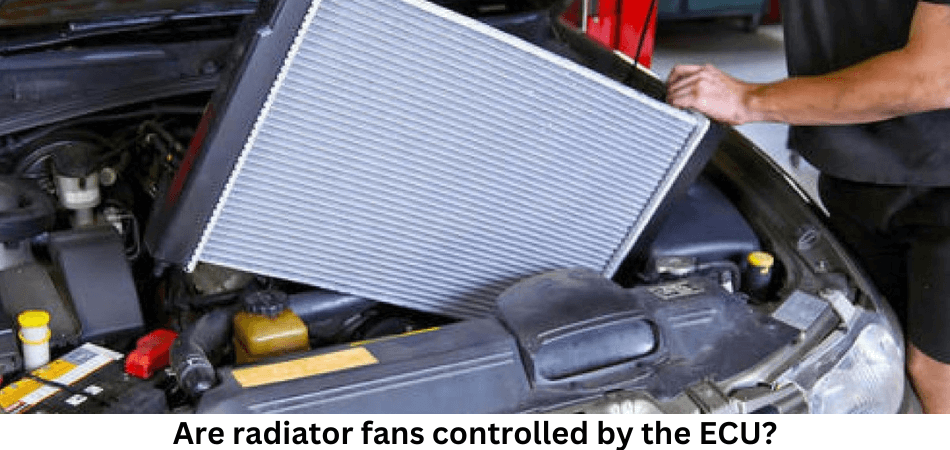
Why Radiator Fan Turns On and Off Constantly?
A Radiator fan dissipates heat generated by the engine and regulates the engine’s temperature. It switches on and off sporadically in its optimum state. It switches on and off sporadically in its optimum state. But Why Radiator Fan Turns On and Off Constantly?
Whenever the engine becomes too hot, the radiator fan kicks on to cool it down, and then it is automatically turned off so that the engine can return to normal. It constantly happens whether the vehicle is moving or static. Radiator fan systems can, however, become faulty quickly, turning on and off at inconvenient times.
Here are some of the most common causes of this error and how to fix them.
1. Problems with the thermodynamic loop
When airflow limited in the vehicle, the radiator fan regulates the engine’s heating. In thermodynamics, the cooling effect called a thermodynamic loop.
The heat generation rate of a car at rest is usually lower than that required for maintaining the refrigerant flow.
However, the temperature fluctuates according to the refrigerant levels in the reservoir and the motion of the vehicle.
The radiator fan maintains a specific temperature range for the coolant when there is poor airflow in the engine.
Solution
A mechanic can determine the source of the problem by checking the thermostat and all the heating systems.
2. A bad fan control module
Each car has its own radiator fan control module, which is usually found in the engine bay. The environment will affected if it is harsh.
The module would wear and rust as a result.
Solution
- Look for physical damage to the relay’s exterior. Make sure the interior is in good condition and that the soldering is not damaged.
- You may be able to repair and then solder these if necessary. There may be a need to replace the module in severe cases.
3. A Bad Thermostat
Radiator fans need a thermostat to remain useful. As well as controlling engine water levels, the thermostat regulates the temperature of the engine. Temperature controllers are prone to damage on their interior frozen parts and exterior springs. By redirecting the radiator fan circulation, such damages could cause ants to freeze. There is a change in cooling effect when a thermostat malfunctions.
Solution
- It is easy and affordable to repair a car thermostat. This will usually solve an overheating problem, saving you the energy and cost of a specialist diagnosis.
- It’s a good idea to change the thermostat once you have updated your car’s air conditioning system.
- As Whenever you update your car’s air conditioner or heater, inspect the thermostat and replace it.
- If Replace your car thermostat as soon as possible if it exhibits poor car thermostat symptoms. The thermostat sensor should also fixed.
- The thermostat may function normally again after using this method.
4. A blown fuse
An automobile’s electrical components protected by fuses. If When an electrical shock strikes a piece of digital hardware, a fuse shuts off the power, preventing it from destroyed. A blown fuse referred to as such.
Solution
- It’s not a huge deal to replace a blown fuse, and it’s not expensive either. Find the radiator fan controller or fan fuse in the owner’s manual.
5. Faulty Coolant Temperature Sensors
In some cars, the radiator fan controlled by a separate fan control module rather than the engine control module. In the case of a faulty coolant temperature sensor, a cold signal will be consistently displayed. The radiator fan activated by this status.
Solution
- The radiator fan’s particular type of control can found in the car’s service manual. Check the sensor’s functionality using a multimeter.
- Consult your mechanic if you have any questions. If you want to know which temperature sensor operates the radiator fan, check your service manual.
- Make sure the sensor works properly by measuring its resistance with a multimeter.
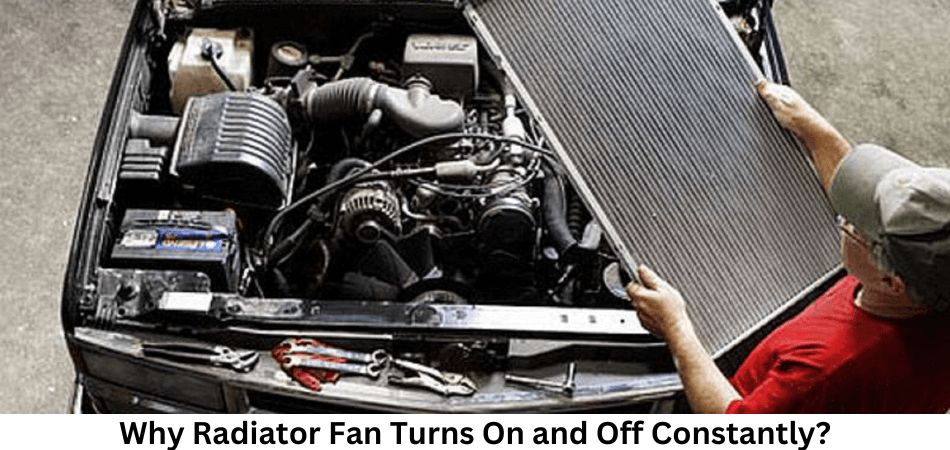
6. A broken wire or connection
Disconnected wires may be causing the fan to turn on and off irregularly.
Solution
- At the control unit and switch levels, inspect the wiring. Make sure the plugs are in good condition as well.
- In order to determine the flow of electricity, the mechanic must measure the cabling with a multimeter. Fix the disconnection’s source.
7. Coolant levels drop below a certain level
Overheating of the engine caused by low levels of coolant. In order to cool the engine again, the radiator fan will turned on. It Maintains the engine temperature by dissipating the generated heat. The radiator fan’s performance will hindered by coolant levels below a cut-off point, however.
Solution
- Keep an eye on the coolant level to make sure it is not depleted. It may be necessary to top up or replace the coolant entirely.
8. A clogged filter
A clogged air filter will cause overheating in the engine due to restricted airflow, causing the radiator fan to turn on and off to reduce the temperature.
Solution
- Make sure the filters are de-clogged or replaced by a mechanic.
9. A broken radiator fan belt
There are times when the fan belt may cut, loosen up, or slag off completely. A snapped belt will prevent the fan from cycling. No Poor air circulation causes cycling to cause excessive heating. A radiator fan that ticks on and off uncontrollably can triggered by this scenario.
Solution
- Belt replacement is necessary.
- Engaged air conditioner compressor
- When the AC compressor engaged, the radiator fan may triggered.
- Radiator fans circulate air within the AC condenser to prevent overheating and enhance its performance.
- Nevertheless, this depends on the type of car and the radiator fan in the engine. There are fewer radiator fans in smaller cars, while there are more in larger cars.
- For cars with one radiator fan, the radiator fan may need to be continuously turned on to keep the AC running.
- It is possible that the AC will not dissipate all of the heat generated if the radiator fan is not turned on.
- As a result of the smaller size and location of the AC condenser, the cooling effect is less than optimal.
- This AC attribute is independent of the car’s motion status. Both moving and static cars operate according to the same principle.
- Despite differences in temperature, the AC set-up maintains almost constant heat circulation. As a result, radiator fans used to cool air conditioners.
10. Faulty Electronic Control Units (ECUs)
A car’s engine powered by its electronic control unit (ECU). To ensure the smooth operation of a car’s electrical system, it regulates the electrical system. An abnormality in the ECU can cause the radiator fan to run uncontrollably. As a result, the radiator fan’s function moderated by the ECU. In order to connect radiator fan problems to ECU problems, you need skills and expertise.
Solution
- Repairing or replacing the ECU is the solution. In contrast to a total replacement, which is capital intensive, the parts and repair of ECUs are costly.
- Due to a lack of skilled professionals in the area, it may be difficult to get an expert to repair or reprogram the ECU. Online repair services are now available from some mechanics.
- Through this method, you can contact an expert. Their workshop receives the ECU.
- It repaired and sent back to you without your physical presence.
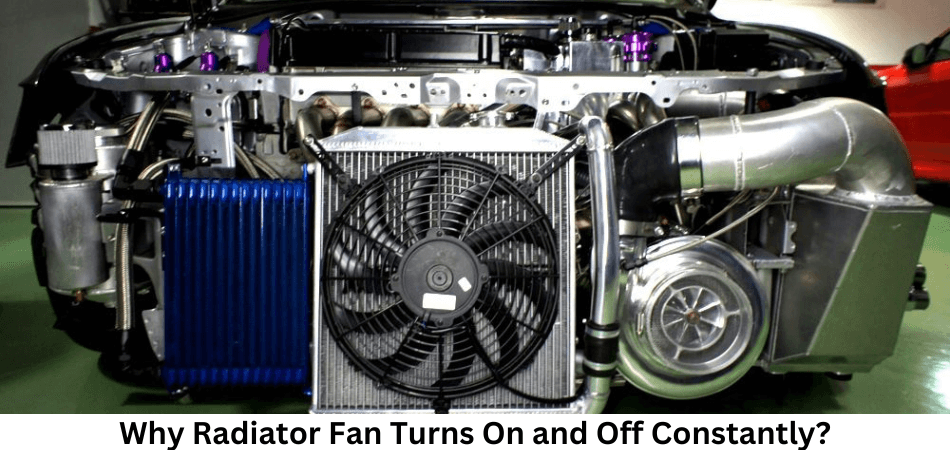
11. Faulty Cooling Fan Switches
In order to regulate cooling effects, the cooling fan switch toggled on or off. Activation of the radiator fan could caused by damage to the cooling fan switch.
Solution
- The cooling fan switch needs to replaced. Check the fan system under the hood of the car first.
- There are two wires attached to the cooling fan switch, located on the left side of the fan. The switch must detached and the wires must be disconnected.
- In reverse order, replace it with the new one while reversing the removal process. It is best to consult an expert mechanic, however.
- A new cooling fan switch will installed by the mechanic after the damaged switch is carefully removed.
- It is mainly the skill of connecting the two wires in the switch correctly that makes a professional.
Solution alternatives
- You may need to manually control the radiator fan’s operation to ensure it runs continuously without errors. The fan controlled by a manual switch.
- Manual switches should located on the ignition switch side, not at the battery connection. Upon turning off the ignition, the fan will turn off.
- Fixing the manual switch, however, may result in the fan running continuously against ignition. Water temperature controlled by the thermostat.
- Repairing a radiator fan that turns on and off is best left to a mechanic. In addition to diagnosing the errors and addressing them appropriately, they trained to fix them.
Can a radiator fan that keeps going on and off caused by a bad thermostat?
An intermittent radiator fan can caused by a faulty thermostat. A malfunctioning thermostat cannot tell when to turn on and off the radiator fan. As a result, the fan may turn on and off constantly, which can be annoying and frustrating.
A professional should check the thermostat to see if it needs to replaced if you are experiencing this problem.
Thermostats are inexpensive to replace, and they can save you money on energy over time. You should consult a heating and cooling specialist if you are not sure whether your thermostat is malfunctioning.
As the engine attempts to maintain a specific temperature, the radiator fan turns on and off continuously. To cool down the engine, the radiator fan comes on when it gets too hot. In order to warm up the engine, the radiator fan comes on when it gets too cold.
How to Maintenance the Radiator Fan?
1. Temperature sensor needs to be checked
The temperature sensor can now tested with a multimeter after the battery has unplugged. You must replace the sensor if it does not conduct electricity and does not establish continuity for the electric current.
2. Make sure the relay switch is working
If It’s time to examine the relay switch now that the temperature sensor is working as intended. Make sure your current switch is working by swapping it out with one that has previously tested and proven to work or by testing its continuity with a multimeter. In this case, you’ll have no choice but to replace it.
3. Make sure the wiring is in good shape
Check all wiring for fraying or corrosion after confirming that the temperature sensor and relay switch are working properly. Make sure loose connections are properly reattached, and if damaged wires need to replaced or repaired, do so as soon as possible. System performance will optimized as a result!
4. Make sure the fan motor is working
If all other components seem to be working properly, the fan motor may be malfunctioning. Testing the fan motor’s continuity with a multimeter recommended, as well as inspecting it physically for any signs of damage or wear; broken blades or worn-out parts are signs that something is wrong and needs to replaced. In the event that your fan motor has become faulty, it will need to replaced.
5. Make sure the engine is not overheating
If In case your radiator fan continues to run after attempting the mentioned solutions, your engine may be overheating. In order to prevent this, check the temperature of the coolant and the condition of the thermostat. Overheating can caused by a number of factors, such as a failed water pump, a blocked radiator, or a damaged thermostat. Your vehicle should be professionally inspected by a mechanic as soon as possible to prevent further damage.
6. Consult a Professional
If you are unsure of your ability to diagnose and repair the issue, you should consult a professional mechanic. Using advanced diagnostic tools, they can easily determine what’s causing the problem and provide effective solutions.
Conclusion: Why Radiator Fan Turns On and Off Constantly
Now you have some idea of Why Radiator Fan Turns On and Off Constantly. Due to the engine’s attempt to maintain a specific temperature, the radiator fan turns on and off constantly.
In order to keep the engine cool, the radiator fan comes on when it becomes too hot. The radiator fan turns on when the engine becomes too cold.
However, this operational mode can become erratic. Occasionally, the fan turns on and off when it should be the other way around.
These errors have well-known causes, but they should diagnosed accurately. The solution is readily available once the cause has identified.
Read more of our articles here.
FAQs
What is the reason for the constant on and off of my radiator fan?
There are several reasons why radiator fans can cycle on and off. The problem is often caused by a high engine temperature and a malfunctioning cooling system. When the engine becomes too hot, the fan should turn on, and when it cools down, it should turn off.
Does the radiator fan cycle on and off normally?
The radiator fan cycles on and off to maintain the engine’s optimal operating temperature. The problem may arise if it happens too frequently or excessively.
What can I do to diagnose the problem with my radiator fan?
Check the coolant level, thermostat, fan relay, and temperature sensor first. Make sure there are no obstructions blocking the radiator or fan, and check for leaks.
Is it possible for a clogged radiator to cause the fan to cycle on and off?
Clogged radiators can restrict airflow, causing the engine to overheat and the fan to run more frequently. The importance of regular radiator maintenance cannot overstated.
Is my radiator fan cycling rapidly a cause for concern?
Your cooling system may be malfunctioning if you experience rapid cycling. Overheating and damage can occur if left unattended. The issue should diagnosed and fixed as soon as possible.















About